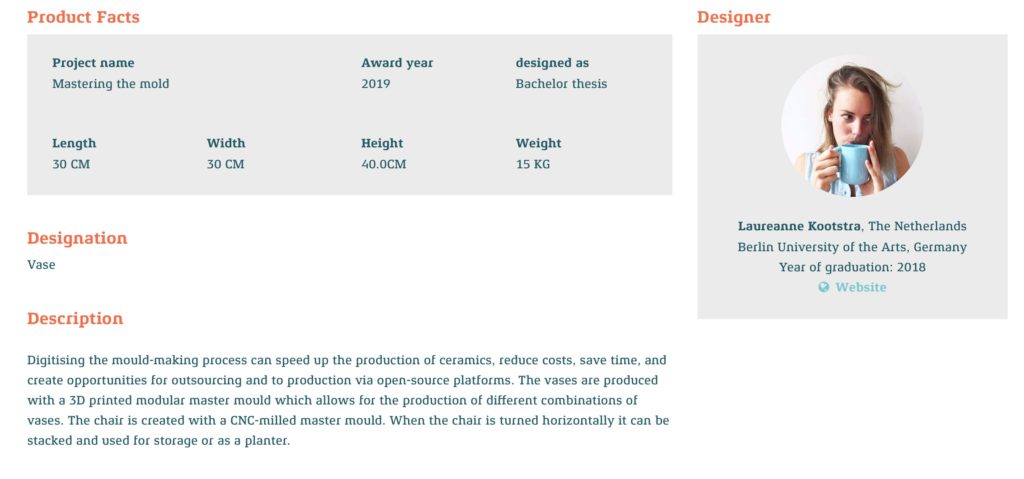

See more, HERE
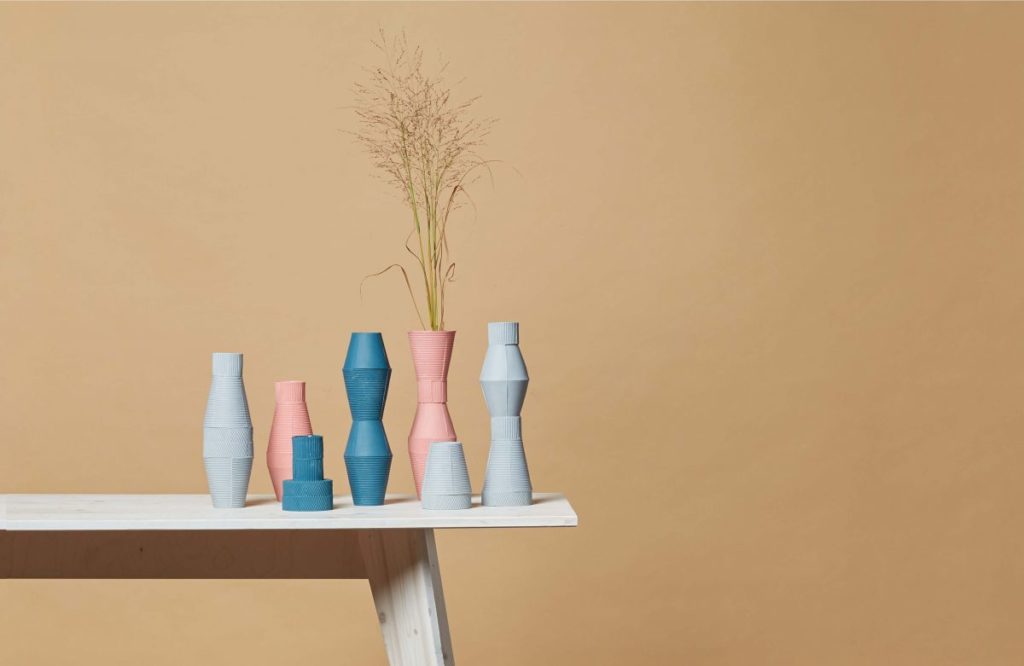
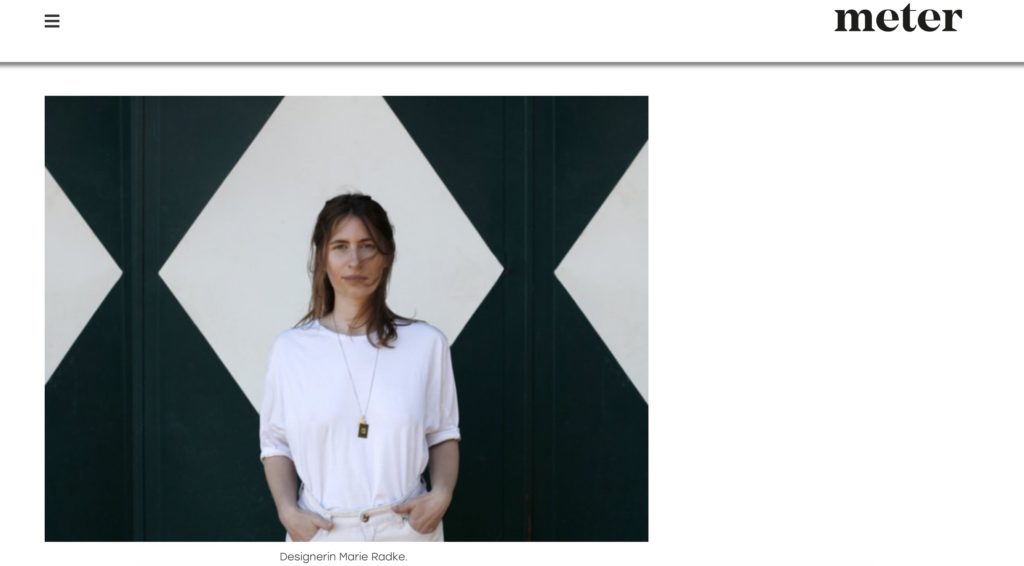

Marie Radke studierte Produktdesign in Berlin. Ihre Arbeiten zeichnen sich durch eine Mischung von humorvollen und innovativen Lösungsansätzen aus. So auch die «Familie Hempel» – eine Hommage an den «Klamottenstuhl». Ein Möbelstück, worauf Kleidung abgelegt wird, die schon getragen wurde, aber noch nicht gewaschen werden muss. Familie Hempel ist eine Kollektion bestehend aus einem Hocker, einem Pouf, einer Bank und einem Hochsitz, an welchen Kleidung spielvoll untergebracht werden kann.
See more, HERE

Baby got Bag! | Bachelorarbeit 2019
BabyGotBag! ist ein innovatives und vielseitiges Baby-Tragesystem, welches das Gewicht des Nachwuchses ideal auf den Körper des
tragenden überträgt und somit dauerhaft eine aufrechte und gesunde Körperhaltung ermöglicht. Die Benutzung ist intuitiv und „kinderleicht“. BabyGotBag! macht das Eltern sein zu einem aktiven Abenteuer, bei dem man den Nachwuchs im wahrsten Sinne des Wortes „auf die leichte Schulter“ nimmt.
BabyGotBag! Is an innovative versatile BabyCarrier system, which transfers the weight of the baby ideally to the body of the carrier.
This allows a permanent upright and healthy posture.
The use is intuitively and extremely easy which makes parenthood an active adventure where you can literally take your offspring lightly.
Betreuer*innen
Prof. Burkhard Schmitz, Prof. Holger Neumann, KM Steffen Herm,
Zine.ria – zinnieren für eine bessere Welt | Bachelorarbeit 2020
Zine.ria ist ein frisch gegründeter Zine-Verlag aus Berlin. Wir gestalten und publizieren Zines: Bunte Hefte, die von selbsternannten Autor*innen hergestellt und in kleinen Auf- lagen veröffentlicht werden. Die vielen unterschiedlichen Geschichten und Visionen, die immer aus der Perspektive der Autor*innen selbst erzählt werden, bieten einen poeti- schen Zugang zu den Themen Stadt und Commons. Es geht hierbei nicht darum, konkrete Nutzungskonzepte für Orte zu erstellen, sondern vielmehr um einen individuellen Blick und die assoziative Ebene der Transformation. Die Zine.ria hat sich am Tempelhofer Flughafen niedergelassen und bietet die Möglichkeit diesen Ort zu erkunden und über ihn zu schreiben, zu zeichnen und zu dichten.
Der Verlag hat sich aus Rücksicht auf die Umwelt auf Online- Zines spezialisiert, veröffentlicht aber auch Zines im Rahmen von Ausstellungen und/oder zu besonderen Anlässen. Zine.ria bietet Workshops an und ist selbst auch eine lernende Organisation. In den Workshops wird kein Wissen patentiert sondern wild weitergegeben. So kann jedes erstellte Zine wieder zu Collage-Material und somit kreative Anregung für neue Zines werden.
Jede*r kann zinnieren und jedes Zine hat seine Nische!
Zineria is a newly founded Zine publishing house from Berlin
We design and publish zines: colorful magazines that are published by self-appointed authors. The many personal stories and visions, always told from the perspective of the authors themselves are creating visions and dreams for public space. The Zineria has settled at Tempelhof Airport and offers the opportunity for sharing thoughts and ideas about that place.
The Zineria has specialized in online zines out of consideration for the environment, but also publishes zines in the context of exhibitions and/or on special occasions. Zineria offers workshops and is itself also a learning organisation. In the workshops no knowledge is patented but wildly passed on. So every created zine can become collage material again and thus creative inspiration for new zines.
Prozess
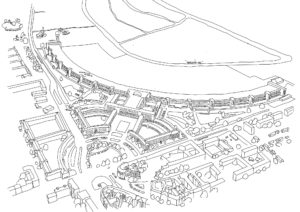


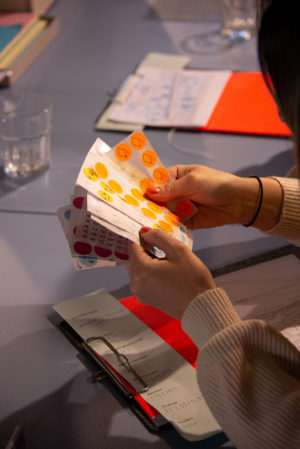
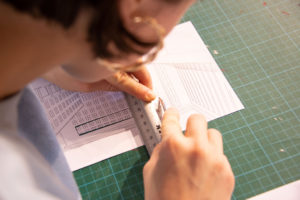


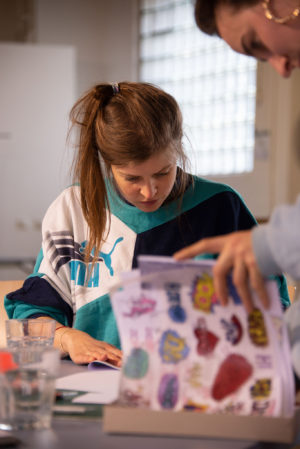
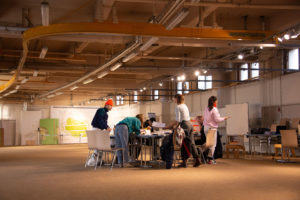
Der Hirsch im Regenwald und der Tukan auf der Eiche | Bachelorarbeit 2020
Ich habe die Zeit der Bachelorarbeit genutzt intensiv in mich selbst hinein zu schauen, um den Katalog meiner Erfahrungen, meiner Fähigkeiten, die Hintergründe meiner Erziehung, den Aufbau meines Wertesystems und somit die Begründung meines Handelns, tiefgründiger kennen zu lernen. Die Herkunft, die Familiengeschichte und ihre gesellschaftliche Positionierung formen und beeinflussen die Methodik des Denkens und Handelns einer Person. Sie prägen ihre Identität. Das Verständnis und das Anerkennen der Individualität ist eine essentielle Grundlage der Schaffenstätigkeit.
Ich bin das Resultat einer bikulturellen Zusammenkunft. Meine Arbeit thematisiert diese Situation und beleuchtet die Eigenschaften aus denen ich bestehe. Ich betrachtete die jeweiligen Erkenntnisse und assimilierte sie. Die Recherche zur Bachelorarbeit beruhte auf der Analyse meiner eigenen Erfahrungen, auf den Gesprächen mit Verwandten und der Auswertung vieler Dokumente, bis hin zur Gegenüberstellung der gesellschaftlichen und geschichtlichen Oberthemen. Es galt herauszufinden, welche besonderen Merkmale in den jeweiligen Ländern und deren Kulturen zu finden sind, in Bezug auf Tradition und Geschichte. Während der Recherche ist ein Raum entstanden indem die Territorialitäten nicht länger getrennt waren. Es sind Verschmelzungen, Widerstände und Zufälle entstanden. Vieles was ich in meiner Recherche lernte und erfuhr begründet die Auswahl, Methodik, und das Resultat meiner Objektkollektion.
Die Objektkollektion behandelt 6 verschiedene Themen. Alle Objekte machen eine persönliche Geschichte oder Erfahrung sichtbar. Das Resultat porträtiert meine individuellen Emotionen über das Interagieren mit 2 verschiedenen Identitäten. Es dient meinem eigenen Verständnis von Nationalität und Herkunft. Entstanden sind Tonarbeiten, Schaumskulpturen, Textildesigns, Farbkompositionen, Malereien, Poesiecollagen, botanische Bilder. Das abschließende Ausstellungskonzept dient der Zusammenführung und ist der Ort, wo Trennungen und Andersartigkeiten zu Harmonie und Einigkeit werden.
I used the time of the bachelor’s thesis to look deeply into myself in order to get to know the catalog of my experiences, my skills, the background of my upbringing, the structure of my value system and thus the reasons for my actions. The origin, family history and their social positioning shape and influence the methodology of a person’s thinking and acting. They shape their identity. Understanding and recognising individuality is an essential foundation of creative activity.
I am the result of a bicultural combination. My work addresses this situation and highlights the properties that I consist of. I looked at the respective findings and assimilated them. The research for the bachelor thesis was based on the analysis of my own experiences, on conversations with relatives and the evaluation of many documents, up to the comparison of the main social and historical topics. The task was to find out what special features can be found in the respective countries and their cultures, in terms of tradition and history. During the research, a space was created in which the territoriality’s were no longer separated. Mergers, resistances and coincidences have arisen. Much of what I learned in my research justifies the selection, methodology, and the result of my object collection.
The object collection deals with 6 different topics. All objects make a personal story or experience visible. The result portrays my individual emotions about interacting with 2 different identities. It serves my own understanding of nationality and origin. The results are clay works, foam sculptures, textile designs, color compositions, paintings, poetry collages, botanical images. The final exhibition concept serves to merge and is the place where separations and differences become harmony and unity.
Die Landschaft in Parana, Brasilien, wird von einer roten Erde geprägt . Wenn es regnet wird der Boden schlammartig und es bilden sich überall rote Pfützen. Am auffälligsten zeichnet sich diese Erde an den Häuserfassaden ab. Diese saugen bei Nässe die Bodenflüssigkeit in ihre Gesteinsschichten auf. Dadurch hat der untere Teil der meisten Häuser eine rote Fläche, die sich nach oben hin verläuft und in die ursprüngliche Fassadenfarbe übergeht. Daraus entstand die Idee des gewebten Wandteppichs. Dieser beginnt als Wandgebilde und wird wie eine Hohlkehle auf dem Boden zu einem herkömmlichen Teppich. Wegen der Form einer Hohlkehle erschloss mir die Idee, den Farbverlauf der roten Erde, aufzugreifen und im Textil aufzuzeigen.
Außerhalb von größeren Städten findet man in der brasilianischen Landschaft viele Termitenhügel. Manche sind mehrere Meter hoch, andere breit und fett, manche schmal, entweder mit vielen kleinen pickelchen oder ganz glatt.
Mir kam die Idee die Termitenhügel als eine Art Sitzkissen / Polster neu zu interpretieren und zu tarnen. Meine Termitenhügel bestehen aus Schaumstoffkernen. Die deckende Oberfläche ist mit der Technik des Trockenfilzens hergestellt. Die Filztechnik erlaubt mir den gewünschten Farbverlauf und die Unruhe der Erde zu kreieren.
The landscape in Parana, Brazil, is shaped by the red earth. When it rains, the ground becomes muddy and red puddles arise. This earth is most striking on the house facades. These absorb the soil liquid into their rock layers when its wet. As a result, the lower part of most houses has a red surface that runs upwards and changes to the original facade color. This resulted into the idea of the woven tapestry. It begins as a wall structure and becomes a conventional carpet like a fillet on the floor. Because of the shape of a cove, I got the idea to portray the color gradient of the red earth in the textile.
Outside of major cities, there are many termite mounds in the Brazilian countryside. Some are several meters high, others are broad and fat, some are narrow, either with many small spots or very smooth. I got the idea to reinterpret and camouflage the termite mounds as a kind of seat cushion. My termite mounds are made of foam cores. The covering surface is made with the technique of dry felting. The felt technique allows me to create the desired color gradient and the agitation of the earth.
Meine Vorfahren haben vor dem 2. Weltkrieg als deutsche Juden im brasilianischen Dschungel Zuflucht vor den Nazis gefunden. Ohne Mittel, ohne Transport- und Einkaufsmöglichkeiten, musste der Hunger unteranderem mit barbarischen Mitteln bekämpft werden. Also kam es dazu, dass mein Opa irgendwann Jagt auf die Papageien der Region machen musste. Ich habe mir vorgestellt wie meine Familie im Dschungel saß und Papageien auf den mitgebrachten Tellern aus gutem, deutschen Meissner Porzellan aßen. Ich habe Porzellanteller hergestellt und ein eigenes Dekor gestaltet, welches die Elemente des Zwiebelmusters aus Meissen mit der Schönheit der Papageien verbindet. Das Konzept beruht auf der kontrastreichen Gegenüberstellung beider Motive.
Before the Second World War, my ancestors found refuge from the Nazis as German Jews in the Brazilian jungle. Without means of transport and shopping, hunger had to be fought with barbaric means. So at some point my grandfather had to hunt the parrots in the region. I imagined my family sitting in the jungle and eating parrots on their German Meissen porcelain plates they brought. I made porcelain plates and designed my own decor, which combines the elements of the „Zwiebelmuster“ pattern from Meissen with the beauty of the parrots. The concept is based on the contrasting comparison of both motifs.
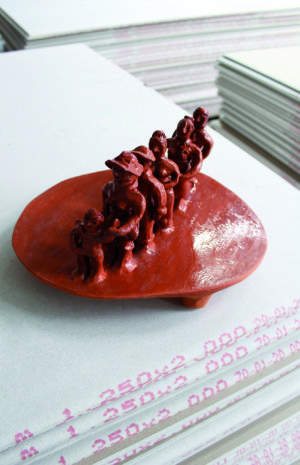
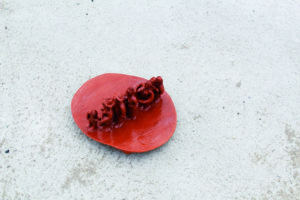

In nahezu jedem brasilianischen Haushalt findet man eine Tonfigur von Mestre Vitalino. Sie fallen aufgrund ihrer Einfachheit, Ursprünglichkeit, der naiven Bearbeitung und der ironischen Interpretation der brasilianischen Gesellschaft angenehm auf. Die Figuren zeigen den Brasilianer in seiner Urform in verschiedenen Tätigkeiten.
Einer der bedeutesten Arbeiten von Mestre Vitalino ist „Retirantes“, auf Deutsch „Flüchtlinge“. Ich erkenne darin eine Analogie zu meiner eigenen Familiengeschichte. Ich wollte mit dem selben Handwerk, Technik und Material von Mestre Vitalino arbeiten und wählte einen ähnlichen rot-bräunlichen Ton aus. Ich zeige 6 Familienmitglieder, jeder Figur habe ich ein Charaktermerkmal gegeben um erkennbar zu machen wer sie sind. Wie bei Mestre Vitalino steht meine Familie hintereinandergereiht auf einer Bodenfläche, die als Schale bzw. Teller genutzt werden kann.
Mein Vater wuchs mit Vorhängen vor den Fenstern auf. Auch in Berlin beobachte ich oft, vor allem dort wo ältere Menschen wohnen, dass die Fenster zugehängt sind.
Ich erarbeitete ein für mich interessantes Textilkonzept, eine Tragfläche für die Erzählung meiner Vorfahren und deren Herkunft aus Wuppertal. Entstanden sind Vorhänge auf denen eine Poesie meiner Uroma gestickt wurde. Das Garn färbte ich mit der Krappwurzel. Wuppertal war einst Industriestadt der Textilherstellung und des Färbens.
A clay figure by Mestre Vitalino can be found in almost every Brazilian household. They attract attention because of their simplicity, originality, naive processing and ironic interpretation of Brazilian society. The figures show the Brazilian in his archetype in various activities.
One of the most important works by Mestre Vitalino is „Retirantes“, in English „Refugees“. I see an analogy to my own family history. I wanted to work with the same craft, technique and material from Mestre Vitalino and chose a similar red-brown tone. I show 6 family members, I have given each figure a characteristic to make clear who they are. Like the work from Mestre Vitalino, my family is lined up on a surface that can be used as a bowl or plate.
My father grew up with curtains in front of the windows. This I often observe in Berlin, especially where older people live, that the windows are closed by curtains. I developed an interesting textile concept, a surface for telling my ancestors story and show their origin from Wuppertal. The results are curtains on which a poetry of my great grandmother was embroidered. I dyed the yarn with the Krapp root. Wuppertal was once an industrial city of textile production and dyeing.
Prozess

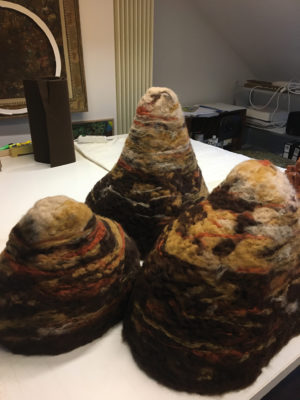
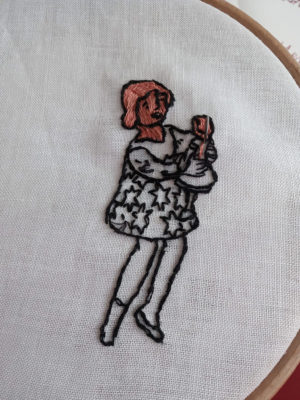
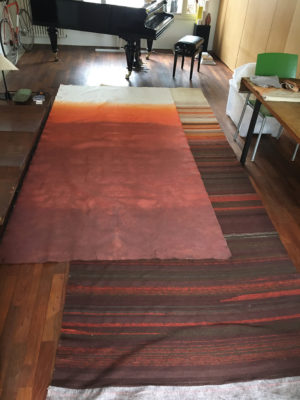
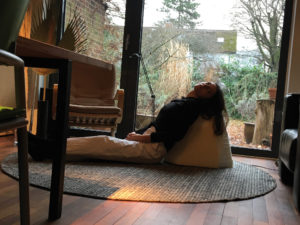
Nalu | Bachelorarbeit 2020
Als MIDI Controller bietet NALU die Möglichkeit, durch die Erzeugung verschiedener Hirnstromwellen mittels Konzentration, einen experimentellen Input zur herkömmlichen Musikproduktion zu schaffen. Die vier messbaren Hirnstromwellen – Theta-, Alpha-, Beta- und Gamma-Welle – bieten sich als Eingabequelle an und können in der Musik-Software, der Digital Audio Workstation, auch ‚DAW’ gennant – verschiedenen digitalen Instrumenten zugewiesen werden. Die Gamma-Welle, die die höchste Form der Konzentration darstellt, kann durch Übungen von jedem Menschen erzeugt werden. Dabei verhält es sich ähnlich wie bei einem Musikinstrument, wie beispielsweise der Gitarre, das man durch regelmäßiges Üben erlernen kann.
Die zwei NALU Controller sind über Bluetooth mit dem Laptop und der Musik-Software verbunden und verfügen über jeweils fünf Bedienelemente, die mit Befehlen verknüpft werden, die Instrumente und Effekte innerhalb der Musik-Software steuern. NALU dient als experimentelles Musikinstrument, das die Musikproduktion mit Hirnstromwellen unterstützt und eine Verbindung zwischen meditativer Konzentration und Klangerzeugung schafft.
As a MIDI controller, NALU offers the possibility of creating an experimental input for conventional music production by generating brainwaves through concentration exercises. The four measurable brainwaves – theta, alpha, beta and gamma wave – are an ideal source of input and can be assigned to various digital instruments and music effects used in a music software – a digital audio workstation also known as DAW. Similar to a regular musical instrument, such as a guitar, it requires regular practice to improve.
NALU connects wirelessly to a computer transmitting measured brainwaves using an EEG headband and translates these to MIDI signals that commence a previously assigned digital instrument within a DAW. Resting your hands upon the controllers only minimal motion is required to activate touch controls assigned to DAW commands such as delay, reverb or similar sound modulations as well as additive sound effects like kick, snare or drums. Throughout the process of brainwave and thereby sound generation one is able to either modulate while concentrating or after recording one of the four measurable brainwaves.NALU is a musical instrument that supports music production using brainwaves and creates a connection between meditative concentration and sound generation.
Prozess
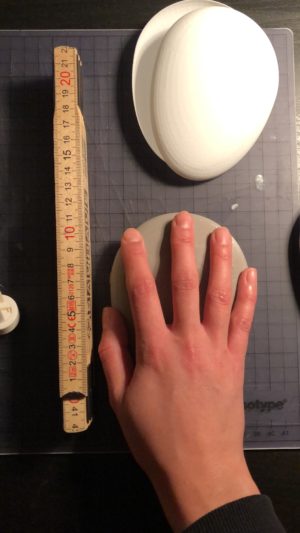


PrüferInnen
Prof. Burkhard Schmitz, Prof. Holger Neumann, KM Antonia Kühne
Relics | Bachelorarbeit 2020
In der Porzellanproduktion entstehen bis zu 40% Ausschussware. Auch im Haushalt geht Porzellan zu Bruch. Da das Material nach dem Brand so eine extreme Härte besitzt, bedeutet eine Wiederverwendung des Mülls einen hohen Energieaufwand. Die meisten Porzellanabfälle werden daher abgelagert und stellen eine Belastung für die Umwelt dar.
Das Ziel dieser Arbeit war, Porzellanabfälle wiederzuverwerten und eine nachhaltige Produktlösung zu finden. Es wurde eine Methode entwickelt, um alte Porzellanscherben durch Mahlen und Versintern wieder zu einem festen Material zu verbinden, das zu 100% aus Rezyklat besteht. Dieses Material bietet Eigenschaften wie z.B. Festigkeit und Porosität, die sich für Behältnisse von Lebensmitteln eignen: RELICS sind Gefäße aus diesem recycelten Porzellan, die eine längere Haltbarkeit von Obst und Gemüse ermöglichen. Ein Einlegeboden saugt durch die poröse Struktur kaltes Wasser auf, indem er unter den Wasserhahn gehalten wird. Wenn dieser dann in das Gefäß gelegt wird, kühlt der Innenraum ab und die Luftfeuchtigkeit steigt. Durch diesen physikalischen Prozess der Verdunstungskälte besitzen die Gefäße einen Kühleffekt. Diese Bedingungen sorgen bei bestimmten Lebensmitteln, wie Tomaten, Äpfeln oder Rüben für eine schonende Lagerung und beeinflussen die Haltbarkeit und Qualität positiv. Außerdem schützt das feuchte Klima in den Gefäßen bestimmte Gemüsearten vor Austrocknung. Wenn der Boden nicht gewässert ist, herrscht ein dunkles, luftiges, trockenes Klima bei Raumtemperatur. Dann bildet das Gefäß eine Lagermöglichkeit für frische Lebensmittel die kälteempfindlich sind, ihr Aroma durch Kälte verlieren oder kurzfristig reifen müssen. Die Behältnisse bieten somit optimale Klimabedingungen, um die Haltbarkeit von Obst und Gemüse zu verlängern und Lebensmittelabfälle zu reduzieren.
Durch RELICS werden Porzellanabfälle recycled, Lebensmittel bleiben länger frisch und eine ressourcenschonende Lebensweise wird unterstützt.
Up to 40% rejects are produced in porcelain production. Porcelain also breaks in the household. Since the material is extremely hard after the fire, reusing the waste means a lot of energy. Most porcelain waste is therefore deposited and is a problem for the environment.
The aim of this work was to recycle porcelain waste and to find a sustainable product solution. A method was developed to recombine old porcelain shards by grinding and sintering to a solid material that is made from 100% recycled material. This material offers properties such as strength and porosity that are suitable for food containers: RELICS are containers made from this recycled porcelain, which enable fruit and vegetables to have a longer shelf life. A tray absorbs cold water through the porous structure by holding it under the tap. If this is then placed in the container, the inner space cools down and the air humidity rises. Due to this physical process of evaporative cooling, the container have a cooling effect. With certain foods such as tomatoes, apples or beets, these conditions ensure gentle storage and have a positive effect on shelf life and quality. The humid climate in the containers also protects certain types of vegetables from drying out. If the tray is not watered, there is a dark, airy, dry climate at room temperature. Then the container forms a storage option for fresh foods that are sensitive to the cold, lose their aroma due to the cold or have to ripen briefly. The containers thus offer optimal climatic conditions to extend the shelf life of fruit and vegetables and reduce food waste.
With RELICS, porcelain waste is recycled, food stays fresh longer and a resource-saving lifestyle is supported.
HiHeel | Bachelorarbeit 2020
In meiner Bachelorarbeit „Hiheel“, setze ich mich mit dem Gedanken auseinander, generische Typologien und Herstellungsweisen von Stöckelschuhen zu untersuchen und diese mit Hilfe der 3D-Druck-Technologie neu zu definieren. Durch diese Arbeit sollen neue Beispiele einer Formsprache und neue strukturelle Möglichkeiten entstehen. Ich wollte schon immer Schuhe herstellen, beherrsche aber nicht das Handwerk des Sattlers oder Schuhmachers, geschweige denn den Zugang zu den benötigten Maschinen und Werkzeugen. Durch 3D-Druck kann ich mir dieses Objekt erschließen und auf meine persönliche Art und Weise denken und gestalten. Die 3D-Druck-Technologie gehört zu den Rapid Prototyping Technologien, also zu den Fertigungsverfahren, die das Ziel haben, CAD-Daten möglichst ohne manuelle Umwege, direkt und schnell in Werkstücke umzusetzen.
In my bachelor thesis “Hiheel”, I deal with the idea of examining generic typologies and manufacturing methods of high-heeled shoes and redefining them with the help of 3D printing technology. This work is intended to create new examples of a formal language and new structural possibilities. I’ve always wanted to make shoes, but I don’t master the craft of the saddler or shoemaker, let alone access to the necessary machines and tools. Through 3D printing I can open up this object and think and design in my own personal way. 3D printing technology is one of the rapid prototyping technologies, i.e. the manufacturing processes that aim to convert CAD data into workpieces directly and quickly, if possible without manual detours.
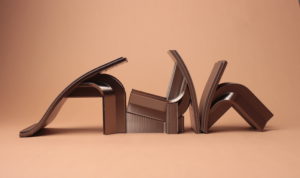
Prozess


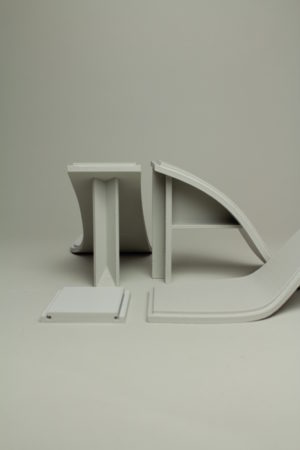
Prüfer
Prof. Holger Neumann, Prof. Achim Heine, KM Gesine Hillmann
Stadt Land Fluss | Bachelorarbeit 2020
In der vorliegenden Bachelorarbeit „Stadt Land Fluss“ habe ich mich dem Thema Boote angenähert und auf die Bootsart des Kajaks eingegrenzt. Angefangen mit einer ausführlichen Produktrecherche über die historische Entwicklung, die generelle Einteilung der verschiedenen Bootsklassen, Nutzungsmöglichkeiten bis hin zu dessen Aufbauten und Attributen. Die daraus wichtigsten Erkenntnisse sind in den Entwurf in zusammengefasster Form ausformuliert und eingeflossen. Das entstandene Faltboot ist insgesamt nur 5,34kg schwer und misst eine Länge von 2,7m. Die Aufbauzeit beträgt unter 3min. Damit grenzt sich der Entwurf deutlich von anderen Faltbooten ab. Durch das geringe Gewicht und der geringen Taschengröße von 50cm x 70cm wird es zu einen Gegenstand des täglichen Gebrauchs.
In the bachelor thesis „Stadt Land Fluss“ I approached the subject of boats and narrowed it down to the boat type of kayak. Starting with a detailed product research about the historical development, the general Classification of the different boat classes, possible uses down to its structures and attributes. The most important findings are included in the draft in a summarised form and incorporated. The resulting folding boat weighs only 5.34kg and measures 2.7m in length. The assembly time is under 3 minutes. This clearly distinguishes the design from other folding boats. Due to the low weight and the small bag size of 50cm x 70cm it becomes an object of daily use.
Mattering Meal Bag | Masterarbeit 2020
Die Meal Bag ist eine essbare Lebensmittelverpackung. Ihre Inhaltsstoffe gleichen denen von Papier, sind aber essbar. Sie ist luftdicht und bis zu einem gewissen Grad gegen Feuchtigkeit resistent. In heißem Wasser löst sich die Verbindung des Stoffs und kann einfach der Mahlzeit beigemischt werden. Da einer ihrer Hauptbestandteile Maisstärke ist, fungiert sie beim Kochen als Soßenbinder. Sie ist wie Brot ein Ballaststoff- und Energielieferant. Die Verpackung wird Teil der Nahrungskette, statt Gefahrgut. Das Material ist essbar, am Heimkompost rückführbar, es verwittert innerhalb kurzer Zeit, lässt sich erneuern und wieder verwerten. Es bietet viele Möglichkeiten den natürlichen Stoffkreislauf zu schließen und trotzdem spontan agieren zu können.
Laut Umweltbundesamt fielen im Jahr 2017 ca. 107 Kilogramm Verpackungsmüll pro Privatperson an. Nur 49,7 Prozent der Kunststoffverpackungen wurden recycelt. Trotzdem scheint es, dass vor allem im Lebensmittelbereich immer mehr Plastikverpackungen verwendet werden. Alternative Shopkonzepte, wie Unverpackt-Läden, sind Wegweiser in einen verpackungsfreien Alltag. Leider lässt sich dieses Konzept für viele Menschen nicht ganz einfach in den Arbeitsalltag integrieren. Es fordert vorauszuplanen und geeignete Behälter für lose Lebensmittel in der Tasche zu haben.
The Meal Bag is an edible food packaging. Its ingredients are similar to those of paper but are edible. It is airtight and to a certain extent resistant to moisture. In hot water the compound dissolves and can simply be added to meals. As one of its main ingredients is corn starch, it functions as a sauce thickener during cooking. Just like bread it is a supplier of fibre and energy. Therefore, the packaging becomes part of the food chain instead of a hazardous material. The material is edible, compostable, it weathers within a short period of time, it can be renewed and recycled. Therefore, plenty of possibilities to a closed cycle of materials are offered while at the same time being able to act spontaneously.
According to the Federal Environment Agency, in 2017 approximately 107 kilograms of packaging waste were accumulated per private person. Only 49,7 per cent of the plastic packaging was recycled. Despite, it seems that particularly in the food sector more and more plastic packaging has been used. Alternative shop concepts, such as zero waste shops offer valuable guidance to a packaging free daily life. Unfortunately, for many people this concept cannot be easily integrated into their everyday working life. It requires advance planning as well as bringing along suitable containers for loose foodstuffs.
Die Meal Bag bietet einen Mittelweg. Sie dosiert, schützt den Inhalt vor äußeren Einflüssen und ist luftdicht. Da sie essbar ist, kann sie beim Kochen, nach dem ersten Gebrauch verwertet werden. Vor dem Verarbeiten wird sie wie Gemüse einfach gewaschen und bildet dann bspw. die Basis für Soßen. Dadurch lässt sich nachhaltiger Konsum auch spontan umsetzen.
Der/die Endverbraucher/in kann entscheiden wie er/sie den Materialkreislauf schließen möchte. Wichtig ist dabei, dass die enthaltenen Bausteine für das Wachstum im Material nach dem ersten Gebrauch zirkulieren können. Das Konzept der Meal Bag kann dazu beitragen das Verhältnis zu Verpackungen weiter zu überdenken und die Wertschätzung Materialien gegenüber zu steigern. Durch sie kann auch das Umweltbewusstsein derer gestärkt werden, die sich nicht die Zeit für Veränderung nehmen können.
The Meal Bag steers a middle course. It dispenses, protects the content from external influences and is airtight. Due to the fact that it is edible, it can be exploited after its first use. Before being processed, it is simply washed, just like vegetables and hence, forms the basis e.g. for sauces. Consequently, sustainable consumption can be implemented spontaneously.
The consumer decides on how to close the material cycle. Important is that the contained components can circulate after its first use for the growth of the material. The concept of the Meal Bag can contribute to a further rethinking of one’s attitude to packaging as well as an increased appreciation of materials. The environmental awareness of those who cannot take the time for change can be increased.
Prüfer
Prof. Axel Kufus, Prof. Holger Neumann, Prof. Dr. Kathrin Busch
Prozess
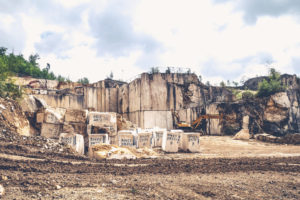
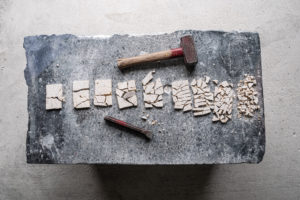
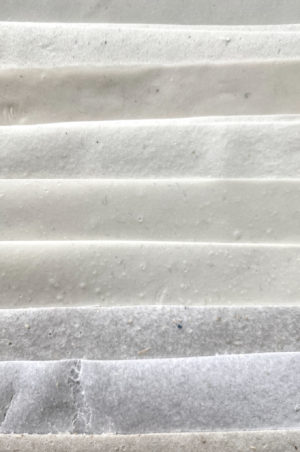

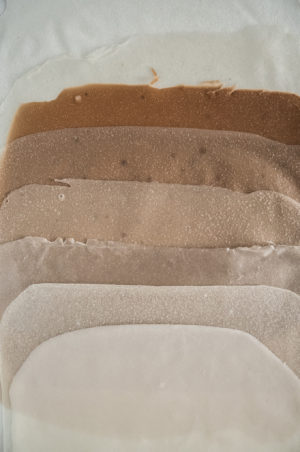


WAYSTE | Bachelorarbeit 2020
Wie kann es gelingen, Abfall als ungenutzte Ressource in den Wertstoffkreislauf zurückzuführen und einen Werkstoff zu entwickeln, der sowohl ästhetisch ansprechend als auch funktional und technisch überzeugend ist? Aus meiner Versuchsreihe WAYSTE, die mit der Verwertung von Obst- und Gemüseabfällen der Saftherstellung begonnen hat, ist MACCHIA entstanden. MACCHIA ist ein überwiegend aus Kaffeesatz hergestellter Verbundwerkstoff, der sich durch seine einzigartige Materialität auszeichnet: eine fein strukturierte Oberfläche, eine intensive dunkle Farbigkeit, hohe Festigkeit und gute Formbarkeit. Darüber hinaus bietet das Material eine angenehme sanfte Haptik und vielfältige Möglichkeiten der Oberflächenbehandlung beispielsweise durch Prägetechnik.
Für MACCHIA werden zu 100% natürliche Rohstoffe verwendet. Vor allem aber nutzt MACCHIA die Ressource Abfall zur Gewinnung eines neuen Werkstoffes und leistet einen Beitrag das stetig wachsende Müllaufkommen zu reduzieren und die Kreislaufwirtschaft zu fördern.
Das Material ist aus einer unkonventionellen Art des Gestaltungsansatzes entstanden. Ziel war es nicht, ein Material mit vorher bestimmten Eigenschaften oder ein klar definiertes Produkt zu entwickeln, sondern einen Werkstoff zu kreieren, für dessen Herstellung ausschließlich ungenutzte Ressourcen wiederverwertet werden.
Vorstellung hierbei ist es, einen interdisziplinären Dialog im Sinne eines materialorientierten Gestaltungsansatzes zu eröffnen, der zu einer Symbiose aus technisch-konstruktiven, funktionalen Materialeigenschaften und sensitiven Qualitäten führt.
Is it possible to create a sophisticated material that merely consists of waste and meets the needs of an aesthetically pleasing, functional as well as technically convincing material?
The idea was to create a material derived from a series of experiments I conducted. The project WAYSTE started with the recycling of fruit and vegetable scraps from juicing.
MACCHIA is a composite material mainly made from coffee grounds, which is characterized by its unique materiality: a finely structured surface, an intense dark color, great sturdiness and good formability. In addition, the material offers a pleasant, soft feel and unlimited surface treatment options, for example by using embossing technology.
MACCHIA is made of 100% natural raw materials. It contributes to reduce the amount of daily waste and advocate the reuse of by-products in a sustainable way.
This material is the result of an unconventional design approach. The aim is not to develop a material with previously defined properties or a clearly defined product. The goal is to create a material that solely consists of recycled by-products.
The intention is to open an interdisciplinary dialogue in the sense of a material-oriented design approach that leads to a symbiosis of technical-constructive, functional material properties and sensitive qualities.
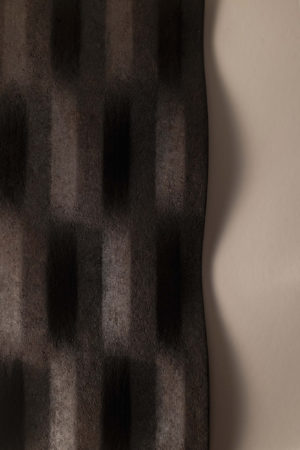

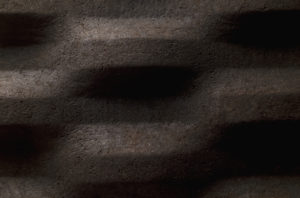

Prozess

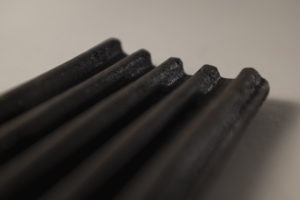
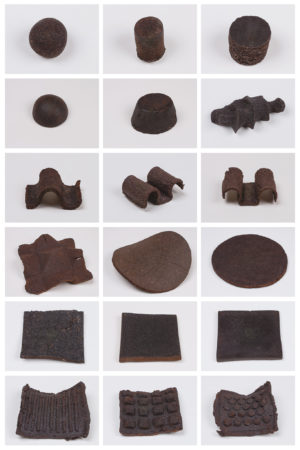

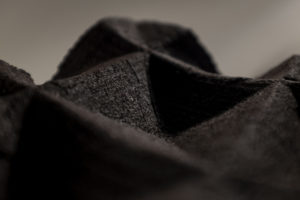
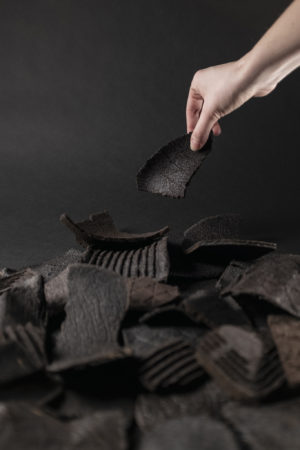
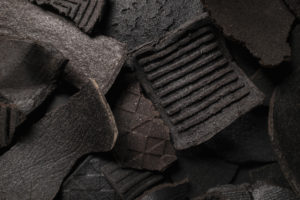
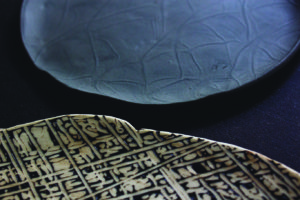
Gravitationen | Bachelorarbeit 2020
“Gravitas” ist der lateinische Begriff für Schwere.Die Schwerkraft ist eine der vier fundamentalen Wechselwirkungen, durch die sich physikalische Objekte gegenseitig beeinflussen. Mittels eines Pendels wurden bereits 1855 komplexe Schwingungsgeometrien, auch bekannt als “Lissajou-Figuren”, vom gleichnamigen französischen Physiker Jules Antoine Lissajou, beschrieben. Diese Formen und Rhythmen sind, da sie auf grundlegenden Gesetzmäßigkeiten beruhen, in ihrer Manifestation gleichermaßen ein Ausdruck angewandter Physik. Ähnlich wie in natürlichen Wachstumsprozessen die Fibonacci-Folge und der Goldenen Schnitt Anwendung finden, lässt sich auch hier in der schlichten Stringenz und den sich ergebenden Proportionen die Schönheit der Mathematik erleben. Diese Kohärenz, zwischen der Nutzung einfachster Mittel und dem Visualisieren von “Perfektion” bildet das grundlegende Interesse für die Wahl dieses Themenfeldes in meiner Arbeit.
Oft neigen Produktionsmethoden dazu, mit großer Maschinerie und unter Einsatz hoher Energiemengen Materialien in eine vorher definierte Form zu zwingen. Es wird gesägt, gerichtet, gepresst, geschweißt, gebogen. Es wirkt so, als möchte man sich die Welt untertan machen, statt symbiotisch mit ihr zu agieren. Mir scheint jedoch, dass alles was es manchmal braucht ein “fester” Punkt und ein “Anstoßen” sind; die Gravitation ist ja schon da. Die Produktionsmethodik wird dann einem natürlichen Phänomen angepasst.
Als alles allein entscheidender Gestalter tritt der Mensch „defacto“ in den Hintergrund. Es gibt keine Entwurfszeichnungen oder zeitgenössischen Geschmackspräferenzen mehr, die Formgebend agieren. Dennoch ist der Akteur Bestandteil des Prozesses, als “Produktionshelfer”, da es gilt die Voraussetzungen zu bestimmen. Allerdings, ab dem Zeitpunkt, an dem das Pendel der Schwerkraft überlassen wird, ist es die selbige allein, welche gestaltend wirkt. Wie sich in Vorversuchen mit dem Pendel und einer aus Porzellan oder Steinzeug bestehenden Gussmasse gezeigt hat, kann eine große Vielzahl an verschiedenen Endergebnissen in Form und Struktur erzielt -beobachtet- werden.
All diesen Ergebnissen liegt, resultierend aus den oben genannten Gesetzmäßigkeiten, eine gewisse Notwendigkeit und Präzision zugrunde, wodurch eine Wiederholbarkeit erzielt werden kann. Wenn also gewisse Faktoren von einem zum nächsten Mal gleich bleiben, lässt sich im Hinblick darauf von einer teilautomatisierten, repetitiven Fertigungsmethode sprechen. Außerdem soll die These untersucht werden, dass die Möglichkeit besteht den bisher gängigen zweidimensionalen “Pendel-Bildern” eine Dreidimensionalität zu geben. Eine Art analoger “3d-Gravitationsdrucker”. Dies konnte in den oben genannten Vorversuchen, in Ansätzen, bereits verwirklicht werden. Es ist anzunehmen, dass hierin noch Potenzial verborgen liegt, welches es aufzudecken gilt.

In einer Reihe von Versuchsanordnungen sollen außerdem folgende Fragestellungen betrachtet und evaluiert werden:
1.Welche Materialien sind geeignet? Wobei zunächst, in Porzellan und Steinzeug gearbeitet wird, da sich diese Materialien in Vorversuchen als geeignet erwiesen haben. Hier bleibt allerdings die genaue Zusammensetzung, im Hinblick auf die Viskosität zu überprüfen. In diesem Zusammenhang spielt wiederum die Art und Größe der Düse, sowie der zu erzeugende Pressdruck, eine Rolle.
2. Wie lässt sich der Aggregatzustand des Materials schnellstmöglich von flüssig zu hart verändern, um ein 3d-Druckerzeugnis zu generieren, ohne die Frequenz der Schwingungen zu beeinträchtigen ?
3. Es gibt mehrere Arten von Pendel. Welche Ergebnisse lassen sich, durch die Anwendung der jeweiligen erzielen ?
4. Wie wirkt sich die Größe des Pendels auf die Frequenz der Schwingung, die Schwingungsdauer und die daraus resultierenden Formen aus ?
5. Wie ist es zu konstruieren, formal, low- oder hightech, Lesbarkeit, Mobilität ?
6. Wie lässt sich der Prozess manipulieren? Vibration, zusätzliche Rotation ?
7. “Lissajou-Figuren” finden sich auch in der Musik; in Tönen und in Wechselströmen. Lässt sich das kombinieren; gegenseitig beeinflussen; überlagern, verdoppeln, nevilieren; Nikola Tesla`s Wellentheorie ?
8. Wie könnte eine vierte Dimension (z.B. Zeit) inkludiert werden ?
9. Wie wirkt sich Vakuum auf den Prozess aus? Wie schwingt ein Pendel auf dem Mond (theoretisch) ?
10. Wie präzise lassen sich die Formen vorhersagen, berechnen? Könnte in diesem Zusammenhang ein digitaler Prozess, unterstützend, von Bedeutung sein “deep learning” ?
11. Wie kann ein “Mapping” der Versuchsanordnungen sinnvoll visualisiert und kommuniziert werden?
12. Gibt es zweckmäßige Anwendungsmöglichkeiten für die entstandenen Objekte, als Gebrauchsgegenstände?
13. Wäre eine Verortung dieses Verfahrens, evtl auch in technologisch unterentwickelten Gegenden interessant? Ein Pendel lässt sich fast überall aufhängen.
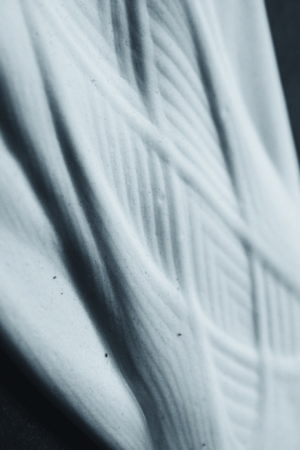
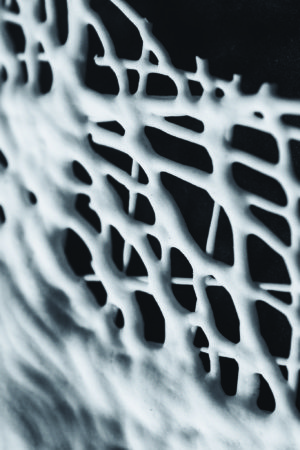
Prozess


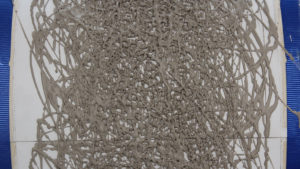
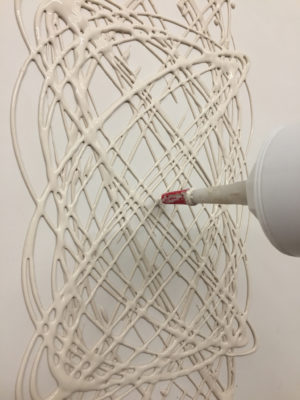
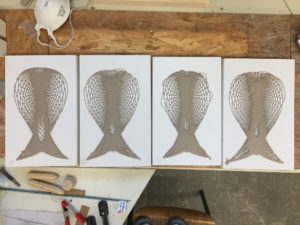

Prüfer
Prof. Axel Kufus, Prof. Burkhardt Schmitz, KM Caroline Bittermann
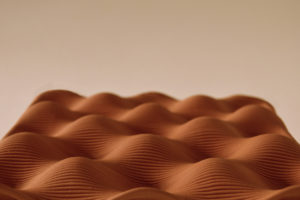
NEW (TOOL)PATHS
The project „New (Tool)Paths“ examines the possibilities and limits of ceramic 3D-printing and based on the results of the research provides an outlook on useful application potentials. By combining the material properties of ceramics and shaping by using 3D-printing technology, the unique properties in the identified areas of insulation, filtration, air conditioning and acoustics can be optimally utilized.

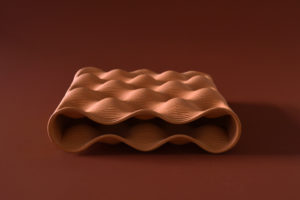

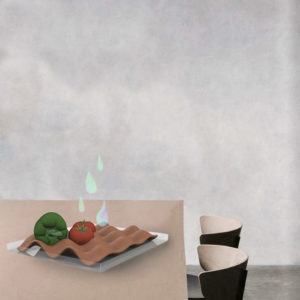
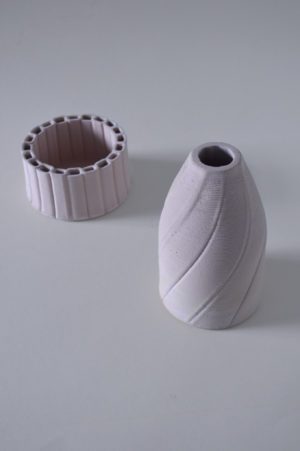
Prozess
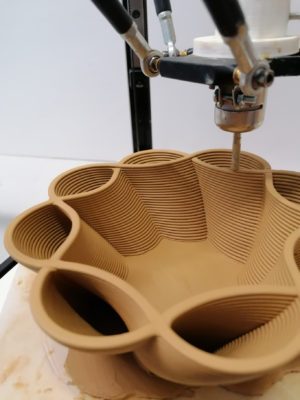


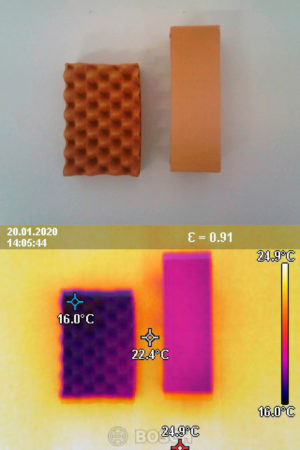
For my Bachelor project, I am currently working on the question of the extent to which economic factors in the form of trade barriers and the increasing shortage of resources influence fashion design processes. Or to express in a more bold way: “How the trade war between the US and China reshapes fashion”. The punitive tariffs between the USA and China made me think of the relationship between fashion and economics and I wanted to understand how a political decision can directly influence fashion design. For my research I conducted interviews with the Federal Ministry of Economics’ customs office in Berlin and with fashion brands from the US and figured out that the punitive tariffs have a big influence on the design process of fashion.
My collection will show and debate the design approach under trade barriers. To do so, I invented a collection that circumvents the punitive tariffs of the US. For example, instead of the iconic American denim, on which punitive tariffs have been imposed under the Harmonized Tariff Schedule, I will use pure silk, which is not affected by the tariffs, and will print denim texture on top of it. For my collection I like to play with iconic items, such as emblematic fabrics considering the American history, and how they might metamorphose under current political tendencies.
Created in consultation with: Prof. Valeska Schmidt-Thomsen / Gast Prof. Franziska Schreiber / Dr. Renate Stauss
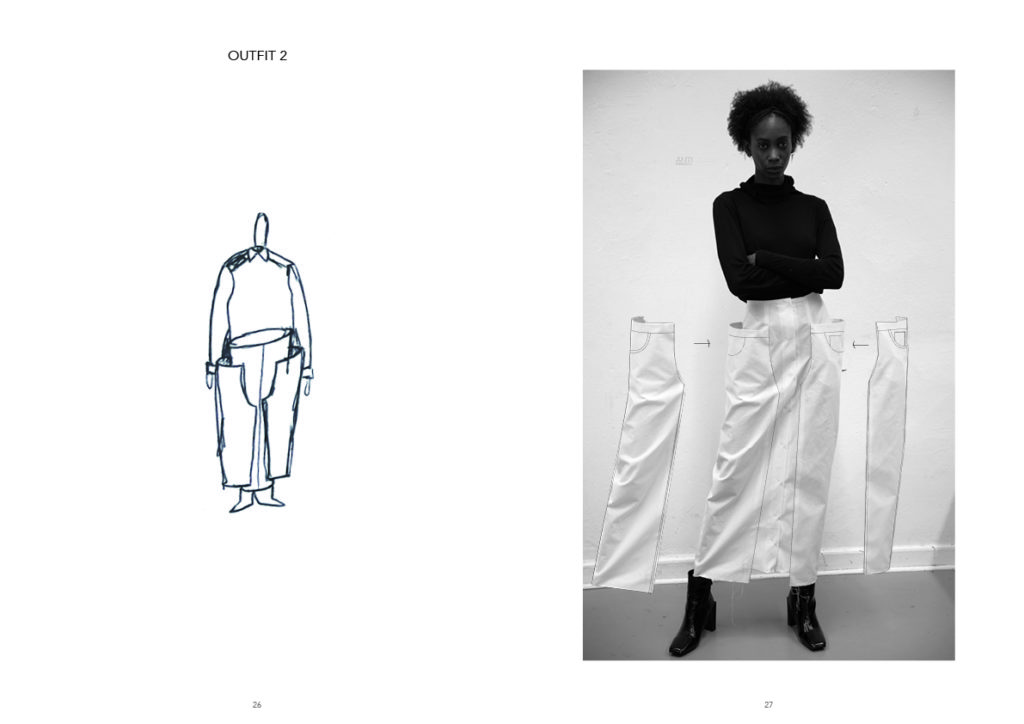
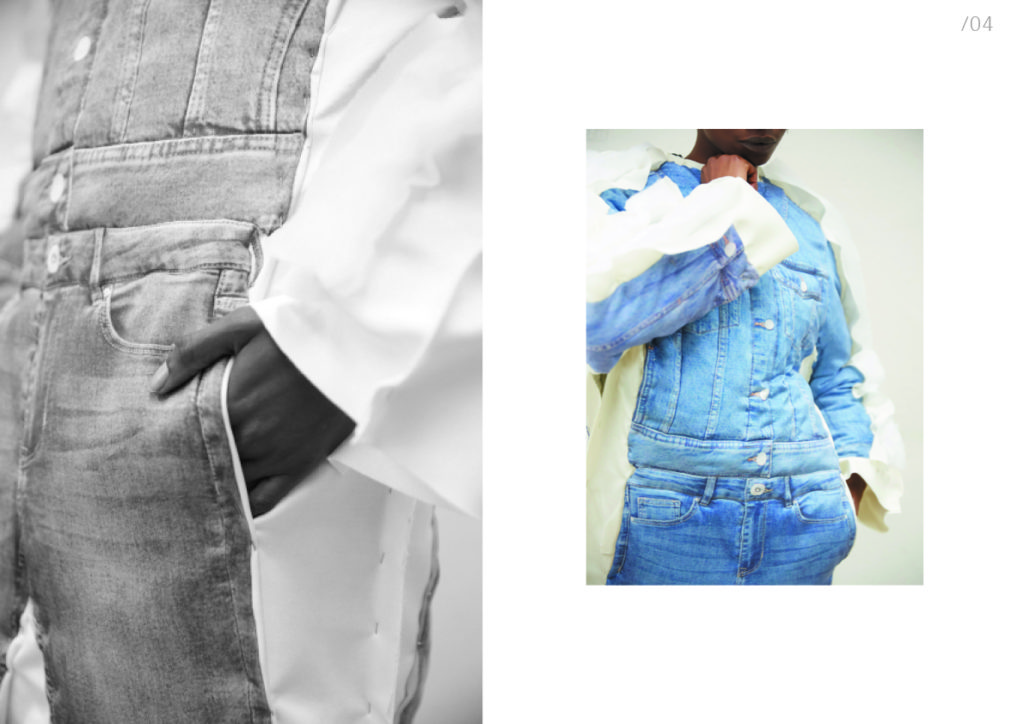
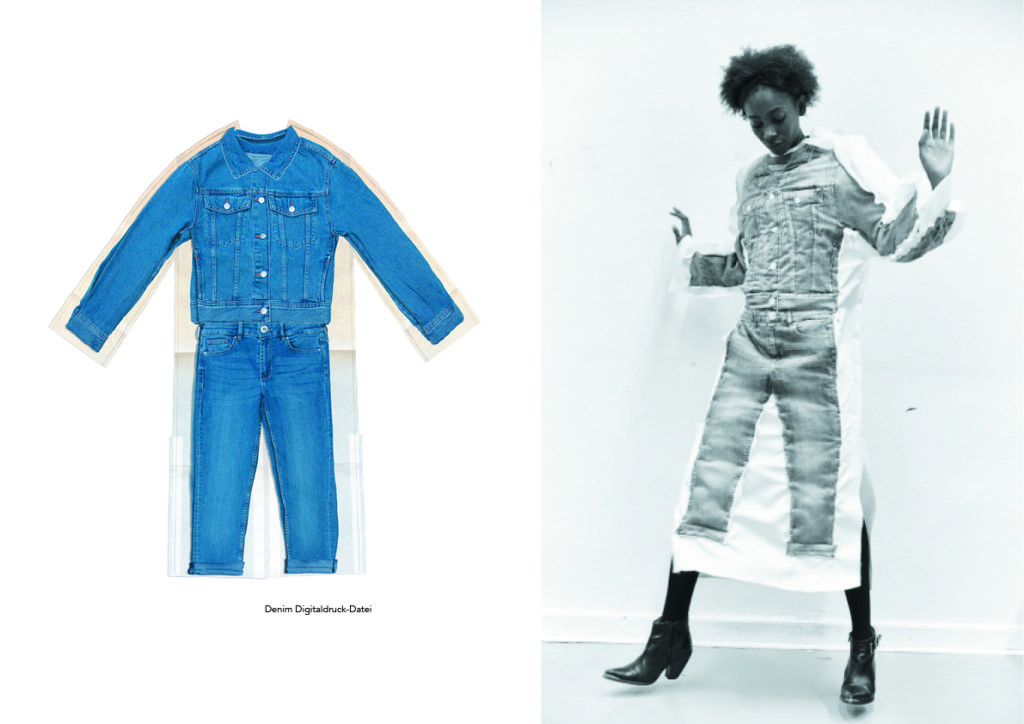
Credits:
Fotos: Esther Haase
H&M: Gunnar Schendera
Models: Robina von M4
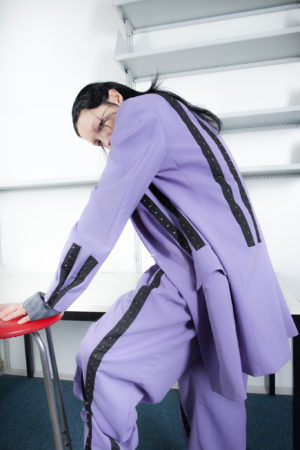
At the core of my collection lies my fascination and frustration with the men‘s suit. I have always had conflicted feelings towards this set of garments and what they represent. On the one hand, I love the craftsmanship, the skill behind tailoring, the fierceness and festivity of a suit. On the other hand, it is a symbol of patriarchy and male assertiveness. As a woman*, wearing a suit is a statement; a man* in a suit is simply well dressed and falls in line with the generations of men* before him*.
While the men’s suit still dominates the public image of decision making power in politics, business and on important cultural events, its importance in everyday life is waning. Many people don‘t like wearing suits for various reasons. It is deemed uncomfortable and who wants to be associated with a wall street banker* or a corrupt politician* anyway? The development of the suit we know today is highly influenced by the development of gender separation in the time of enlightenment and the French revolution. The manifestation of the gender dichotomy in fashion that followed still exists today, albeit less extreme and is questioned more thoroughly in todays gender debate. Throughout the course of my research I wondered if the suit will die as a symbol of patriarchy. Or if it will be appropriated for a more liberal expression of gender.
For this collection, I wanted to create a wardrobe full of desirable garments based on the positive elements of the suit, its fierceness and strength. The basic silhouette is inspired by the Zoot Suit subculture that appropriated the suit in the 1940s to show resistance towards the war and racism. It is defined by wide shoulders, a narrow waist and a full, pegged leg. The collection is designed across gender, and combines traditionally male and female attributes, drawing inspiration from the strict separation of mens tailoring and dressmaking.
I wanted to make the suit comfortable but still keep its elegance and dressed-up attitude. There are references to lingerie worked into the architecture of the suit: hook and eye closures, a corsage turned belt, the use of tulle and silk alongside traditional wool fabrics. The sleekness of the suit is broken up by layering pieces, draped elements and crochet details. Many pieces are interactive in the way they can be worn with hidden cuffs, hooks and eyes, integrated scarfs and alternative closures that allow for different shapes depending on the mood of the wearer.
Created in consultation with: Prof. Valeska Schmidt-Thomsen / Prof. Dr. Ingeborg Harms / KM Lars Paschke
Credits:
Fotos: Killa Schütze
Foto Assistenz: Veit Vogel
H&M: Nghiem Tuong VI
Models: Mini & Marek
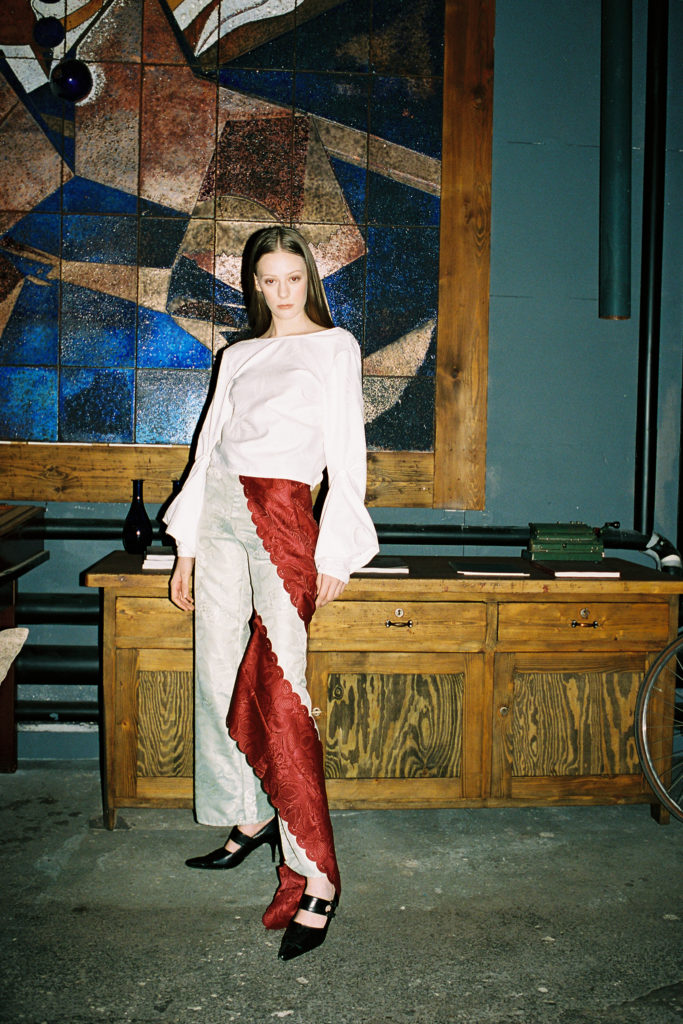
For my Bachelor degree, graduating from Universität der künste Berlin 2020, I have created the collection “Living Rooms”. An artistic work where I critically have been looking at the future of fashion, while at the same time learning from the past by researching historical examples of “Do it yourself” culture. “Do it yourself” or DIY has in past practises often been utilized in times of crisis. Such as during, after or in between wars or when the safety and structure in a society has been challenged or taken away. During unstable economies where people have been living with limited financial resources seeking creative solutions to make their own products. Times alike the crises we are faced with today. We live in a reality where our future is uncertain and extraordinary unpredictable.
These unconventional times enforces us to do things differently than the way that we have done things before. The resourceful attitude derived from “Do it yourself” culture was my main inspiration creating my Bachelor collection. By applying sustainable material solutions, I wanted to explore the possibilities of renewing the existing system of garment production. Taking discarded interior textiles as my starting point. The collection is titled “Living Rooms,” owing to the fact that the garments are produced using post consumer textile waste from interior textiles. In my design concept, I give these pre-used interior textiles new value by placing them in new “rooms,” in the sense that they are transformed from discarded interior textile into high fashion garments.
In this way, I achieved to prolong the lives of these pre-owned textiles by giving them the opportunity to re-enter the fashion system. These are materials that most likely would have had piled up on the mountains of landfills together with the already million tons of discarded textiles. Releasing methane emissions into the air, causing toxic pollution of the groundwater and harming our environment. By taking these rejected materials and giving them new life and new value, I wanted to raise the question of what we value within fashion and how we can change our ways of thinking about how we consume. A more sustainable fashion industry relies on us using already existing materials, eliminating the problem of textiles in landfills, and reframing the way we value our garments.
Created in consultation with: Prof. Valeska Schmidt-Thomsen / Prof. Dr. Ingeborg Harms / KM Lars Paschke
Credits:
Photographer: Lexi Sun
Assistants: Johanna Braun and Dominik Musewitsch
Hair and Makeup: Kateryna Wulff
Models: Jennifer Naval Farwer (M4 Models), Matilda Venter (DSM MGMT), Nadezda Papkovskaya
Location: Urban Industrial Berlin*
Sponsorship: Berliner Stadtmission/ Textilhafen
*We were very thankful to have had our shoot at the truly unique Urban Industrial Berlin. This is a artistic project with no intentions of neither party to be used commercially.
Let the good times roll | Bachelorarbeit 2019
The walker - an object that is essential to the life of many, yet viewed as unattractive and distasteful. An observer can feel the conflicting emotions of pity and disgust while watching the heavy and tottery constructions being pushed around. Many users feel shame and frustration associated with these necessary, but often dysfunctional and unappealing objects. This stigmatisation stands in contrast with the rising demand for walkers due to baby boomers entering the retirement stage, increasingly longer life expectancy and the high purchasing power held by sixty-somethings. “Let the good times roll” takes on this issue and researches alternative approaches to existing walkers. The goal is to challenge the current perception of the walker and its users by rethinking its functionality and aesthetics: How can its design be more centered around its users needs? How can the interaction be uncomplicated and intuitive? How can it’s appearance be made engaging and pleasant instead of shameful? “Let the good times roll” distances itself from the shiny metal and cheap plastic parts that characterize the clinical and overly technical look of standard walker models. Key of the design is the reworked folding mechanism, which gives the walker a more minimal and clean identity. The mechanical components that are usually attached additively all over the frame are integrated into the central joint, so the user is seeing only elements to interact with, such as buttons, flaps and levers. The color choices further highlight these parts to make their use guided and inviting. Furthermore, the construction allows for potential individualizations. The project is designed to enable satisfying, joyful interactions with an object that has long been neglected.
Prozess
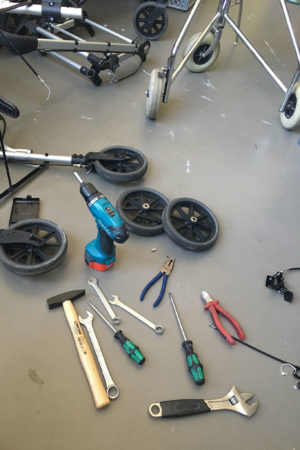
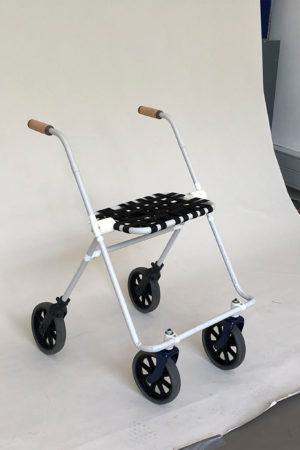
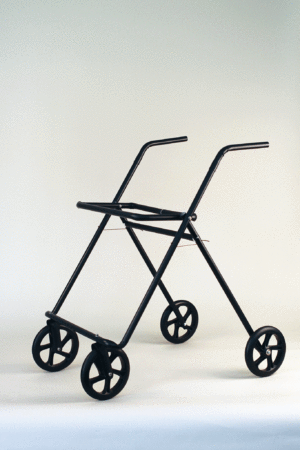
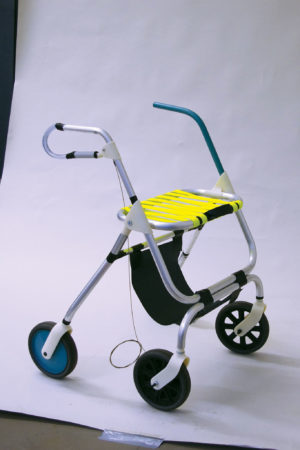
Betreuer
B. Schmitz, H. Neumann, S. Herm
Potentia | Masterarbeit 2019
Meine Arbeit „ Potentia“ steht im Zeichen der Frau – ihrer Möglichkeiten, Stärken, Geheimnisse. In einer vornehmlich patriarchalen Gesellschaft war und ist es immer wieder notwendig, sich als Frau der eigenen Rolle, der Rechte und der Position bewusst zu werden und für Veränderung und Verbesserung zu kämpfen. In Form dreier überlebensgroßer Göttinnen, angelehnt an afrikanische Yoruba-Gottheiten, versuche ich, die Widersprüchlichkeiten weiblicher Stärke und Mächtigkeit, ihrer Sexualität und ihrer nährend-mütterlichen Fähigkeit darzustellen. In ihrem Inneren (ver)bergen sie menschliche Modelle, die zu meiner ganz persönlichen Vorstellung von weiblicher Vielseitigkeit und Möglichkeit- eben Potentia im ursprünglichen Wortsinn – passen.
My master-project, deals with the issue of women`s position and situation in society, their possibilities, their power and their secrets. In a mostly patriarchal system it has always been essential to reflect the gender-differences and to fight for and defend feminine rights. I have created three goddesses- referring to the african culture of the Yoruba- to demonstrate the contrariness of female strength and power, of her sexuality and her nurturing and maternal qualities. Inside these figures I have hidden my personal version of a woman`s diversity and potential….POTENTIA
Betreuer
J. Legrand, I. Solomatina
LET THE FUTURE BE HUMAN | Masterarbeit 2019
THE HUMAN – A STRANGE BEING
THERE ARE A LOT AND QUITE DIFFERENT DESIGNS OF THEM WITH DIFFERENT TEXTURES AND FEATURES. EVERY HUMAN GET BORN AND EVERY HUMAN WILL DIE.
BETWEEN THESE TWO POINTS OF TIME THE HUMAN HAS THE OPPORTUNITY TO DEVELOP HIMSELF, TO GROW AND TO BECOME IN VARIOUS WAYS. WHILE THIS JOURNEY HE IS ACCOMPANIED BY OTHER PEOPLE. SOMETIMES BY MANY AND SOMETIMES BY A FEW. THE HUMAN IS BORN AND BELONGS TO A GROUP THROUGH THE CIRCUMSTANCES OF HIS BIRTH, SO ITS TOLD. THIS “GETTING-INTO-A-GROUP BY-CIRCUMSTANCES” ACCOMPANIES THE HUMAN THROUGHOUT HIS LIFE.
HOWEVER, HE ALSO HAS THE OPPORTUNITY TO MAKE A DECISION – TO DECIDE FOR OR AGAINST A GROUP . TO EVALUATE THEM FOR THEMSELVES AND TO MAKE A DECISION TO ATTEND THEM OR TO LEAVE THEM AND THUS TO TAKE A POSITION. MANY FACTORS INFLUENCE THIS DECISION. SOME OF THEM ARE CONSCIOUSLY MADE AND OTHERS MORE UNKNOWINGLY. THROUGHOUT HISTORY VARIOUS GROUPS AND COLLECTIONS OF HUMAN OR INHUMAN GROUPS HAVE EMERGED AND DISAPPEARED. EACH INDIVIDUAL BEING ASKED TO POSITION THEMSELVES AND MAKE A DECISION. OVER THE COURSE OF HUMAN HISTORY THE IMPORTANCE AND CHOICE OF GROUPINGS AS WELL AS THE NATURE AND STRUCTURE OF THESE GROUPS HAS CHANGED.
NEVERTHELESS THERE HAVE ALWAYS BEEN GROUPS WITHIN HUMAN EXISTENCE. BUT IS IT POSSIBLE TO REALIZE THAT ULTIMATLY AND BY A LONG WAY NOT ALL OF US REGARDLESS OF WHICH GROUP WE FEEL OR BELONG TO THAT WE BELONG TO ONE GROUP? THE GROUP OF HUMAN BEINGS. WITHIN THIS APPROACH IT IS NOT ABOUT TO SAY THAT WE ALL HAVE TO BE THE SAME WITHOUT THE POSSIBILITY OF
IDIVIDUALITY.
RATHER THE CONSCIOUSNESS OF THIS GROUP OF HUMAN BEINGS WHICH INCLUDES US ALL SHOULD MAKE CLEAR TO US HOW MANIFOLD THIS GROUP IS DEFINED. IT CONSITS OUT OF SO MANY DIVERSE CREATURES THAT IT IS IMPORTANT TO RECOGNIZE THEM ALL IN ALL THEIR DIVERSITY AS PART OF THIS GROUP. WE ARE HUMAN AND SHOULD BEGIN TO PERCEIVE OURSELVES FUNDAMENTALLY AS THESE. WE ARE ALSO MORE – WE ARE HUMAN BEINGS MADE UP OF AN INCREDIBLE NUMBERS OF DIFFERENT FACETS, IDIOSYNCRASIES, EQUALITIES, DIFFERENCES – BUT NEVERTHELESS WE ARE AND WILL REMAIN HUMAN BEINGS. WE SHOULD RESPECT EACH OTHER AND TREAT EACH OTHER WITH
RESPECT . IT IS NOT ABOUT MAKING EVERYONE BEING BEST FRIENDS FOREVER AND LIVING TOGETHER IN A BIG BRIGHT PINK BUBBLE IN A COLORFUL HAPPY WORLD – BECAUSE THAT IS NOT WHAT HUMAN BEINGS ARE MADE FOR. NEVERTHELESS IT WOULD BE DESIABLE TO PLACE THE IDEA OF THIS GROUP OF HUMAN BEINGS IN THE MINDS OF ALL TO CREATE A BASIC CONSENSUS WHICH CAN HOPEFULLY BE A WAY TO ACHIEVE A MORE POSITIVE TOGETHERNESS. FOR MORE INCLUSION THAN EXCLUSION. CERTAINLY THIS DESIRABLE BASIC IDEA DOES NOT SOLVE ALL THE PROBLEMS THAT HUMAN BEINGS HAVE WITH AND AMONG EACH OTHER. AND OF COURSE IT REMAINS THE QUESTION OF MORALLY E T H I C A L L Y A C C E P T A B L E INTERACTIONS WITH EACH OTHER WITHIN THE GROUP OF HUMAN BEINGS. AFTER EVERYTHING IT IS THE HOPE THAT THIS BASIC IDEA THAT WE ALL BELONG TO THIS COLLECTION OF BEINGS CALLED THE GROUP HUMAN BEINGS CAN HELP US TO COME A LITTLE CLOSER TO THE SOLUTION AND MAKING IT MORE ACCESSIBLE AND ACCEPTABLE TO ALL. IT DOES NOT MATTER HOW THE CREATURE LOOKS LIKE, HOW IT MOVES, WHAT COLOR ITS HAIR OR SKIN HAS. IT DOES NOT MATTER TO WHICH MUSIC, NOISE OR SOUNDS IT DANCES. THE ESSENCE OF HUMAN BEINGS AS SUCH EXISTS INDEPENDENTLY OF THESE DETAILS THEY ONLY DESCRIBE FACETS – INDIVIDUAL ELEMENTS OUT OF THEM IT IS MADE AND COMPOSED – OF THE ESSENCE
Prozess:
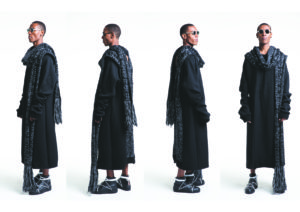
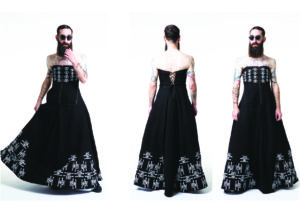

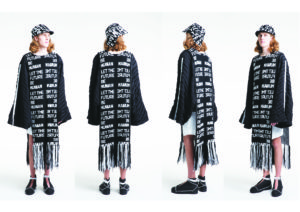

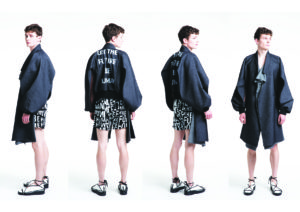
V. Schmidt-Thomsen und L. Paschke

Clothing and in the broader sense textiles appeal to the visual and tactile senses, arousing emotions and memories, communicating with the wearer and the observer, thus expressing our personality. Clothes are biographical objects. They tell our stories, have the power to revive the past and put us back in a certain way of life. They are an extension of ourselves and our memory in material form.
The project „The Stories We Are“ deals with the connection between the wearer and the garment and the influence our apparel memory has on our identity or how memory can be made seen in our clothing.
Created in consultation with: Prof. Valeska Schmidt-Thomsen / Gast Prof. Franziska Schreiber / Prof. Jozef Legrand
Photos: Eirikur Mortagne
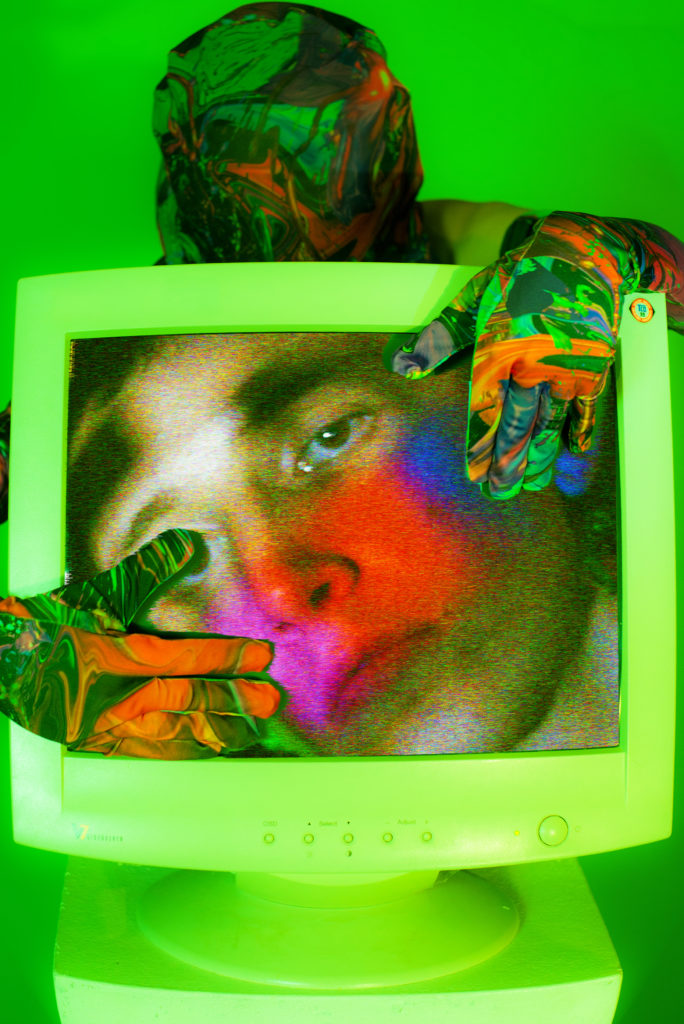
The dichotomy between the real and the virtual seems increasingly obsolete. Simulation Sickness explores the liminal space between the two, using techniques such as machine dreaming and chroma keying to create an inherently random design framework. Bridging this in-betweeness and the contemporary discourse on fetishism as a conceptual tool to inhabit alternative simulated realities. Fabrics and colours echo an imaginative approach to explore the unknown worlds of virtual mysticism and to examine the opportunities and responsibilities of a design process driven by fetishistic narratives.
Created in consultation with: Prof. Wowo (Waldemar) Kraus / Prof. Jozef Legrand / KM Magdalena Kohler
Photos: Alexandru Plescu / Model: Mathis

Created in consultation with: Prof. Wowo (Waldemar) Kraus / Prof. Jozef Legrand / KM Lars Paschke
Photos: Julian Lee-Harather / H+M: Max Artemis / Model: Emely
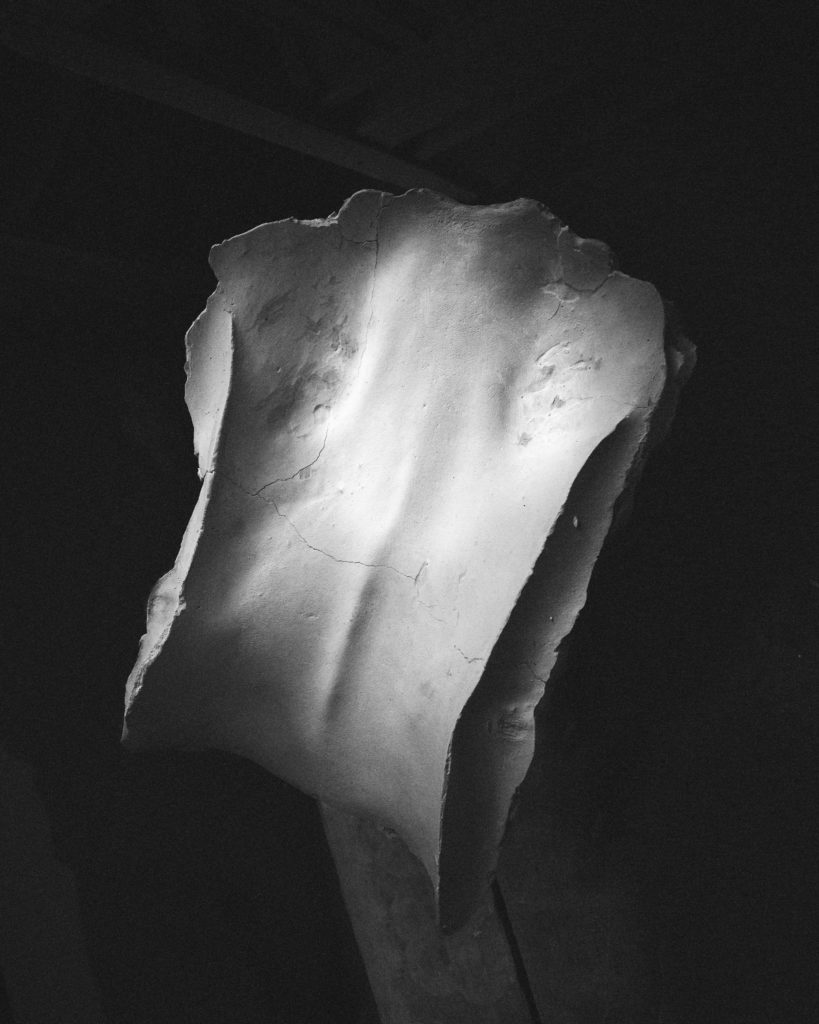
Persephone includes seven looks, a photo series, a book and a concept video. The work deals with the use of time, as inspiration and means of design, but also in a wider social context. Its starting point is the ancient myth of Persephone, which revolves around the passage of time, cyclicity and different human ages, and to which the origin of numerous ancient fertility rituals can be traced. Persephone provokes reflection on the values of past and present times.
created in consultation with: Prof. Wowo (Waldemar) Kraus / Prof. Jozef Legrand / KM Magdalena Kohler
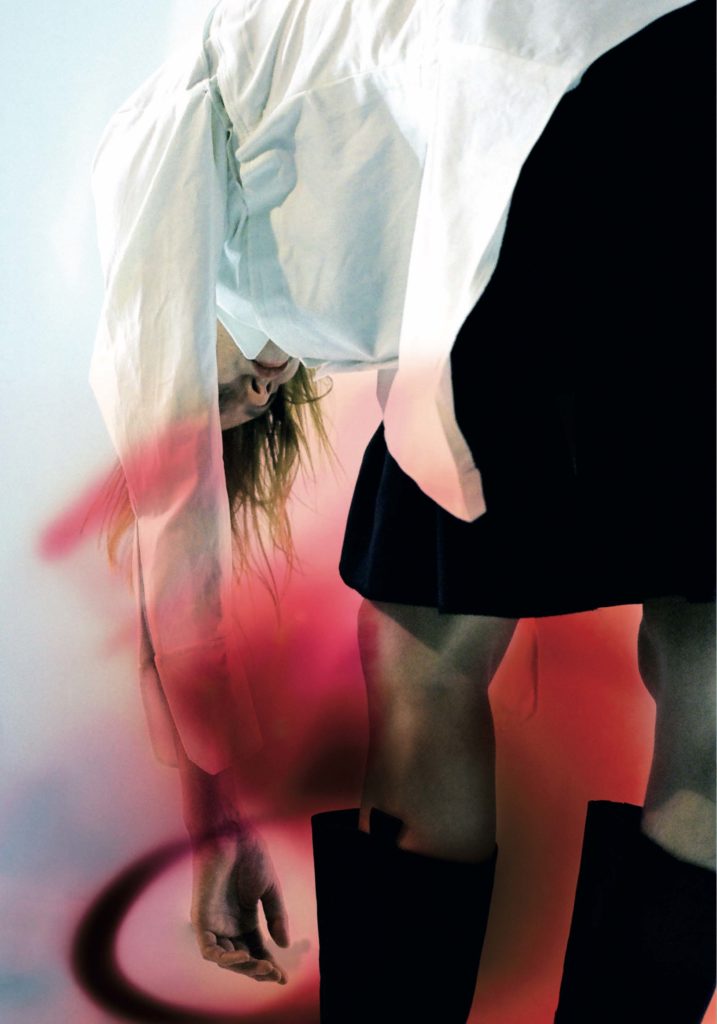
This project started by evaluating the non-individual as a byproduct of mass customization where the industries
intention to create individuals has
rendered them mute and uniform.
Opposed to this limited expression that is bonded by artificiality, the collection is made up of fragmented pieces that can be worn in different ways and give the
wearer the freedom to emotionally
customize combinations.
In this way, five standard items (trench, shirt, dress, jersey longsleeve, blazer) become interchangable. Bleached velvet it used throughout the collection to resemble a slightly corroded texture.
Created in Consultation with: Prof. Valeska Schmidt-Thomsen / Prof. Dr. Ingeborg Harms / KM Lars Paschke
Photos: Ellie Lizbeth Brown / Model: Emilie Palmelund / Assistenz: Niclas Hille
FEMOID | Masterarbeit 2019
Schleim als Widerstands Praktik gegen die Beauty Norm
Mich interessieren die Momente, in denen Frauen als ekelerregend, beunruhigend oder bösartig dargestellt werden, mit dem Potenzial Angst und Abschreckung, als auch Faszination und Verehrung zu verursachen. Sowie das unsichtbar machen und das Tabuisieren von Körperfunktionen und Körperflüssigkeiten von Körpern, die allgemein als weiblich definiert werden, wie Stillen, Entbindung und Menstruation, welche im gesellschaftlichen Diskurs weniger bzw. nicht artikuliert werden oder negativ belegt sind.
Mein Projekt erforscht das Angst- und Machtpotenzial der Frau und ihres Körpers im Spannungsfeld zwischen Ekel und Attraktivität. Dabei geht es um die Aneignung und Ästhetisierung des Ekels, der in Form eines beunruhigenden Körpers nutzbar gemacht wird. Es geht um die Aneignung einer vermeintlich hässlichen oder ekelerregenden Ästhetik, bei der die Gleichzeitigkeit von Faszination und Abstoßung eine Rolle spielen, um die Grenzen der eigenen Identitätsdarstellung zu erweichen und zu erweitern.
Den Ausgangspunkt meiner Beobachtungen bilden Eigenschaften, Körperfunktionen und Körperflüssigkeiten, die Unbehagen auslösen – als mystifizierte Urangst. Dieser imaginierte Körper drückt Ängste vor dem Fremden und Unverständlichen aus. Er droht mit Kontrollverlust, dem Schmutz und der Vergänglichkeit und dem Verfall von Werten und Normen. In einer Gesellschaft, die Produkte bewirbt, um Körperflüssigkeiten wie Schweiß, Menstruationsblut und Vaginal Sekrete aufzuhalten und unsichtbar zu machen, in einer Kultur, in der die einzigen bedingt statusfähigen Körperflüssigkeiten Sperma und Tränen sind, bringen Schleim, Schweiß und Blut die Stabilität der Dinge in Gefahr.
Die Kollektion soll ein Tool sein, um das Verhältnis zwischen dem eigenen Körper und der eigenen Identität zu hinterfragen – durch die Dekonstruktion von fiktiven Rollenbildern und der Provokation und Irritation des Betrachters, mit Hilfe der Ästhetisierung von Groteskem und Ekligem.
Es ist der Versuch sich einem fluiden Körperbild anzunähern, einem Körperbild in dem Anomalien, innere Prozesse und Körperfunktionen eine Daseinsberechtigung finden, als ästhetische Mutation die das Innere nach Außen kehrt.
Slime as resistance practice against the beauty norm
I am interested in the moments when women are portrayed as disgusting, disturbing or malicious, with the potential to create fear and deterrence, as well as fascination and reverence. As well as the moments in which bodily functions and bodily fluids of bodies that are generally defined as female, are beeing made invisible or tabood, such as breast- feeding, childbirth and menstruation, which are less or not articulated or negatively documented in social discourse.
My project explores the fear and power potential of women and their bodies in the field of tension between disgust and attractiveness. It deals with the appropriation and aestheticization of disgust, which is made usable in the form of a disturbing body. It is about the appropriation of a supposedly ugly or disgusting aesthetic, in which the simultaneity of fascination and rejection play a role, in order to soften and expand the boundaries of one’s own representation of identity.
The starting point of my observations are properties, bodily functions and bodily fluids that cause discomfort – as mystified primal fear. This imagined body expresses fears of the foreign and the incomprehensible. It threatens with loss of control, dirt and the transience and decay of values and norms. In a society that promotes products to stop and make body fluids invisible such as sweat, menstrual blood and vaginal secretions, in a culture in which the only conditionally statusable body fluids are sperm and tears, slime, sweat and blood endanger the stability of things.
The collection is intended to be a tool for questioning the relationship between one’s own body and one’s own identity – through the deconstruction of fictitious role models and the provocation and irritation of the viewer, with the help of the aestheticization of the grotesque and the disgusting.
It is an attempt to approach a fluid body image, a body image in which anomalies, inner processes and body functions find a reason for existence in order to free oneself from a static, restrictive body image.
It is an attempt to approach a fluid body image, a body image in which anomalies, inner processes and body functions find a ground for existence, as an aesthetic mutation that turns the inside out.
Prozess
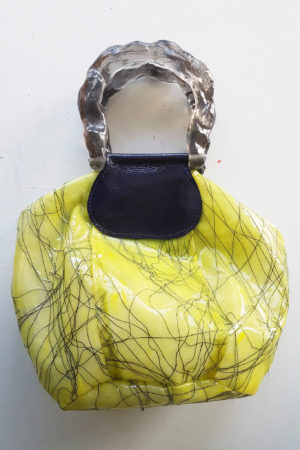




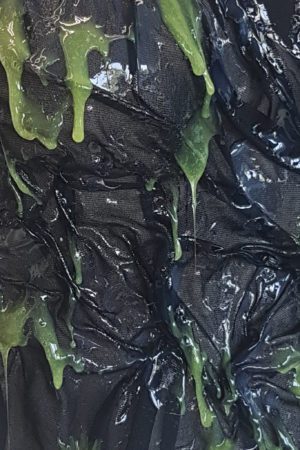
Betreuer:
L. Paschke & I. Harms
Erbgut | Masterarbeit 2019
Erbgut – or how I followed and developed an unsuited fetish for the suited man
Es ist kaum zu umgehen, dass Bekleidung als äußerlich sichtbares Merkmal die gesellschaftliche Stellung ihrer Träger markiert. Bis heute ist nämlich die in der französischen Revolution proklamierte Wahlfreiheit der Bekleidung nicht durchgesetzt.
Die Uniform für alle, die von den Sansculotten gefordert wurde, bleibt bis heute unverwirklicht. Stattdessen uniformieren sich die verschiedenen Gesellschaftsgruppen. Demnach können an der getragenen Kleidung auch die verschiedenen Gruppen unserer heutigen Gesellschaft bestimmt werden.
Viele Designer und die Mehrzahl der Konsumenten sind sich einer Meinung: Kleidung entscheidet über die Zugehörigkeit und den Wert eines Menschen und nicht zuletzt wird von ihr auch gerne auf das Innere und auf die Gedankenwelt der Träger geschlossen.
Die Bedeutung der Kleidung ist enorm denn sie ermöglicht nicht nur eine einfache verortung von Menschen in moderne Klassengesellschaften sondern zeigt gleichzeitig deren angebliche Stellung in einer von der Öffentlichkeit akzeptierten soziokulturellen Hierarchie an.
Folgt man dieser Struktur, dann ist der Männeranzug, dieses von Europäer für Europäer entwickelte Kleidungsstuck, immer noch der anerkannteste visuelle Vertreter der bestehenden Strukturen in Gesellschaft und Politik.
Ziel meiner Arbeit ist es, mit anthropologischen Forschungsmethoden und musealen Darstellungstechniken sowie mit 36 Porzellan Skulpturen, einer Videoinstallation und einem gewobenem Seziermodell das in der Allgemeinheit akzeptierte Bild des Anzugs als Indiz für oder gegen den Aufstieg in eine bessere Gesellschaftsschicht in Frage zu stellen.
Durch das Inschaustellen spekulativer Machtsymbole, wird die belehrende Funktion von Museen in Frage gestellt. Immer noch werden Sammlungen ganz bewusst inszeniert, und teilweise chronologisch aufgereiht, um dem Zuschauer ein Gefühl der evolutionären Kontinuität zu vermitteln. Die Anzugshaut wird hier als entscheidendes Stadium einer sozioökonomischen Entwicklung des Gesellschaftskostüms betrachtet: als Organ der Macht.
Das Umkehren von Austellungstechniken und Materialien ermöglicht eine Umkehrung des Blicks.
Es stellt sich die Frage, wie und warum akzeptierte Realitäten kontinuiert und unterstützt werden.
Das Misstrauen der Selbstverständlichkeit.
Erbgut – or how I followed and developed an unsuited fetish for the suited man
This project is the result of a year long research on social and political dynamics inherent to the fashion industry. My thesis develops around the question of power and accepted structures that crystallise into garments and clothing cultures.
Main focus of the exhibition is the male suit in its contemporary appearance. The suit is still today a symbol of power and it is undeniable how important such garment is to create a certain social and political hierarchy.
I am working towards the analysis and the critical observation of such hierarchies by dismantling the suit in its single components.
The project will thus put the suit into a different point of view and challenge the observer to question not only how we have been taught to almost blindly accept the seemingly obvious social status of a garment but also how deep and historically charged a piece of clothing can be.
Questions of gender equality and social justice are organically interwoven with the fabric of today’s suit and my exhibition is aiming to unveil and deepen these topics.
Next to 36 porcelain sculptures, a bronze idol and a video installation I am developing a woven anatomical model of the suit. This anatomical suit is developed using techniques historically adopted by anthropologists and aims to create a trompe-l’œil vision in the gallery where it is going to be hung.
the optical illusion will mimic a suit like we know it from everyday’s garments but the materiality and the distortion will evoke a questioning gaze.
Hanging in mid air it will be possible to observe the anatomical speculative suit in its entirety and from every angle. The photorealistic jacquard will remind of luxurious tapestries known from royal traditions where heroic sceneries were gloriously showcased on luxurious wall hangings while the slight distortion of the garment will invite to contemplate the threads such a seemingly obvious garment is pulling in our society.
Prozess
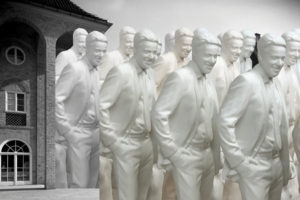

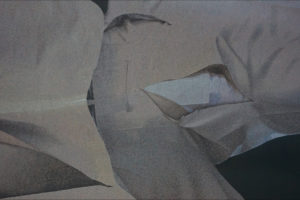
Betreuer:
V. Schmidt-Thomsen, I. Solomatina
SpinCuisine | Bachelorarbeit 2019
SpinCuisine ist eine Eismanufaktur, in welcher durch eine
vertikales Schleudergussverfahren Stieleis hergestellt wird.
In einem ergebnisoffenen Prozess wurden mit experimentellen Methoden die formgebenden Potentiale der Fliehkraft ergründet. Die Erkenntnisse verhalfen zur Entwicklung einer performativen Eisherstellungsmethode.
Eine vertikal rotierende Zentrifuge dient als Schleudergussform, in welcher das Eis Schicht für Schicht aufgebaut wird. Es kann zwischen unterschiedlichen Kuvertüren, Infills und Eissorten ausgewählt werden.
In der vorgekühlten Silikonform erstarrt geschmolzenes Karamell und Schokolade in der Rotationsbewegung. Daraufhin wird ein Eiskern mit Stiel eingefügt, welcher sich mit den äußeren Schichten verbindet.
Die Eisform orientiert sich an den Eigenschaften des Schleuderguss-Verfahrens, welche paraboloide Körper begünstigt. Die dreidimensionale Oberfläche erzeugt eine heterogene Materialstärke der ersten Schicht und verstärkt das taktile Erlebnis.
SpinCuisine is an ice cream manufactory in which a vertical centrifugal casting process is used to produce popsicles.
In an open end process, experimental methods were used to explore the shaping potentials of centrifugal force. The findings helped to develop a performative ice making method. A vertically rotating centrifuge serves as a casting mould in which the ice is built up layer by layer. You can choose between different types of couvertures, infills and ice cream flavours.
In the pre-cooled silicone mould, melted caramel and chocolate are solidified in a rotational movement. An ice core with a stick is then inserted. It connects with the outer layers.
The shape of the ice is based on the properties of the centrifugal casting process, which favours paraboloids. The three-dimensional surface creates a heterogeneous material thickness of the first layer and enhances the tactile experience.
Prozess
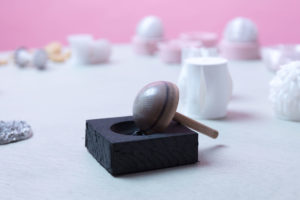

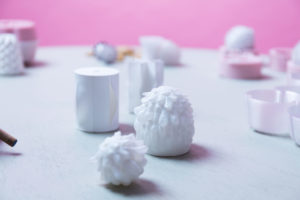
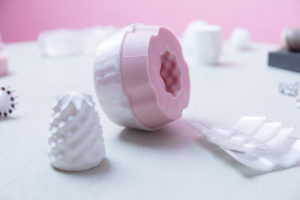
Betreuer
I. Hans, A. Heine, S. Herm
Weeping husbands at the flower shore | Masterarbeit 2019
Mein Master Projekt hinterfragt das Konzept von Männlichkeit und dekonstruiert gesellschaftliche Rituale, die in jeder Kultur durchlaufen werden um das Eintreten in die Gesellschaft zu erleichtern, sowie die damit verbundenen Geschlechterrollen. Hauptsächlich konzentriere ich mich auf die Hochzeit und das Brautkleid. Es entsteht eine Utopie, in der der Mann frei ist, seine Rolle selbst zu wählen und er die der Braut einnehmen kann. Hierbei wird ein sich Lösen von den am Brautkleid behafteten gesellschaftlichen Normen aufgezeigt. Es sollte eine neue Ästhetik für den Mann geschaffen werden, die ihm sonst nicht zugänglich wäre. Männer sind heutzutage genauso verletzlich, stehen unter Druck und sind ebenso anfällig für kommerzielle und mentale Manipulation wie Frauen. Als weiblich geltende Eigenschaften wie Sensibilität und Mitfühlvermögen sind immer noch verpönt. Männer, die diese Charakterzüge zum Vorschein bringen, werden häufig zum Gespött, sie werden lächerlich gemacht und als Schwächlinge angesehen. Es stellt sich die Frage warum diese sogenannten weiblichen Eigenschaften bei Männern als etwas Schlechtes gesehen werden. Traditionelle Männlichkeit wird Jungs überall eingeimpft, sie bekommen das nicht mal mit. Ihnen wird beigebracht stark zu sein und nicht zu weinen. Stark zu sein wird verstanden als wasserdichtes Gefäß zu fungieren, sowohl körperlich als auch emotional.
Die Kollektion richtet sich darauf den heteronormative, hegemonischen Mann als Minderheit zu betrachten. Es werden Männer portraitiert, die sich als Feministen bezeichnen wollen, sich überfordert und unterdrückt fühlen in ihrer eigentlich so überlegenen, privilegierten Rolle.
My MA project questions the concept of masculinity in western society today and deconstructs social rites that are passed through in every culture to facilitate entry into society and the gender roles connected to them. I mainly focus on the wedding and the wedding dress and create a utopia in which the man is free to choose his own role and he can take the one of the bride. A detachment from the negative qualities attached to the bride’s dress is shown as well as a breakaway from the social norms it carries.
I wanted to create a new aesthetic for men that usually would not be accessible to them. Men today are just as much under pressure and vulnerable to commercial and mental manipulation as women are. Feminine connotated characteristics such as sensitivity and compassion are still frowned upon them. Those who show these traits are often ridiculed and seen as weaklings.
Traditional masculinity is ingrained in boys everywhere, they don’t even notice. They are taught to be strong and not to cry. Being strong is understood to function as a waterproof vessel, both physically and emotionally.
The collection focuses on seeing the heteronormative, hegemonic man as a minority. Men are portrayed who want to call themselves feminists, who feel overwhelmed and oppressed in their actually superior, privileged role.
Prozess
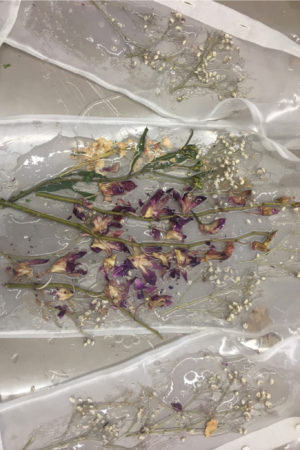

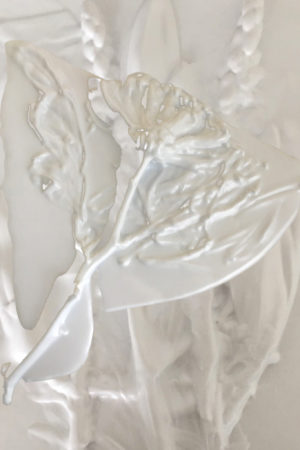
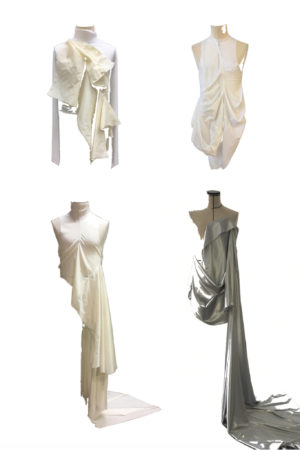
Betreuer:
J. Legrand, W. Kraus
RE | Masterarbeit 2019
Die Masterarbeit > re < befasst sich mit der Position als Designer/-In, zwischen Nachhaltigkeitsforderungen und ästhetischer Ökonomie. Die Arbeit basierte auf der persönlichen These, dass Konsumverzicht in einer ‘Surplus‘ -Gesellschaft eine unrealistische Lösung darstellt. Besonders unter Beachtung, dass eine Reduzierung des Konsums die eigentliche Problematik von schädlichen Produkten nicht kompensiert.
In diesem Projekt wurde ein Ansatz getestet, der nachhaltige Kriterien in den Kategorien: Materialherstellung, Verarbeitung und Recycling- und Entsorgungsverfahren, in den Entwurfsprozess einbezieht.
Die gewählten Kriterien erzielen eine positive Änderung der Konsequenzen des Endprodukts, ohne dass eine Reduzierung oder ein Verzicht im Design angestrebt wird.
Durch eine Reihe von Materialexperimenten und Recherche definierte sich die Verwendung eines natürlichen Materials namens Scoby (symbiotic culture of bakteria and yeast) heraus. Es ist allgemeiner als ‘health drink‘ namens Kombucha bekannt und besitzt als textiles Erzeugnis einzigartige Eigenschaften, wie dem mobilen Anbau, der dauerhaften Reproduktion oder der transparenten 3D-Faser Struktur.
Das Ergebnis ist ein veränderter Herstellungsprozess, zwischen Bekannten und Unbekannten in der Mode-Industrie. Die Herstellung beginnt mit dem selbstständigen Wachstumsprozess und endet in einem wasserbasierten Färbe- und Klebeverfahren des entwickelten ‘allover‘ Ornamentes.
Die entstandenen Kleidungsstücke und Accessoires zelebrieren das Ornament als bekanntes Symbol für Begehren und Inszenierung und bestechen durch ihre Ökobilanz, zu der Kompostier- und Recyclingfähigkeit gehören. Das Projekt erschafft eine Vision für eine positive Version der Zukunft in der Mode-Branche.
The master thesis > re < deals with the position as designer, between sustainability requirements and aesthetic economics. The work was based on the personal thesis that non-consumption in a ’surplus‘ society is an unrealistic solution. Especially considering that a reduction of consumption does not compensate the actual problems of harmful products.
In this project, an approach was tested that incorporates sustainable criteria, in the categories of material production, processing and recycling and disposal processes, into the design process.
The chosen criteria produces a positive change to the consequences of the final product, without aiming for reduction or abandonment in the design.
Through a series of material experience and research, the use of a natural material called Scoby
(symbiotic culture of bacteria and yeast) was defined. It is more commonly known as a health drink called Kombucha and as a textile product it has unique features, such as mobile cultivation, permanent reproduction or its transparent 3D fiber structure.
The result is a modified manufacturing process, between the known and unknown in the fashion industry.
The process begins with the self-sustaining grow of the material and ends in a water-based dyeing and gluing process of the developed allover ornament.
The developed garments and accessories celebrate the ornament as a symbol of desire and self-representation and impresses by their eco-balance, with composting and recycling capability. The project illustrates a vision for a positive version of the future in fashion industry.
Prozess

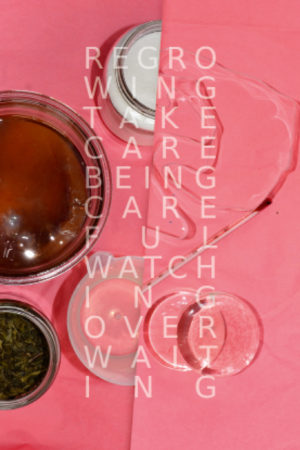
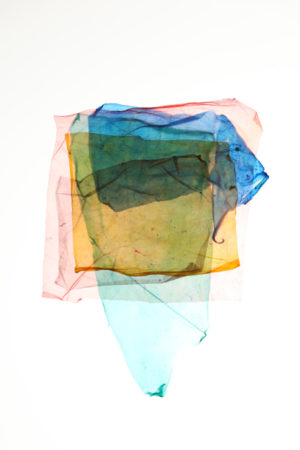
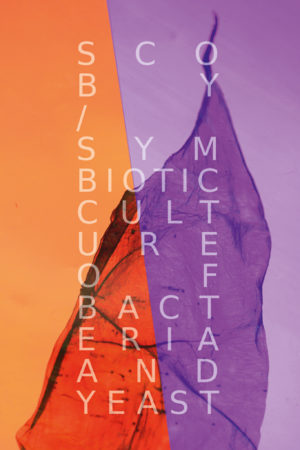
Betreuer
J. Legrand, L. Paschke

The subjectivity of objects | Masterarbeit 2019
Das Projekt The Subjectivity of Objects untersucht die Bedeutung, Gemeinsamkeit und Differenzierbarkeit der Begriffe Handwerk, Kunst und Design. Haben wir selbsterschaffene Objekte schon immer in Kategorien erfasst? Welchen Zweck erfüllt die Kategorisierung solcher Objekte? In einer Kollektion von Teppichen, die mit unterschiedlichen dimensionsebenen arbeiten und in verschiedenen Inszenierungen gezeigt werden, wird der Frage nachgegangen welcher der drei oben genannten Kategorien ein Teppich zugeordnet werden kann. Wenn es nicht Möglich ist einen Teppich pauschal zuzuordnen, muss sich die Frage gestellt werden ob irgendein Objekt über einen einzelnen Begriff definiert werden kann. Das Projekt The subjectivity of Objects fragt wie wir von uns hergestellte Objekte definieren und warum diese Definitionen auch persönlicher oder subjektiver Natur sein können.
The project The Subjectivity of Objects is oriented around an examination of the terms craft, fine art and design. Have we always categorized the objects that we make? What purpose does categorization have? Through a series of carpets displayed on various planes and in different contexts, these objects pose the question, to which category does a carpet belong? And if a carpet can elude classification, can any object be solely defined by one term? This project asks how we define the objects that we make and why these definitions might be of a personal or subjective nature.
Prozess
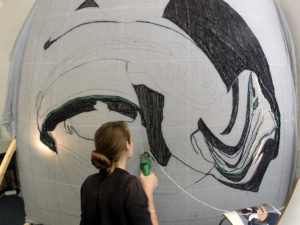
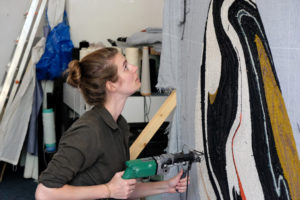
Betreuer
B. Schmidtz, S. Prinz
Multi Dimensional Being | Masterarbeit 2019
Multi Dimensional Being ist eine persönliche Studie über Identität und Individualität innerhalb meiner Generation. Das Projekt befasst sich mit der wachsenden Popularität von well-being, magischen und spirituellen Praktiken, sowie deren Symbole, welche einigen Millennials als Mittel dient ihre Identitäten zu ermächtigen.
Meine Methode ist es verschiedene, scheinbar gegensätzliche Referenzen, Figuren und Kulturen in Beziehung zueinander zu setzten, sodass „andere” Geschichten entstehen. Anhand der vorhergegangenen Recherche, habe ich vier verschiedene hybride character entwickelt. Jeder von ihnen wurde zur Inspiration und Quelle für die weiteren Ergebnisse, für welche ich verschiedene Medien und Techniken angewandt habe.
Die Resultate sind der Gothic Hacker Angel, Schmuck mit Elementen aus Aluminium, der Psychedelic Healing Savant, bedruckte Seidentücher, der Spiritual Cyber Demon, Fragmente von Bekleidung, der Norm Tech Sorcerer, ein Duft, sowie ein Glasobjekt.
Multi Dimensional Being is a personal study on identity and individuality of my generation. The project focuses on the growing popularity of well-being, magical and spiritual practices as well as their symbols, which some millennials use as tools for empowering their identities.
My method is to relate several supposedly different characters, references and cultures to each other to create „other“ stories. Based on the previous research I created four different hybrid characters. Each one became the inspiration and source for the further outcome, for which I was using different media and techniques.
The results are the Gothic Hacker Angel, jewelry with aluminum elements, the Psychedelic Healing Savant, printed silk scarfs, the Spiritual Cyber Demon, fragments of clothing, the Norm Tech Sorcerer, a scent and a glas object.
Prozess
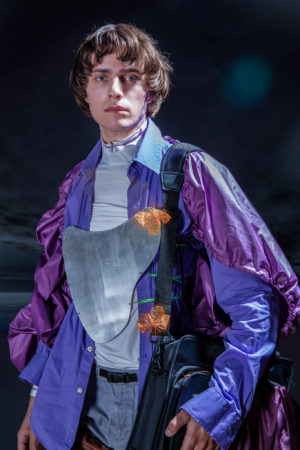
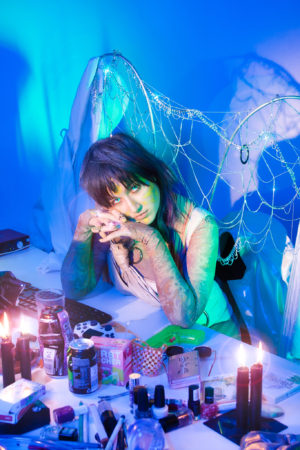

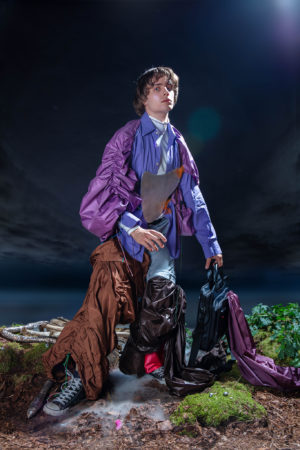
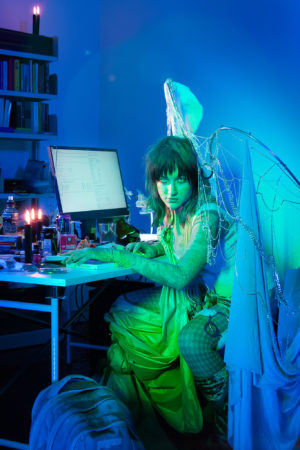

Betreuer
V. Schmidt-Thomsen, L. Paschke
using one’s feet has become an option of last resort | Masterarbeit 2019
Die Motorradkultur ist zum Symbol des heutigen Vietnam geworden und markiert den Ursprung des kapitalistischen Übergangs Vietnams seit Mitte der 80er Jahre. Das Projekt konzentriert sich auf Diskurse über Konsumismus, Mobilität, Geschlechter- und Klassenidentität und untersucht den aufkommenden weiblichen street style der Motorradfahrerinnen in Vietnam, der als „Street Ninja“ bezeichnet wird. Durch die Dekonstruktion und Assemblage der UV-Schutzkleidung von „Street Ninjas“ zu „tragbaren Skulpturen“ schlägt das Projekt eine emanzipatorische Strategie vor: die „Street Ninjas“ werden Protagonistinnen ihrer Markierungen und deuten ihre diskriminierenden Erfahrungen um. Darüber hinaus haben die Protagonistinnen ein emanzipatorisches Potenzial in der Neukonfiguration der Bedeutung von Mobilität und Frauenerfahrung, indem sie Grenzen des weiblichen Körpers mit Waren (z.B. Motorrad, Mode) vermischen. Auf diese Weise eignen sie sich (öffentliche) Räume an und wenden gleichzeitig Methoden der „feministischen kollektiven Verbundenheit“ an.
The motorbike culture has become the symbol of contemporary Vietnam, marking the core of Vietnam’s capitalist transition since the mid-1980s. Focusing on discourses of consumerism, mobility, gender and class identity, this project explores the emerging female motorist street style in Vietnam, dubbed as ‘Street Ninja’. By deconstructing and reassembling the ‘Street Ninjas’ UV protection clothes to ‘wearable sculptures’, the project suggests a strategy for reimagining the ‘Street Ninjas’ as protagonists countering their discriminatory experiences. Furthermore the protagonists have an emancipatory potential, as they reconfigure signifying meanings of mobility and women’s experience by blending boundaries of the female body with commodities (i.e. motorbike, fashion). By doing so, their goal is to appropriate (public) spaces while applying ‘feminist collective affinity’.
Betreuer
S. Prinz, L. Paschke
Mingstra und Chingstra | Masterarbeit 2019
im Rahmen des Projekts setzt sich Xinying Li, Designerin aus China, damit auseinander, dass in der Wahrnehmung der Europäer chinesische Möbelstile Ming und Ching Dynastien geprägt sind.
Jedoch bevorzugen die meisten Menschen in China modernistischen Möbel wie von IKEA. Bei ihrem Projekt setzt sie die beiden Stile in Verbindung – Osten und Westen, jung und altmodisch, traditionell und modern getroffen.Werden sie zusammenwachen oder zusammenstoßen.
This project is an exploration of the furniture style by Xinying Li. As a designer from China, Xinying found that people in Europe regard the Ming and Ching dynasty designs as the dominant furniture style in china.
Nowadays, people in china are more interested in buying modernist furniture which is produced by Ikea.in her project, ihr tries to combine these two styles. When the furniture styles of the east and the west collide with the traditional and modern, this is to say, when the young meets the old, will they merge or oppose eachother.
Prozess
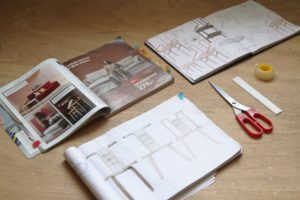
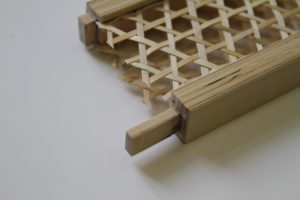
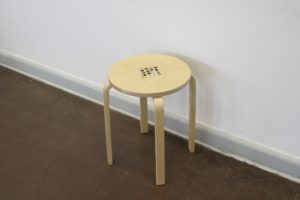

Betreuer
I.Hans, A. Kufus
Extension | Masterarbeit 2019
In der gesamten Historie tauchen unorganische Prothesen als Imitation menschlicher Organe auf. Mit dieser Prothetik wird das Individuum wieder in die Gesellschaft kosmetisch und produktiv integriert und der sozialen Norm angenähert. Technische und medizinische Meilensteine werfen die Frage auf, warum wir verlorene Organe nur ersetzen, wenn wir doch unseren Körper, unsere Fähigkeiten und sogar unsere Wahrnehmung erweitern könnten.
Meine Abschlussarbeit beleuchtet die Cyborgisierung des Menschen und skizziert an einem Konzept eine mögliche Erweiterung der räumlichen Wahrnehmung.
Throughout history, inorganic prostheses have appeared as imitations of human organs. With this prosthesis, the individual is again cosmetically and productively integrated into society and brought closer to the social norm. Technical and medical milestones raise the question of why we only replace lost organs when we could expand our body, our abilities and even our perception.
This thesis explores the cyborgization of the human being and sketches a concept for a possible expansion of spatial perception.
Prozess
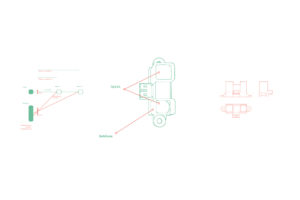
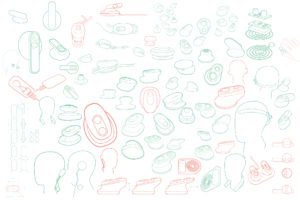
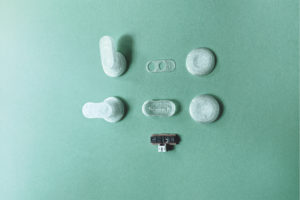
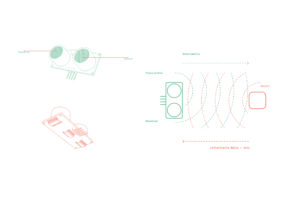
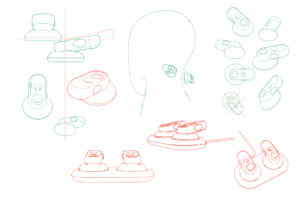

Betreuer
B. Schmidt, I. Harms
cornnie – SEATING FOR CORNER SPACES | Masterarbeit 2019
Der Bereich zwischen dem öffentlichen und privaten Raum werden mit der Zeit immer offener. Die Menschen, die diesen „Zwischen Raum“ benutzen, haben sich diversifiziert. Diese Interaktionen können unseren Alltag bereichern und Inspiration geben, aber führt auch zu Stresssituationen bzw. das Fehlen von kleinen Rückzugsorten.
„Eck-Möbel“ bildet das Konzept dieses Designs, durch diese Reihe von Möbel können Benutzer sich im Ecke-Raum wohlfühlen. Man kann dort einen relativ persönlichen Raum haben, aber es wird keine Tür oder Wand zwischen den Menschen geben. Die Verteilung der Menschen im Raum wird sich variieren, noch dazu werden das Miteinander und die Zurückgezogenheit zwischen Menschen kompletter sein. Die Möbel können auch zeigen, dass nicht nur initiative während der Interaktion sein muss, manchmal müssen wir uns ein bisschen zurückziehen, um uns wohl zu fühlen. Im Gegensatz zur Interaktion, die das gemeinschaftliche Miteinander als Lösung sieht, ist hier die Zurückgezogenheit die Basis von allem.
In dem finalen Entwurf habe ich durch die miteinander-abstimmende Struktur des Objekts und Raums eine Brücke zwischen Objekt und Raum aufgebaut. Weiterhin spielen die Objekte, die ich mitzubringen versuche, eine wichtige Rolle: Sie bilden ein Medium zwischen Mensch und Raum. Die Beziehung zwischen den Beiden verursacht die spezifischen Charaktere des Objektes. Diese Charaktere sind auch Zeichen für die Benutzer, wie sie durch die Führung des Objektes den Raum mit einer anderen Weise nutzen können. Dieser Prozess bietet ihnen eine neue Erfahrung.
The places between public and private space, are becoming more open as time goes on. The people who use these„in-between spaces” are diverse. The interactions in these spaces enrich our everyday lives and provides inspiration, but also lead to stressful situations due to the lack of places to retreat.
Corner furniture builds on these observations. Users can feel comfortable in corner spaces through the use of the seating and can create a relatively personal space there without building a wall between each other. Through the redistribution of people in a space, the togetherness and seclusion between people are more complete. The furniture also shows that we don‘t always need to be proactive in seeking interaction, but can take a step back and make ourselves comfortable. Instead of seeing togetherness as the answer, I’ve focused on our tendency towards seclusion.
The relationship between object and space are used in the final design to create dialogue between them. The objects which I’ve designed play an important role, they create an interface between people and space. This interrelationship leads to the specific characters of the objects, and these characteristics also seem to hint to the user how they can use the space in a novel way. The process empowers the users to experience their environment with a new perspective.
Prozess
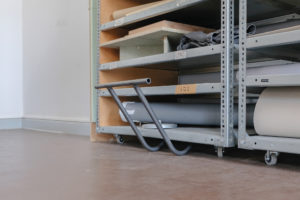



Betreuer
Prof. Ineke Hans, Prof. Axel Kufus
Contact
KLINE | Bachelorarbeit 2019
Mit den raschen Veränderungen innerhalb unseres täglichen (und nächtlichen) Arbeits- und Ruheverhaltens erkennen wir, dass unsere objekthafte Umwelt immer weniger unseren neuen Lebensbedingungen nachkommen kann: So krümmen wir uns in unseren Betten über unsere Laptops oder knicken uns für ein Nickerchen über den Schreibtisch.
KLINE greift in den Raum zwischen Aktivität und Non-Aktivität und schlägt minimalistische Möbel vor, die uns in unseren neuen Arbeits- und Ruhesituationen assistieren sollen. Das Arbeiten aus dem Bett soll weniger als Stigma verstanden werden denn als Forderung nach einer veränderten objekthaften Umwelt, die unserer neuen Lebensweise besser entspricht.
With rapid shifting of working and resting situations we are finding ourselves inside an object environment decreasingly able to accomodate our new lifestyles: Slouching in our beds while responding to emails or hunched over, sleeping at the working desk.
KLINE sees the space-in-between activity and non-activity and offers minimalistic furniture that assists in establishing our newly won work and resting spaces. Working out of bed should not be seen as a dreadful situation per se, but rather as a demand for an ever so slightly change inside our usual object environment to better fit our new lifestyle.
Prozess
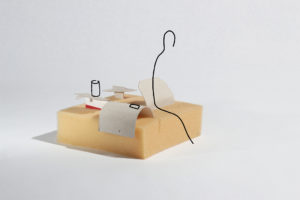
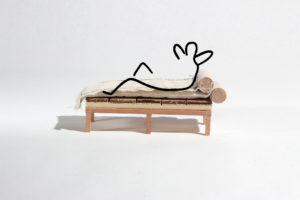
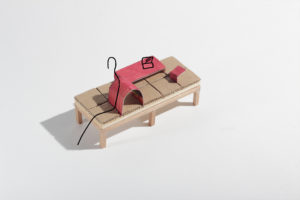
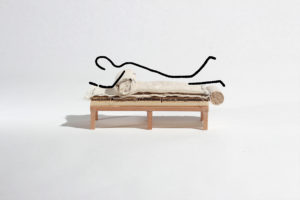
Betreuer
A. Heine, K. Busch, S. -L. Wal
Soft Bodies | Masterarbeit 2019
Nachdem ich der Stillstand der Polstermöbelindustrie, unserer zunehmend nomadischen Lebensweise und die weit verbreitete Wegschmeißkultur im Bereich Haushaltswaren beobachtet habe, entschied ich, dass es einen Bedarf an aussagekräftigen Polstermöbeln gibt, die uns dazu auffordern, eine Bindung zu ihnen aufzubauen, weniger unhandlich und vor allem mobiler sind. Das Ergebnis ist ein anpassbares Sitzsystem aus drei Teilen mit jeweils eigenem Charakter und eigener Funktion für zu Hause, das Büro und das Home-Office.
After observing the stagnation of the upholstered furniture industry, our increasingly nomadic lifestyles and the throw away culture rife in the homeware sector, I decided there was a need for more meaningful soft furnishings which invite us to form an attachment towards them, are less unwieldy and which are more mobile. The result, a customisable seating system comprised of three parts, each with its own individual character and function intended for the home, the office an the home-office.
Prozess
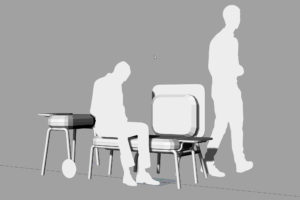
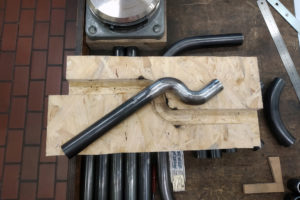

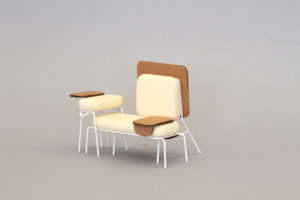
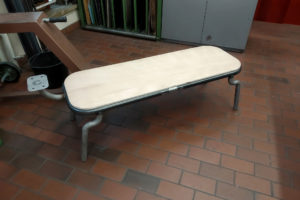
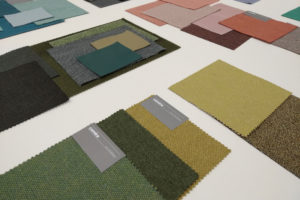
Betreuer
B. Schmitz, I. Hans
Dark Playground | Masterarbeit 2019
ein Bett für die Schlaflosen
Schlaflosigkeit, Prokrastination, Depression. Es sind Erfahrungen der Disfunktion, der Ohnmacht, die einfachsten Dinge zu tun: einschlafen, aufstehen, weitermachen, arbeiten, glücklich sein. Rationalität ist ihnen gegenüber hilflos, sie sind Manifestationen affektiver Kräfte. In diesem Jahrtausend scheinen sie sich besonders schnell auszubreiten, erfassen immer mehr Menschen aus verschiedenen Kontexten. Ganze Gesellschaften, so hört man immer wieder besorgte Stimmen aus den Medien, werden schlaflos, prokrastinieren, werden depressiv. Betten sind die wichtigsten Bühnen dieser Tendenzen. Es ist höchste Zeit sie als Orte des Wandels zu begreifen. Das Problem ist nicht unsere eigene Dysfunktion in der Reproduktion des Alltags, sondern ein Alltag der nicht mehr Zukunftsfähig ist. Dark Playground ist kein Bett gegen die Schlaflosigkeit. Es ist ein Bett für die Schlaflosen.
a Bed for the Sleepless
Sleeplessness, procrastination, depression. They are experiences of disfunction, of the impotence of doing the simplest things: falling asleep, getting up, keep going, working, being happy. Rationality is often helpless, they are manifestations of affektive powers. In this millennium they seem to spread at a very high rate, to affect more and more people from all backgrounds. Whole societies, we keep hearing from the media, are sleepless, procrastinate, get depressed.
Beds are the most important stages of these tendencies. It is time to see them as spaces of change. The Problem is not our own disfunction in reproducing the Everyday, the problem is an Everyday that no longer has a future. Dark Playground is not a Bed against sleeplessness. It is a Bed for the Sleepless.
Betreuer
J. Legrand, K. Busch
PAMPIG | Masterarbeit 2019
Für Juan Garcia ist die Straße ein Museum voller wertvoller Gegenstände, die ihre Bedeutung verloren haben. Aus sein Sicht schaffen diese Objekte eine ganz besondere Ästhetik der Berliner Straße. Er stellte sich die Frage, wie diese Ästhetik in ein Objekt
umgesetzt werden kann um eine Art in Szene setzen der anscheinend kaputten Objekte auf den Straßen fassbar zu machen und hervorzuheben. Das Ergebnis seiner Arbeit zeigt ein besonderes Verständnis des berliner Straßenbildes.
For Juan Garcia, the street is a museum full of valuable objects that have lost their meaning.
From his point of view, these objects create a very special aesthetic of Berliner Streets. He asked himself how this aesthetics could be transformed into an object in order to create a kind of scene for the apparently broken objects on the streets. The result of his work shows a special understanding of the Berlin street scene
Betreuer
H. Neumann, J. Legrand
Kaeru | Masterarbeit 2019
Durch 3D-Druck und Tailored Fiber Placement kann der Rucksack neu gestaltet und auf individuelle Anatomie, Farb- und Featurevorstellungen des Trägers angepasst werden. Sinnvoller Materialeinsatz und eine abfallfreie Herstellung erzeugen ein kreislauffähiges und umweltschohnendes Produkt. Additiv hergestellt und zu 100% aus pflanzlichem Polyamid.
By using 3D-printing and Tailored Fiber Placement the backpack is completely redesigned. It is mass customizable to fit individual anatomy and consumer desires without creating waste during production. Thoughtful material usage enables a circular economy and an environmentally friendly product. Additive manufactured and made of 100% plantbased Polyamide.
Betreuer
B. Schmitz, H. Neumann
Prozess
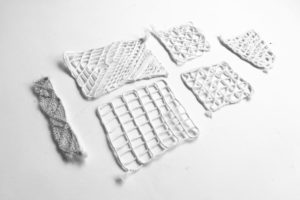


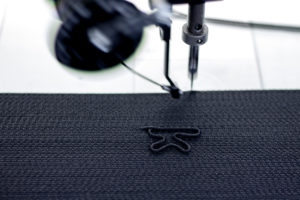
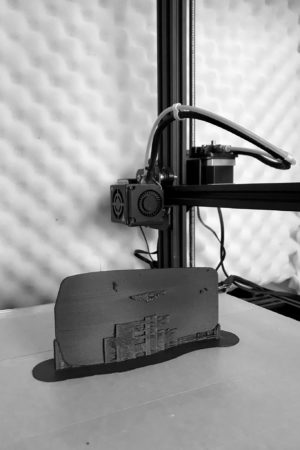

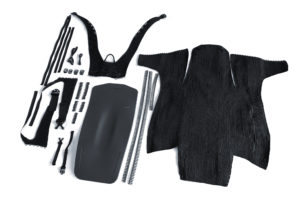
POWERPLACE | Masterarbeit 2019
Das Projekt POWERPLACE untersucht Bedürfnisfelder im gegenwärtigen Lebensumfeld, um für diese innovative Lösungen zu finden. In Feldforschungen wurdenBenutzer beobachtet, wie diese mit Objekten und der Umgebung interagieren. Auffällig ist, dass heutzutage viele Aktivitäten auf Smartphones oder andere digitale Geräte aufbauen oder diese nutzen. In unserem täglichen Leben sind wir auf diese Multimedia-Geräte und damit auf Strom angewiesen. Eine Konsequenz daraus ist ein Chaos von Kabeln, Steckern und Ladegeräten in Privaträumen, Büros und halböffentlichen Räumen. Dieses Projekt konzentriert sich auf die genannten Bereiche und untersucht das Potenzial einer neuen Möbelkategorie, die den dortigen Bedürfnissen entspricht. POWERPLACE bietet ein
puristisches und zurückstehendes Möbelstück, das wie ein gewöhnlicher kleiner Beistelltisch wirkt. Tatsächlich ist das Objekt sehr technisch und kombiniert ein Verlängerungskabel, eine Steckdose, Steuerungstechnik und eine Vielzahl von Steckern und Kabeln in einem organisierten Objekt. Im Gegensatz zu vielen anderen Lösungen, versucht sich das Objekt nicht zu verstecken, sondern sich als neues, eigenständiges Objekt zu etablieren. Es wird zu einem Hybrid, zwischen einem komplexen, technologischen Gerät und einem einfachen, zurückhaltenden Möbelstück und eröffnet so eine neue Kategorie von Möbeln mit dem Hauptzweck, Strom zum Laden aller Arten von Geräten bereitzustellen. Die Nutzungsfelder reichen von privaten Wohnungen, über Cafés, Co-Working Arbeitsplätze und Büros bis zu Hotels. Das Möbel bietet eine Standard-Steckdose, zwei USB-Steckplätze und einen drahtlosen Ladespot. Der integrierte Lithium-Akku garantiert eine hohe Flexibilität und e
rmöglicht den mobilen Einsatz für eine Vielzahl von Situationen.Für die Konstruktion wurde Wert auf die bestmögliche Trennung aller Materialien gelegt.Das Korpus und alle konstruktiven Teile sind aus Aluminium gefertigt, dieses dient auchgleichzeitig zur Kühlung des Akkus. Alle Kunststoffteile sind aus dem gleichen Kunststoff gefertigt und im gleichen Farbton gefärbt. Nach der Demontage haben sie einen Block Aluminium, einen Haufen Kunststoffteile, den Lithium-Akku, Kabel und einige Leiterplatten.
POWERPLACE addresses neglected areas in our present living environments and aimsto afford an innovative solution to modern energy needs. After observing how we interact with our products and our current surroundings, it’s surprising how many activities are built around or involve the use of digital devices. In our daily lives we entirely depend on these multimedia devices and, therefore, on electricity. One consequence of this is a mess of cables, plugs and chargers in private rooms, offices, and semi-public spaces. This project focuses on these spaces and explores the potential for a new furniture category which addresses these needs.POWERPLACE offers a puristic and iconic piece of powered furniture. On the inside theunit is highly technical and combines an extension cord, a power bank, control panels and a variety of plugs and cables, in one reduced object. Compared to many other solutions it isn’t intended to blend in, but to establish itself as a new, much-needed typology. It is a hybrid between complex, technological device and a simple, restrained furniture piece. It opens up a new category of furniture with the main purpose being to provide mobile power to charge all kinds of devices.The fields of use reach from private housing, to cafes, co-working spaces, offices and hotels. Included is a standard power socket, two USB slots and a wireless charting port.The integrated lithium battery guarantees high flexibility and allows mobile use for all kinds of situations.One focus of the construction was to reduce the amount of different materials. The bodyand all supportive parts are made from aluminum. All plastic parts are made out of the same polymer and have the same color treatment. When disassembled one is left with a block of aluminum, a collection of plastic components, the lithium battery, cables and various circuit boards
Prozess
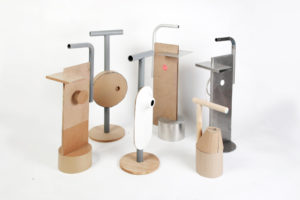

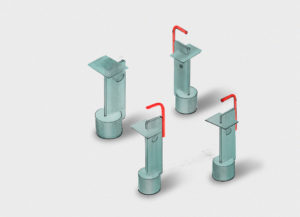
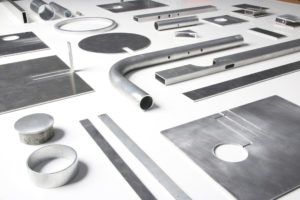
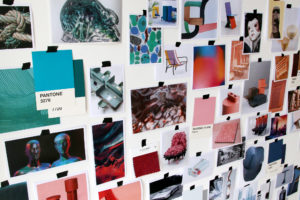
Betreuer
I. Hans, H. Neumann

The collection CYCLE_1 is a contention of the relation between the body and it‘s surrounding space.
How to react to the discrepancy of digital space and the empirical value of clothing in our real world? The collection devises an answer with parameters of functionality and tactility.
CYCLE_1 is showing the process A life cycle and constant renewal. Hereby the body is seen as
a reference to create pieces that function
as a second skin and support every movement the body performs. The reference of construction and functionality creates a surrounding layer and intimate space between the body and it‘s environment.
Betreut von: Prof. Dr. Ingeborg Harms / Prof. Wowo (Waldemar) Kraus / Gast Prof. Franziska Schreiber
Fashion & Concept: Carmen Abele / Photos: Robert Hamacher / Model: Elisabeth Bauer
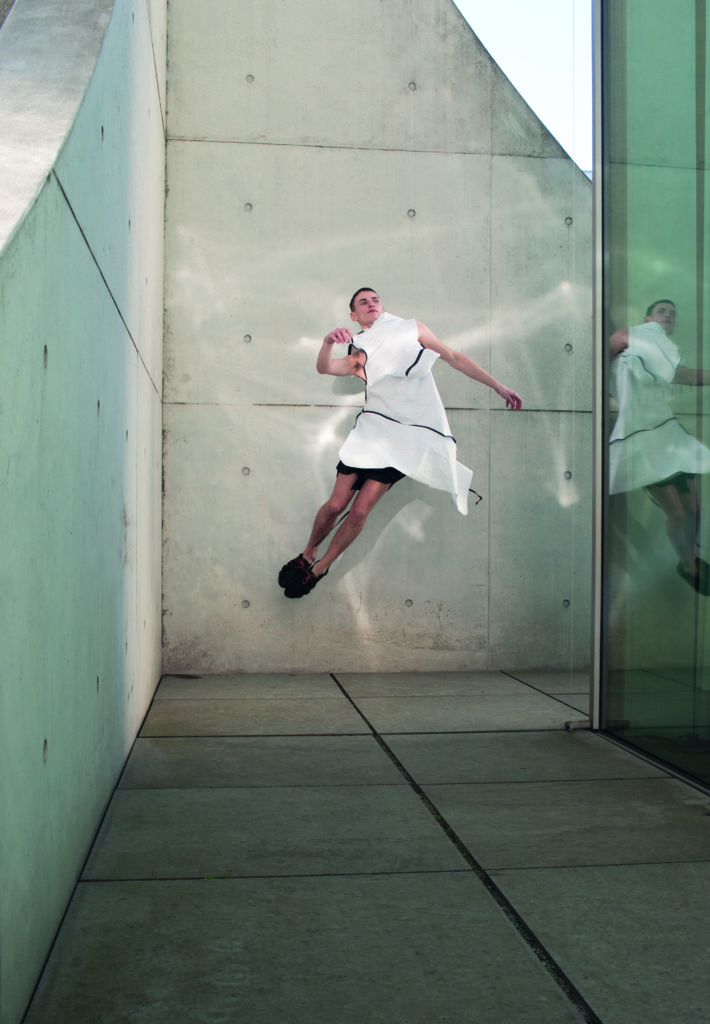
The Body Form Research Project is a future oriented research into new design processes that are closely tied to pattern development. 3D scan technology is used to create unconventional forms of clothing.
The experiment „Body Form Research“ was the point of departure for the whole project. In search of unconventional forms sculptural and abstract form developed in the process. This was achieved through the interaction of material, the human body and movement.
A measuring of the body forms and silhouettes by means of the 3D scan is necessary to capture new Modelllinien via the elastic textiles. The goal is to create 3D computer models in form of CAD data that can be used to create patterns. In comparison to traditional methods this technique enables a new and freer way of pattern construction.
In search of a new approach in fashion that includes the process and product equally I created new objects that I call „artifacts“. They are the synthesis of the flowing forms of spontaneous movement and conventional industrial and technical tools. Amorphous forms meet hard edges.
The deformation based on BFR confronts the western idea of the perfect body. BFR offers a variety of possibilities to find new forms of clothing and research the fashion body of our time.
Betreut von: Prof. Wowo (Waldemar) Kraus / Prof. Jozef Legrand / Gast Prof. Carolin Lerch
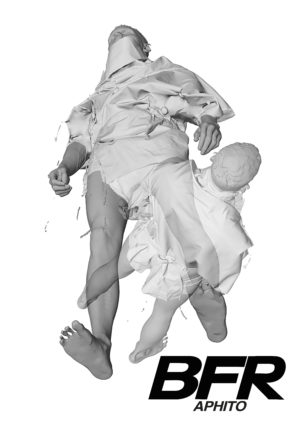
Teaser: Creative Direction: Daniel Juhart / Editorial and Camera: Jan Christian Propfe / Assistant: Alexandra Elli Mümmler / Fotos: Torben Becker / Protagonists: Melodi Yüce and Antonio Braune / 3D Scans: 3D Laser Scan Berlin
The Experiment – Fotos: Torben Becker / Model: Melodi Yüce and Antonio Braune
Fashion & Concept: Daniel Juhart, Fotos: Emi Maria Bohacek emimariabohacek.com, Model: Jozef Roth
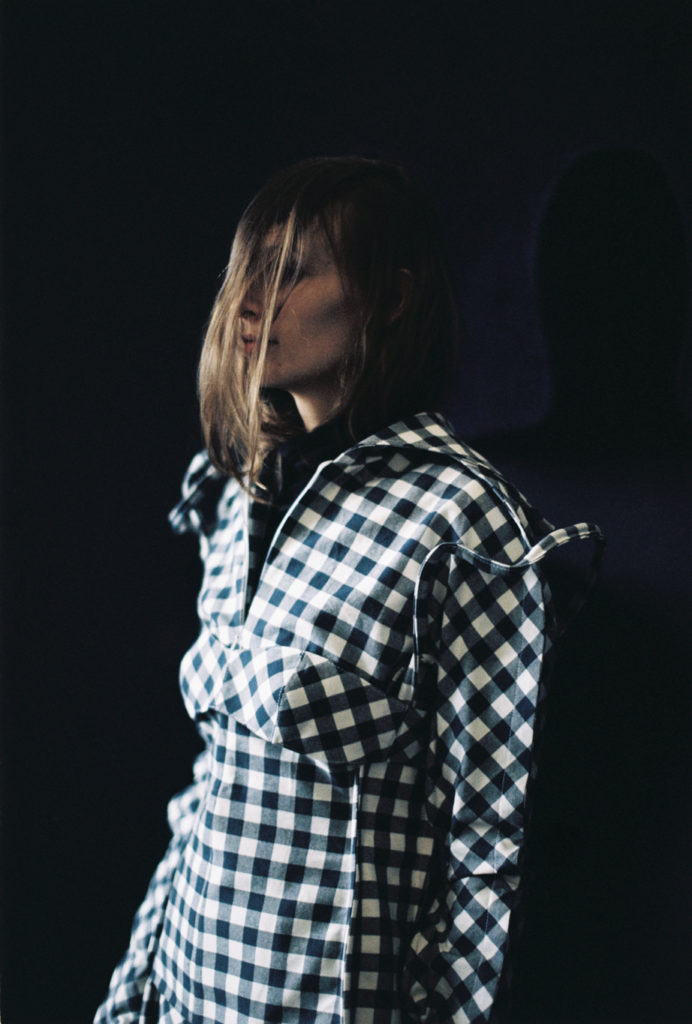
Wenig ausgefallen, versuchen wir uns im Hier und Jetzt eher unauffällig in ein einheitliches großes Ganzes einzugliedern. Individueller Geschmack weicht uniformer Einheitlichkeit und deckungsgleichen Kleiderformen, während wir uns in einer von Widersprüchen geprägten Gegenwart befinden: Wir verzeichnen einerseits zunehmend den Drang zur Selbstverwirklichung und Einzigartigkeit, andererseits begehren wir den Durchschnitt.Die Währungen mit denen sich der postmaterielle Mensch Status verschafft heissen dabei weiterhin Individualität und Persönlichkeit – Vielmehr jedoch tendieren wir dazu, uns durch vorbildliche Anpassung und Eingliederung auszuzeichnen. Um es mit den Worten Miuccia Pradas auszudrücken: NOW IS NOT THE TIME FOR CRAZY.
Betreut von: Prof. Wowo (Waldemar) Kraus / Prof. Dr. Ingeborg Harms / Prof. Jozef Legrand
Photos: Brinkley Capriola / Model: Petra Geyer / Fashion: Katharina Heinze
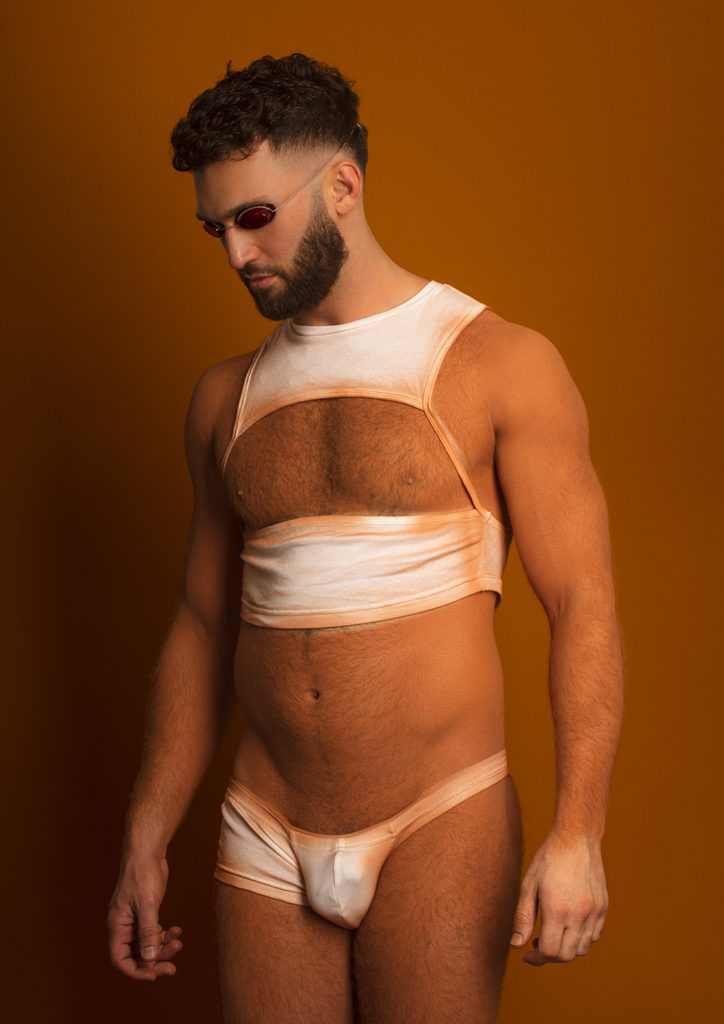
Betreut von: Gast Prof. Franziska Schreiber / Prof. Jozef Legrand / Gast Prof. Carolin Lerch
Photos: Moritz Haase / Fashion: Jan Geiger Dedio
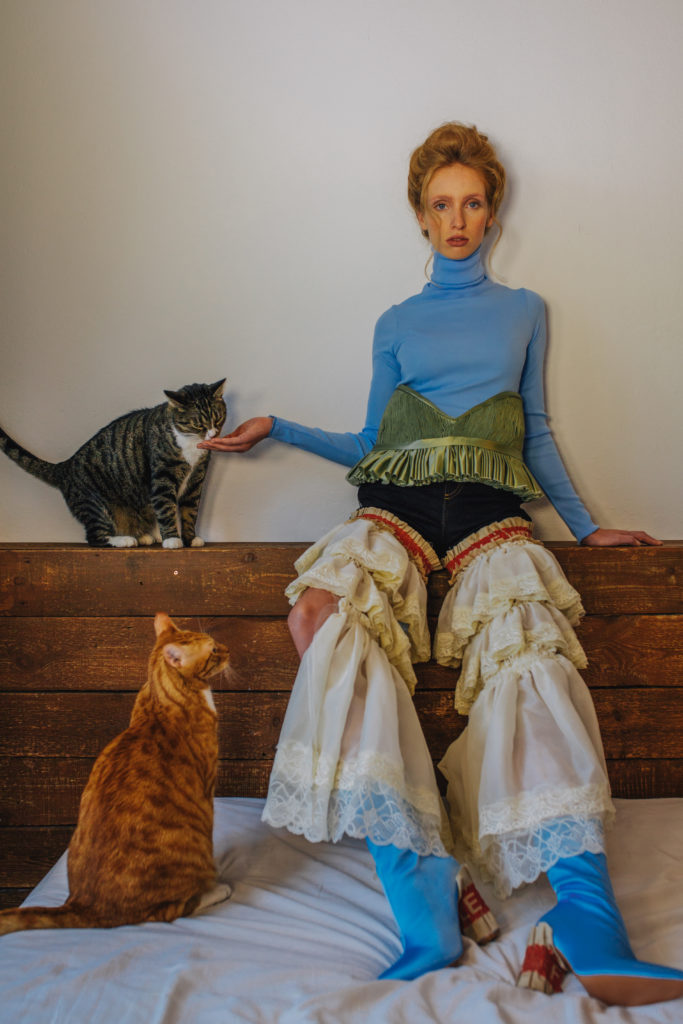
FRAGILE HANDLE WITH CARE tells a story of rich, hysterical women from the 19th century. The collection combines clothing for people with and without disabilities, Victorian fashion and a snappy petting zoo.
Betreut von: Prof. Wowo (Waldemar) Kraus
Fotos: Viktoria Nowicki, Model: Louise Fankhänel, Make-Up: Callum Norris, Hair: Kübra Topcu
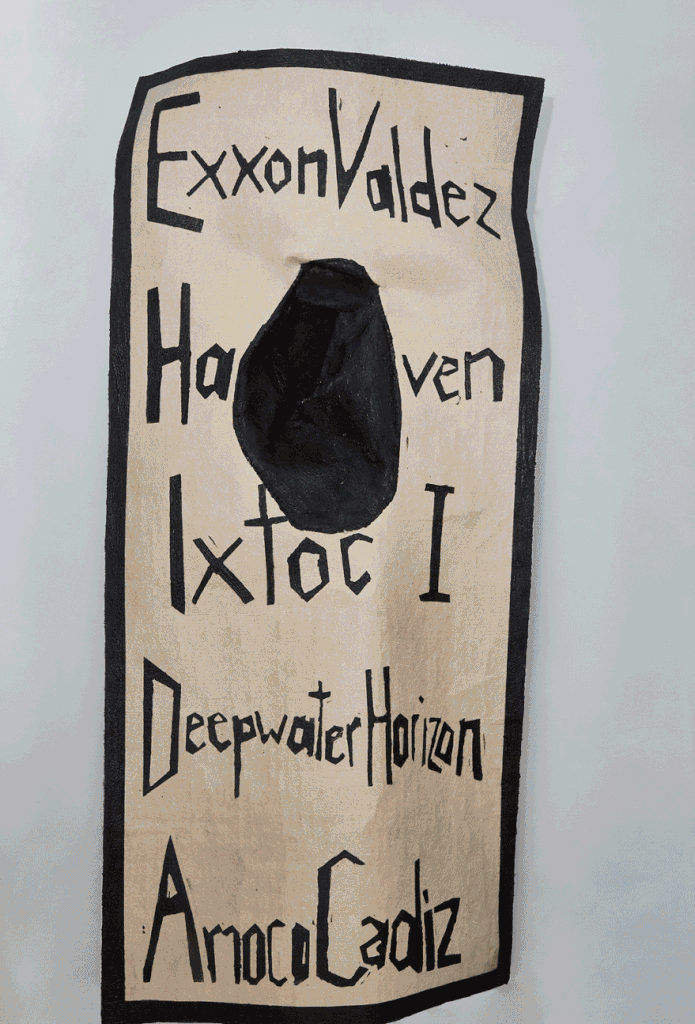
Wie können wir Protest über Kleidung kommunizieren?
Wie präzise funktioniert die Sprache der Bekleidung?
Nahezu jedes Kleidungsstück, das einmal mit einer politischen Intention getragen wurde, findet sich mittlerweile in den Regalen von Fast-Fashion-Shops bis Luxusläden wieder. Rebellion ist sexy und so wird alles, was damit zusammenhängt, kommerzialisiert. Was passiert, wenn Mode sich selbst kritisiert? Welche Symbole entstehen, wenn die Kritik der öko-fair Konsumierenden in Konsumobjekten versprachlicht wird? Wenn selbstkritische Objekte die Welt des Konsums unterwandern…
How can we communicate protest with our garments?
How does the language of dress work?
Almost every piece of clothing that was once worn with a political intention can now be found on the shelves of fast fashion shops and luxury stores. Rebellion is sexy and so everything connected with it is commercialized. What happens when fashion criticizes itself? What symbols are created when the criticism of eco-fair consumers is translated into objects of consumption? When self-critical objects infiltrate the world of consumption…
https://selbstkritischeobjekte.myportfolio.com/
Betreut von: Prof. Carolin Lerch / Prof. Jozef Legrand / Prof. Dr. Ingeborg Harms
Photos: Seb Winter / Fashion: Lea Maria Wittich
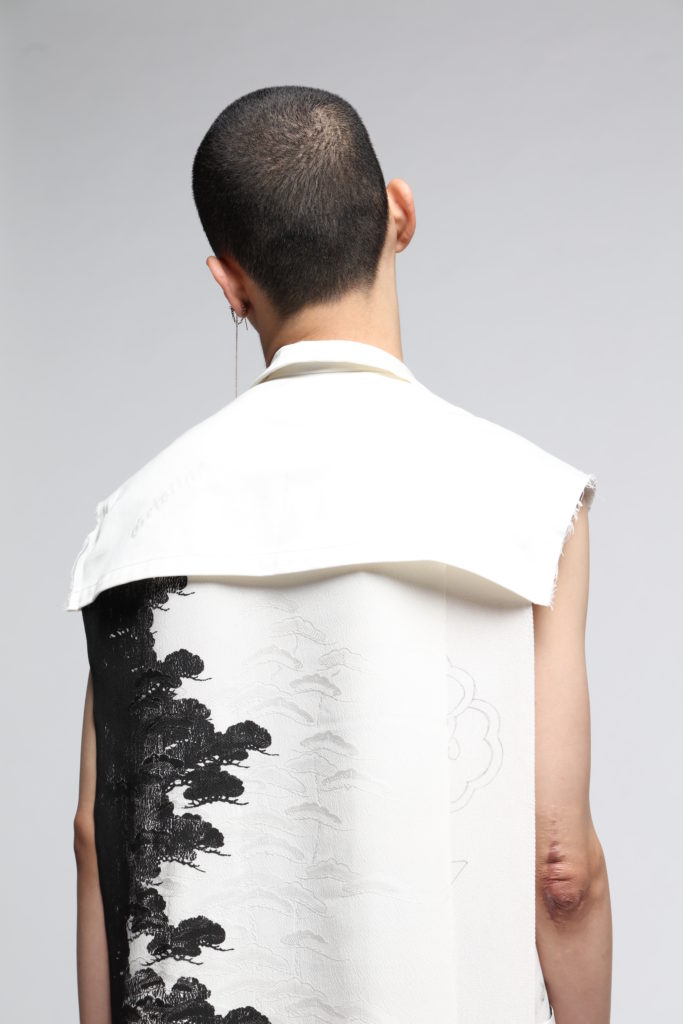
What is the significance of materials, traditions and skills? What role does crafting and craftsmanship play in the age of digitization, hypercapitalism and automatism?
Yuzen, a craft that visually captures Japan‘s traditional motifs on silk, is an endangered art. The scope of application is in many cases limited to the decoration of kimonos. In this way, Yuzen is a symbol of a never-changing, endangered craftsmanship. By exploring this craft, I hope to open it up to other uses and thus to show a way to save the craft in general in the 21st century. This collection serves as a reference and reminder of the awareness of the long-lived and timeless quality of artisanal products that today‘s society has lost.
Betreut von: Prof. Valeska Schmidt-Thomsen / WM Martin Beck / Mads Dinesen

– Live Sculpture Work –
Copper Mesh x Reformed Clothes
De Regno Hominis
Man is blinded and stupid.
This effigy.
Instead of sincere exposure, genuine nakedness and courage to self-confrontation, he prefers to succumb to his weaknesses over and over again. Instead of admitting himself. To see what is. What always was. Rigorousness drives him. He has become absorbed by a phantasy, by the perfectly constructed ideal of himself. He forces himself to eternal suffering, lashes himself through the years of life-centuries, through evolutions and revolutions, dies in wars against himself, kicking the bucket on his own blade. Desperately disbelieving, he replaces the valuable with the worthless. Strong with weak. Meaningful with meaningless. Playing with himself and himself against himself. And in the search for satisfaction, for salvation, he hurts because there is no answer. But hurting fuels him. Drives him forward. But the void remains. The notion of im
perfection. He fears the nothing. Uncontrollable, intangible. Fear of uncertainty. Fear of destitution. Fear of weakness. Fear of loneliness. Fear of decay. Fear of his empty death. Fear of his nothingness. Provokes him to control what he can contain. He feeds on his sincere habitat and devours its honest selflessness. He subdues everything, diverse, natural, artificial, everything. Nature, hope, life. Strengthening and devitalizing oneself. The disembodied, worthless sought-after becomes imediate. You and me and them and they. The nothingness that has always been, is still, but less. The price is higher, as he meters himself with what, in the search of nothingness, has been lost. What can not be anymore. Space and time are different. To find what counted to be found, is lost. The path does not lead back.
What am I sick of?
by Christine Sattler @lolaalookingforlunicorns | | christinesattler.com
special acknowledgment: Dorothee, Heike, Julia Bajanova @_bajanova_, Clara @cralacrala, Anna @a.lu.si, Carmen @carmen.abele, Mia @lulu.mia.linda, Freddy @feuriger_engel13, Joy, Ilona @ilona_karacsony, Lea @lmrwttch, Jan @la.tranga.estefania, Kai @kaigerhardt_official
Betreut von: Prof. Jozef Legrand / Gast Prof. Carolin Lerch / Prof. Wowo (Waldemar) Kraus
Photos: Golo Pauleit @golo.pauleit / Models: Léon C. Romeike @leochrom @tomorrowisanotherday_agency, Amra @amralicious @letitgomgmt / Fashion: Christine Sattler
Holz und Wasser | Bachelorarbeit 2019
Die Arbeit „Holz und Wasser“ setzt sich mit der Fragestellung auseinander, wie der Werkstoff Holz in der Industrie und im Handwerk verarbeitet wird. Es untersucht die natürlichen Eigenschaften und Eigenheiten des Holzes und wie Holz auf seine Umgebung eingeht und mit Quellen, Schwinden und Verziehen reagiert. Aus dieser Fragestellung ist eine Experimentelle Möbel – und Objektreihe aus Vollholz entstanden, die sich mit der natürlichen Formgebung des Holzes auseinandersetzt und diese unterstützt. Dem Holz wird in dieser Reihe von Objekten und Möbeln die Möglichkeit gegeben, sich zu bewegen und sich natürlich zu formen und so einen Teil des Gestaltungsprozesses der Objekte und Möbel zu übernehmen.
„Holz Und Wasser“ deals with the question of how the material wood is processed in the wood industry and in the crafts. It examines the natural characteristics and peculiarities of the wood and how wood affects its environment. From this question an experimental furniture and object series was created, which deals with the natural shape of the wood and supports it.
Prozess
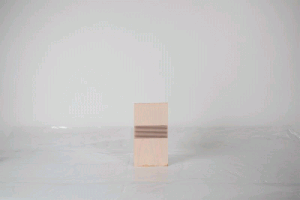
Betreuer
Prof. Ineke Hans, Prof. Holger Neumann, KM Julian Ribler
Führungen durch Ateliers und Werkstätten: mehrmals täglich
Treffpunkt: Eingangshalle
Das Basislabor vermittelt die Einführung in den Entwurf als individuellen dialogischen Gestaltungsprozess über Erfahrungsfelder, differenzierte Selektion, qualitative Modellentwicklung und Reflexion.
Haus-Agenten
Erstsemester Grundlagenprojekt
Foto und Video Dokumentationen/Ausstellung
Prof. Robert Scheipner
Raum 00b
Alien – Ästethik des Fremden
Die Zweitsemester befassen sich im Basisprojekt Produkt über die Verbindlichkeit eines Partners mit einem spezifischen Kontext im 3D-Haus.
Prof. Robert Scheipner
Raum 008 & anderswo
Wenn du nicht artig bist, kommst du ans Bauhaus!
2. Semester, Modedesign
In diesem Projekt wurde in geometrischen Formen mit sich veränderbaren Materialien gearbeitet, die auf Temperatur, Lichtverhältnisse und Wasser reagieren. Die Entwürfe wurden performativ in einer Videoarbeit inszeniert.
Prof. Wowo (Waldemar) Kraus
Diese Ausstellung findet nicht in der UdK Berlin statt!
Ausstellung: the temporary bauhaus-archiv/Museum für Gestaltung
Knesebeckstraße 1-2, 10623 Berlin
Öffnungszeiten: Täglich außer sonntags, 10–18 Uhr
Status of Libertine
3. Semester
Dieses Entwurfsprojekt sucht die Unabhängigkeit in Abhängigkeiten und schöpft dafür aus rein persönlichen Interessen und Affinitäten. Ausgehend von Collagen wurde eine gestalterische Position definiert, die dann über eine dreidimensionale Skulptur hin zu einem vollständigen modischen Look übersetzt wurde.
Prof. Carolin Lerch
What If? – Utopien digitaler Körperlichkeit
4. Semester
Die digitale Immersion erobert zunehmend den Alltag und schreibt die Beziehung zwischen Menschen und Technik um. Architekturen, Erlebbarkeiten und Abhängigkeiten von Körpern in Raum und Zeit verändern sich. Modedesigner gehen in der Regel vom natürlich menschlichen Körper als Zeichenfläche aus. Was wäre, wenn nicht? In diesem Projekt sind hypothetische Gestalten entstanden, die die Grenzen zwischen real und irreal, zwischen materiell und immateriell, zwischen humanoid und technoid verwischen.
Prof. Franziska Schreiber
Prof. Berit Greinke
Back to the Future 411a
5. Semester
Das Zeitschriftenarchiv 411a ist ein unentdeckter Schatz. Die Retrospektive in die damaligen Modevisionen, in die prä-digitalisierte Welt, in der der Zufall und die Zeit noch keine so große Rolle spielten, weckte Neugier und Fragen.
Prof. Valeska Schmidt-Thomsen
Prof. Wowo (Waldemar) Kraus
Word up!
6. Semester
In Zweierteams entwickelten Studierende des Modedesigns und der visuellen Kommunikation Konzepte und Outfits, die sich mit den kommunikativen Potentialen von Bekleidung beschäftigten.Fotografische Inszenierungen sowie Dokumentationen zum Entstehungsprozess der Projekte veranschaulichen diese interdisziplinäre Kooperation.
Prof. Valeska Schmidt-Thomsen
KM Pascal Kress
Dissection-Regeneration
6. Semester
Ein geschneidertes Sakko diente als Ausgangspunkt für die Recherche und Auseinandersetzung mit Qualität, Materialität und Verarbeitung als elementarem Wert von beständigem Design. Davon ausgehend entwarfen die Studierenden eine Kollektion und fertigten ein Kleidungsstück mit traditionellen Schneiderelementen.
Gastprof. Deepti Barth
Okto-Referenz- Nahfeldaudiomonitor
Als freies Projekt entwickelte Tizian Heinsohn ein high-end Referenzlautsprecher, der in professionellen Studios Anwendung finden soll und durch seine ungewöhnliche Form perfekte Klangwiedergabe gewährleistet.
Prof. Achim Heine
Raum 402
»UDKPM«
Unter dem Label »UDKPM« kooperierten die Studierenden mit der Königlichen Porzellanmanufaktur. Das Projekt bezieht sich auf die Innovationskraft des Bauhaus als Labor, als Ausbildungsstätte, in der experimentell versucht wurde, die Grenzen konventioneller Gestaltung aufzubrechen.
Prof. Achim Heine
Raum 402
The Invisible Home – Zwischen Transparenz und Camouflage
Studierende (4./6. Semester) untersuchen, inwieweit unsere alltäglichen Dinge verschwinden können, unsichtbar werden, ohne ihre Präsenz zu verlieren.
Prof. Achim Heine
Raum 403
T.O.D. – Temporary Options of Dying
In diesem interdisziplinären Kooperationsprojekt zwischen Mode- & Produkt-Design und der Design-Theorie entstanden Arbeiten, die sich mit dem Tod in verschiedenen Perspektiven und gesellschaftlichen Dimensionen auseinandersetzen.
Prof. Axel Kufus
Prof. Wowo Kraus
Prof. Dr. Kathrin Busch
Raum 116a
ALCHEMISTICS – Neue Stofflichkeiten und ihre experimentellen Anwendungs-Szenarien
Die Studierenden präsentieren die Ergebnisse einer alchemistischen Forschung, die die Transmutation und Transformation von Materialien in den Fokus stellt und in ihren experimentellen, kritischen bis hin zu spekulativen Projekten neue Möglichkeiten zeigen.
Prof. Axel Kufus
Raum 117
NEW GROUNDS
Recherche von hochaktuellen Designthemen wie Digitalisierung, neue Herstellungsweisen,Lebensmittel, Abfall, Klima und Soziale Veränderungen und Erforschung neuer Strategien zur Entwicklung zukünftiger Objekte mit Impakt.
Prof. Ineke Hans
Räume 202 und 203
POP-UP
Zwei ‘freie Projekte’. Aus dem Wintersemester: ein Vorschlag für Pop-Up Fashion Stores mit ‘REALLY’, einem neuen nachhaltigen Material aus wiederverwendeten Textilien. Aus dem Sommersemester: die neue Pop-Up-Bibliothek der UdK Berlin.
Prof. Ineke Hans
Räume 202 und 203
STANDARD
Eine Einführung in die Standards, die uns im Alltag umgeben, die man als Designer kennen soll und verwenden kann. Zu sehen: Kurzzeit- und Langzeit-Projekte, die weit vom Standard entfernt sein könnten.
Prof. Ineke Hans
Räume 202 und 203
Jeder von uns hat seine Geschichte vor dem jeweiligen kulturellen Hintergrund mitbestimmt. Die Erforschung der eigenen Identität, im Dialog mit anderen, mündet in unterschiedliche gestalterische und performative Projekte.
Showwalk: Ein vielschichtiges Programm aus Filmen, Projektpräsentationen, Catwalkmomenten und performativen Interventionen aller Semester (BA/MA) und Abschlussarbeiten.
Das Portfolio Projekt
Secret Needs of Normal People
C.T.F.P.L.O.T.D.S.O.T.M.
Non Identified Pets
Getting there. Ankommen.
Es ist meine Zukunft
Looking for my Family (45 min.)
Prof. Jozef Legrand
Raum 002 und 003, EG
So 14 Uhr
Ausgewählte Arbeiten zu folgenden Themen:
THINKERS PARADISE – Ein Möbel für den kreativen Prozess aus gefaltetem Blech. Mit Unter-stützung der Fa. System 180, Berlin. SUPERPLY – Material- und Formexperimente mit dem neuen Werkstoff UPM Grada.
PROJEKT P.L.U.S. – my personal sunshade. Kunststoff-Gießen und -lasern als technologische Vorgabe für individuelle Sonnenbrillen. MATERIALLABOR METAL PRINTING – Neue Anwendungsmöglichkeiten und experimentelle Ansätze für den Metall- und Keramik 3D-Druck.
Prof. Holger Neumann
Raum 407 und Flur im 4. OG
Eine Auswahl an Abschlussarbeiten vom Wintersemester.
Aula 401
Produktdesign Master
Masterstudierende zeigen in offenen Ateliers den Stand ihrer aktuellen Arbeiten.
Raum 204
Masterarbeiten Sommersemester 2019
We are in this together
Design und Interkulturalität.
Work in Progress
Raum 102
SCHAU19
Präsentation der Projekte und Abschlussarbeiten des Institutsfür experimentelles Bekleidungs- und Textildesign der UdK Berlin. Tickets unter udk-schau.de
Vor dem Gebäude STR 118
Sa 20 Uh
Siebdruckwerkstatt und Färberei
Technologieseminar: “Textile Stories”
Ziel war es, mit mehreren textilen Techniken zu experimentieren, diese zu verbinden und ein Accessoire oder textiles Objekt zu entwickeln.
Dipl. Des. Julia Kunz
Raum 317a und 318
Werkstatt Weberei
Technologieseminar: „Crafting N°1 – About Identity and Community“ – Stricken, sticken, quilten, weben
Die Studierenden waren aufgefordert, textiles Handwerk mit Fragen zu Geschlechterrollen und -identitäten in einer künstlerischen Arbeit zu verknüpfen und Position einzunehmen.
Dipl. Des. Christina Klessmann
KM Evelyn Sitter
Raum 314 L
Werkstatt Strickerei
Technologieseminar “chaotic structures”
Ausstellung von Strickproben und gefertigten Teilen.
Lehrbeauftragte Jennifer Rippel
Raum 314 R
Werkstatt Näherei
Dorothee Warning und Stefan Hipp
Raum 305

Absolvent*innen des Studiengangs Produktdesign BA der UdK sagen CIAO!
Sie zeigen im Kontext des UdK Rundganges (12.–14. Juli) ihre Projekte zu aktuellen Themen wie nachhaltige Materialien, konzeptuelles Design, Forschung im 3D Druck und Möbel Design.
BA Product design graduates from the UdK say CIAO!
They present in the context of the UdK Open Days (12–14 July) their projects to current topics such as sustainable materials, conceptual design, research in 3D printing and furniture design.
Vernissage: Dienstag, 09. Juli, 19:00
Aperitivo: Samstag, 13. Juli 2019, 14.00–17:00
Ausstellung: 10.–14. Juli 2019, 10:00–18:00
BAs: Emilia Knabe, Charlotte Marabito, Marie Scheurer, Sophie-Katharina Stanitzek, Marie Radke, Niklas Böll, Moriel Blau, Milan Friedrich, Laureanne Kootstra, Cathryn McAnespy, Katharina Bellinger
Sitcom | Bachelorarbeit 2019
Die Stadt ist ein Ort der Vielfalt. Immer mehr Bürger*innen wollen bei der Stadtgestaltung mitreden und mitdiskutieren. Um ein breiteres Publikum zu gewinnen, finden Beteiligungsformate zur Stadtentwicklung oft im Freien statt. Diese Veranstaltungen brauchen sensibel gestaltete Orte, so können Strukturen in der Kommunikation gefördert werden. Im Zentrum des Zusammenkommens und Redens steht auch die Sitzgelegenheit. Je nachdem wie sie gestaltet ist, wird die Gesprächskultur beeinflusst.
Sitcom steht für “Sit & Communicate”, denn hierum geht es. Die Rundung der Bänke macht es möglich sie zu einem Kreis zusammenzustellen – der Beginn einer jeden Gesprächsrunde. Je nach Bedarf können größere Formationen erstellt werden. Das Design von Sitcom ermöglicht flexible Sitzstrukturen für unterschiedliche Gelegenheiten, z.B. im Kontext von Workshops. Feste Formationen benötigen einen Verbinder um den Aufbau zusammenzuhalten. Anders als herkömmliche runde Bänke ist Sitcom mobil und stapelbar. Sie ist durch die Wahl von nachhaltigen und neuen Materialien extrem witterungsbeständig und komplett recyclebar.
The City is a place of diversity. More and more citizens want to have a say in planning their urban environment. Formats of participation dealing with city planning take place outdoors in order to reach a wider audience. These events need sensitively designed places to foster a structure of communication. On the subject of getting together and communicating there is also the question of seating. According to its design, the culture of discussion can be affected.
Sitcom stands for “Sit & Communicate”, because this is what it’s all about. The round form of the benches facilitate a circular arrangement which enables discussion. Various and bigger formations can be built upon need. The design of the benches provides flexibility for use in many occasions, for example within workshops. Certain formations of the benches require use of the connectors to stabilise the desired seating structure. Compared with conventional round benches Sitcom is mobile and stackable. Through the choice of using sustainable and new materials it is extremely weather-resistant and fully recyclable.
Prozess
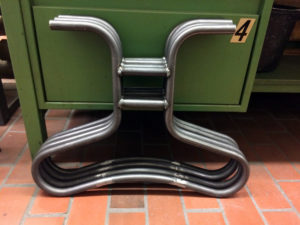

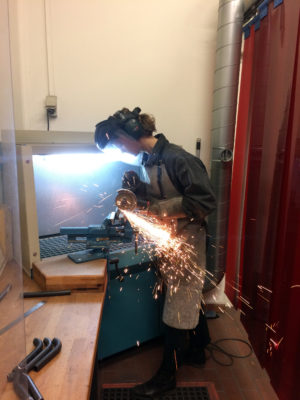
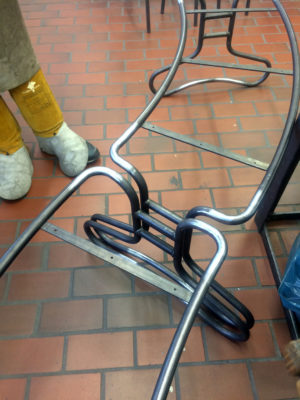
Betreuer
Prof. Ineke Hans, Prof. Holger Neumann, Prof. Axel Kufus
Credits
Bilder: Manuel Meinhardt
compliance | Bachelorarbeit 2019
Turning off the alarm clock, pulling up the window shades, pushing the button of the coffee machine, opening and locking the door, changing the gears, tapping on the keyboard, unscrewing the wine bottle, switching off the light — all are common daily routines. These routines have one common single success-enabling factor — mechanisms. These products are made possible by their incorporation.
Mechanisms are found everywhere. They are small devices with high mechanical demands. Mechanisms that gain some or all of their motion through the deflection of their flexible members are classified as compliant mechanisms. This subcategory of mechanisms dispenses with the traditional joint-concept while relying on control over the material and its reversible deflection. Accordingly, the decisive component of these mechanisms is their geometry. This results in a dependency of form and function. The design of the compliant mechanism’s form alone decides on the type and quality of its function. Crucial to the behavior of these forms is their geometrical configuration. One continuous monolithic geometry emerges by omitting joints and rigid connections.
This reduces the number of components to only one, while simultaneously equipping it with a mono-material property.
“compliance“ is a research project in the field of flexible, one-piece mechanisms, proving that the task to be performed by the traditionally constructed mechanism can be replaced by a flexible and resistant structure — a compliant mechanism. For this purpose, the designed and manufactured objects were constructed from a monolithic and continuous geometry.
Mechanisms with a compliant behavior often provide significant advantages, such as a reduction of components, simplified manufacturing, no assembly, less or no friction, less or no wear, no lubrication, high precision, compactness, miniaturization, light weight and lower costs.
By reducing the number of components to one, a globally distributed production, the subsequent shipment, the possible storage of individual elements before assembly and the assembly itself, is eliminated. Thus, the complex logistics of contemporary production would be eliminated, resulting in a reduction of the ecological footprint of these products.
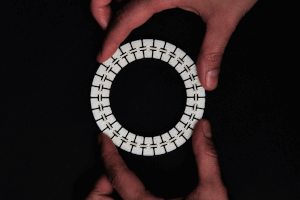
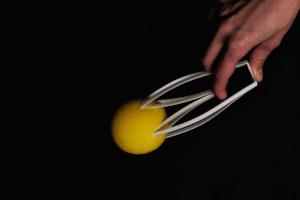
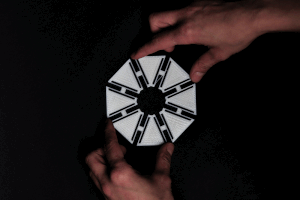
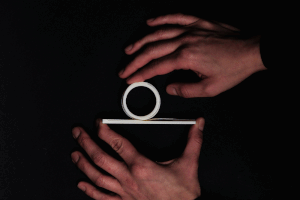
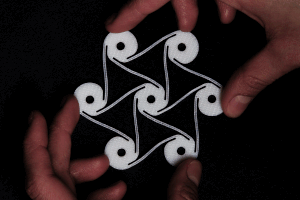
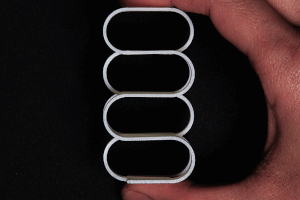
Betreuer
Prof. Burkhard Schmitz, Prof. Holger Neumann, KM Antonia Kühne
Credits
Fotos: Adrian Escu
About Chaos | Bachelorarbeit 2019
‚Familie Hempel‘ ist eine Hommage an den ‚Klamottenstuhl‘.
Dieses eine Möbelstück, worauf Kleidung abgelegt wird, die schon getragen ist aber noch nicht gewaschen werden muss. Auf den ersten Blick sieht dieser Stuhl nach absolutem Chaos aus. In Wahrheit jedoch hält er die Ordnung aufrecht. Sein einziger Makel: Man kann nicht mehr auf ihm sitzen.
Mit der Familie Hempel wird der Klamottenstuhl aus einer Grauzone geholt. Um gegen den immer größer werdenden gesellschaftlichen Ordnungszwang à la Marie Kondo anzugehen bietet die Möbelkollektion Raum um Chaotisch zu sein.
Familie Hempel ist eine Kollektion bestehend aus vier Möbelstücken:
Einem Hocker, einem Pouf, einer Bank und einem Hochsitz, an und in denen man Kleidung unterbringen kann.
Familie Hempel is a Hommage on the classic pile of clothes on a chair.
This Special Chair where you put clothes on which are already worn but still not ready for the washing machine. This chair looks like absolute chaos. But to be true: its pure organisation. The only problem is that you can not use it as a chair.
Familie Hempel drags this kind of chair out of the grey area. The collection rebels against the pressure of a society which aims for a ‚Marie-Kondo-like‘ perfection. Familie Hempel provides space to be chaotic. The title is inspired by an old german saying, shouted out when somebody sees a messy room: „Bei dir sieht es ja aus wie bei Hempels unterm Sofa!“ („Your room looks like family Hempel’s place!“)
It’s a collection of 4 members:
A stool, a pouf, a bench, and a high seat, where you store clothes.
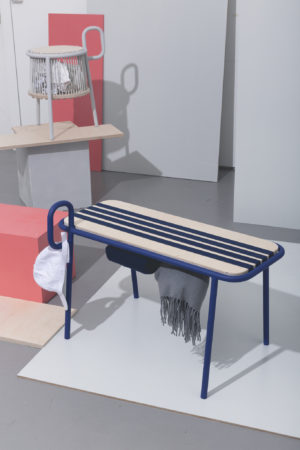


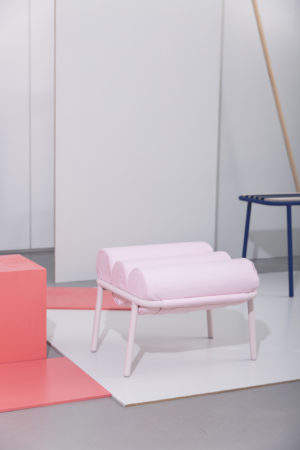
Prozess
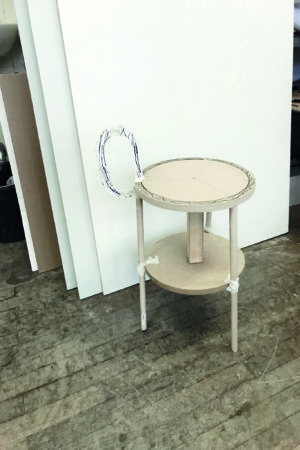
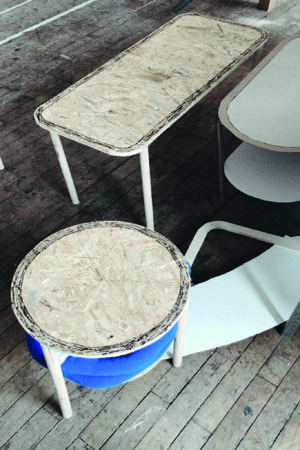

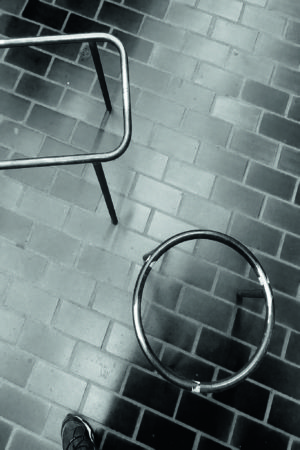
Betreuer
Prof. Ineke Hans, Prof. Jozef Legrand, Prof. Holger Neumann
Credits
Fotos: Arda Funda
Der Stuhl als Medium zwischenmenschlicher Interaktion | Masterarbeit 2018
Stühle – Am Ende jedes Tages werden wir auf verschiedenen Stühlen gesessen und diverse Aktivitäten mit und auf ihnen verrichtet haben. Diese Stühle beeinflussen unsere Körperhaltung. Doch welche weiteren Einflüsse gehen von diesem M.belstück aus? Kann ein Stuhl möglicherweise auch auf die Beziehungen zwischen Menschen einwirken?
„MAZU“ ist ein Stuhl, auf dem zwei Personen zusammen sitzen. Der Aufbau folgt dem Prinzip einer Schaukel, die sich spielerisch hin und her bewegt. Spielen ist eine Interaktion, bei der Menschen die gleichen Dinge gemeinsam erleben und die gleichen Gefühle fühlen können. Also versuchte ich, menschliche Interaktion durch einen Stuhl mit Spiel auszulösen. Beide Personen sitzen Vis-à-Vis, was es leichter macht, einander zu sehen und die Bewegungen und das Gleichgewicht interaktiv aufeinander abzustimmen. Bei diesen „kooperativen“ Spielgeräten wird in uns die Freude über die zusätzliche zwischenmenschliche Interaktion entfacht. Als Medium wird „MAZU“ mit zwei sitzenden Menschen interagieren und die Kommunikation verstärken. „MAZU“ ist nicht nur ein Stuhl, sondern fungiert auch als Trigger, der die Emotionen der Menschen auslöst.
Chairs – At the end of each day we will sit in different chairs and do various activities with and on them. These chairs affect our body. Does the chair affect only the human body? Or can chairs affect the relationships between people?
„MAZU“ is a chair on which the two sit together. This chair uses the principle of a swing that moves back and forth and is playful. Playing is an interaction where people can experience the same things together and feel the same feelings. So I tried to trigger human interaction through a chair with play. In addition, the two sit in vis-à-vis, which makes it easier to face each other and to control their movements through the balance and interaction of the two seated. In these „cooperative“ gaming devices, the joy of the additional interpersonal interaction is kindled in us. As a medium, „MAZU“ will interact with two seated people and enhance communication. „MAZU“ is not only a chair, but also acts as a trigger that triggers the emotions of the people.
Prozess
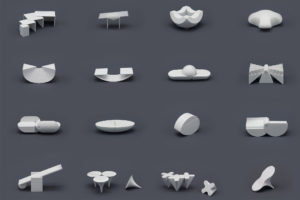
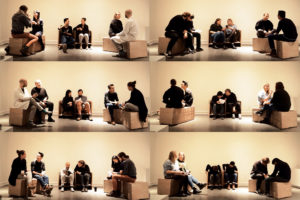

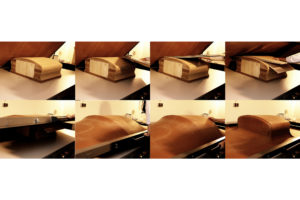
Betreuer
Prof. Burkhard Schmitz, Prof. Holger Neumann
Kontakt
Rekettle | Bachelorarbeit 2019
Rekettle ist ein modularer Wasserkocher mit dem Fokus auf ein langes Produktleben. Er stellt eine Alternative zu herkömmlichen, monolithischen Wasserkochern dar, die sich aufgrund ihrer Konstruktion und Materialwahl nicht reparieren lassen und stetig zu der Steigerung des weltweiten Elektroschrottaufkommens beitragen. In 20 Minuten kann der Wasserkocher aufgebaut oder auseinandergenommen werden. Der Entwurf besteht aus 3D-gedruckten Einzelteilen, die sich die Nutzer*innen im Falle eines defekten Teils bei lokalen Anbietern für 3D-Druck selber ausdrucken können. So ist für das heutzutage oft fehlende Angebot von Ersatzteilen gesorgt, es entfallen Kosten für die Lagerhaltung und der Wasserkocher kann anstatt im Müll zu landen, wieder in Stand gesetzt werden.
Rekettle is a modular electric kettle with a focus on enabling a long product lifespan. Rekettle offers an alternative to monolithic kettles on the market which cannot be repaired since their parts are glued together and cannot be taken apart. This way, if one part breaks, the whole kettle has to be thrown away at the moment. This adds to the millions of tons of e-waste which are produced every year. Rekettle can be assembled and disassembled in 20 minutes. The design consists of 3D-printed parts which can be printed at a local 3D-printing supplier by the user. This digital availability ensures that the users can have spare parts when they need them and instead of being thrown away, the kettle can be repaired.
Betreuer
Prof. Burkhard Schmitz, Prof. Holger Neumann, KM Steffen Herm
Photo Credits
Arthur Pohlit
AGA AGA AGA | Bachelorarbeit 2019
AGA AGA AGA ist eine Materialrecherche nach einer Stofflichkeit die herkömmliche Kunststoffe ersetzen kann. Der Wunsch nicht nur ein neues Material zu entwickeln, sondern auch der Wille jene Materialität in industrielle Prozesse zu implementieren ist die Basis dieser Arbeit. AGA AGA AGA ist ein Faserverbundstoff, der zum wesentlichen aus einem Algenauszug besteht. Er besitzt die Eigenschaft, sich unterm Einfluss von Hitze und Feuchtigkeit gänzlich in seine Bestandteile zu zersetzen, lässt sich jedoch wie herkömmliche Kunststoffe verarbeiten. Durch seinen durchweg natürliche Zusammensetzung und energiesparsame Herstellungsweise erfüllt er alle Attribute der ökologischen Nachhaltigkeit. Diese und andere Merkmale machen es möglich Produktionswege und vor allem auch Recyclingmöglichkeiten neu zu denken. Mein Entwurf der Forschungsarbeit, illustriert lediglich eine mögliche Art der Materialanwendung. AGA AGA AGA ist als Beispiel und Gedankenanstoß zu verstehen, und zeigt sowohl das Potenzial, die vielfältigen Nutzungsmöglichkeiten aber auch Sinnlichkeit und Leichtigkeit der neuen Materialität auf.
AGA a new algea material. AGA is a material research to replace plastics. It is possible to dissolve the material trough heat and cooking water.
Nevertheless it works like a usual thermo- plastic plastic and is no polymer but a fiber composite material. Through complete natural ingredients, AGA consist mainly out of algea carrageenan, and energy efficient production process it is a very ecologically product. It offers new ways of production and espe- cially the opportunity to rethink packaging and recycling.
Furthermore it is possible to compose AGA. Different than bioplastics AGA is a good fertilizer and dissolves completely after a short time.
Prozess
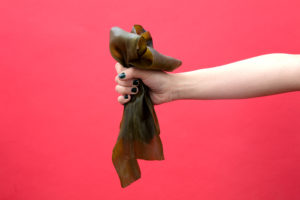

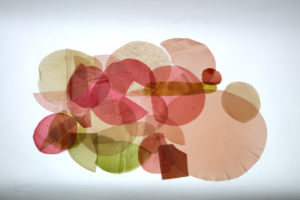
Betreuer
Prof. Ineke Hans, Prof. Holger Neumann, Prof. Jozef Legrand
piPE | Bachelorarbeit 2019
piPE ist eine Waschbecken-Urinal-Einhaeit, die speziell für Damentoiletten im halb-öffentlichen Raum und zur Installation in Einzelkabinen konzipiert wurde.
Diese besticht durch die Möglichkeit des komplett kontaktfreien Gebrauchs. Sowohl Wasserhahn, als auch Spülung sind sensorgesteuert. Zusätzlich ist der WC-Part mit dem dünnen Rand und der leichten Schräge optimal in der berührungslosen „Skifahrerposition“ zu nutzen.
Die Strategie, das Waschbeckenwasser durch das Toilettenrohr ablaufen zu lassen, vermeidet überflüssiges Spülen. Reicht es mal nicht aus, sorgen integrierte Düsen für einen restlosen Abtransport.
piPE ist als Vorschlag auf die Frage „Wie könnte der öffentliche Toilettengang für Frauen angenehmer gestaltet werden?“ und damit als die Neueröffnung einer Debatte zu verstehen.
piPE is a sanitary object especially designed for ladies‘ toilets in semi-public areas. It is designed as a unit for installation in standardized single cabins.
It gives the option to be used in a contactless way. Both the faucet, as well as the flushing are sensor-controlled. In addition, the WC part with the thin edge and the slight inclination can be used optimally in the contactless “skiing posture“.
The strategy of draining sink water through the toilet tube avoids unnecessary flushing.
If more than a tiny amount of urine is left behind after use, integrated nozzles ensure a complete removal.
piPE is a potential answer to the question „how could public toilet visits be made more pleasant for women?“ and thus the reopening of an exciting debate.
Prozess
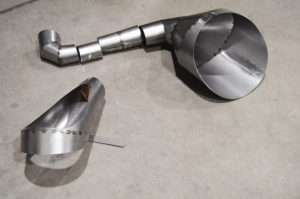
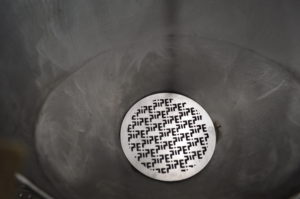
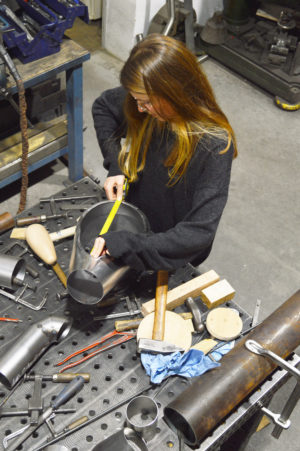
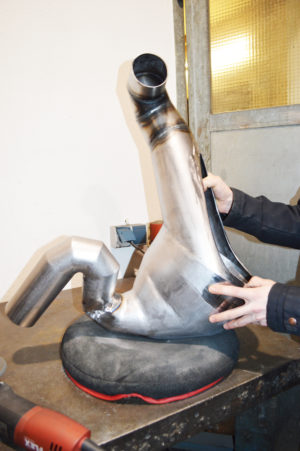

Betreuer
Prof. Burkhard Schmitz, Prof. Jozef Legrand, Prof. Holger Neumann

The way to get along with
Die Räume zwischen privat und öffentlich, z.B. Wohnzimmer, Studio, Büro, sind mit der Zeit immer offener. Die Menschen, die diesen Raum benutzen, sind auch mehrfacher. Die Interaktionen können unser Leben viele Energien und Inspirationen geben, aber gleichzeitig lassen viele Menschen wegen des langzeitigen miteinander-Auskommens sich nervös fühlen. Dann braucht man kurz in einen Raum zurück zu gehen. Auf der anderen Seite werden die Räume, z.B. die Ecke, die Fensterbank und die Treppe, die nicht als einen Pause-Raum angesehen sind, machmal von den Menschen benutzt, wenn sie einen eigenen Raum brauchen, oder eine kleine Pause wollen. Das obengenannte Bedürfnis und die obengenannte Nutzung können auch in Design umsetzen.
Möbeln können die Benutzer beeinflussen, und die Looks der Benutzer, die durch die Möbeln beeinflusst wurde, werden auch die Reaktion der Betrachter beeinflussen. Die Interaktion zwischen Menschen kann nicht nur direkt und vielleicht unangenehmen sein, sondern auch durch indirekte Weise beobachtet und durchgeführt sein. Deshalb sind viele verschiedene Perspektiven, z.B. Richtung, Höhe, Körpersprache… auch beachtet.
From time to time, for rooms between private and public like living-room, studio and office, the distribution of the space is getting more wide-opened. The consisting of people who use these spaces are also getting more various. Interaction between people brings energy and inspiration, however, causes anxiety to those who can’t endure spending too much time with others in the same room. These people sometimes need a space for time out. On the other hand, while the corner, windowsill and stairs were not meant to be a space for such purpose, you can find people resting at these places when they need their own space or a little break. The above-mentioned need and the usage can also be converted into Design.
Furniture affects users and how they looks. Positions and gestures of users affected by the furnitures also suggests others what kind of states of mind they are. Interaction between people can not only direct and maybe awkward, but also be observed and realized through an indirect way. Many different perspectives, for example direction, height and bodylanguage are therefore considered.


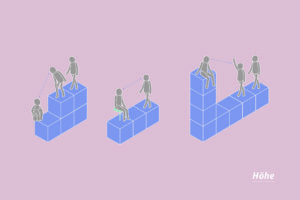

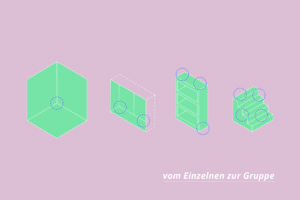
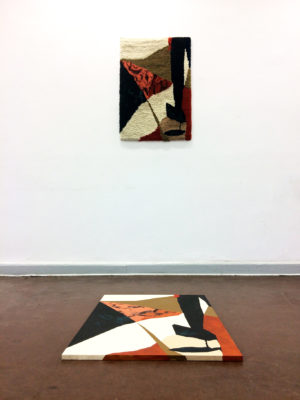

The subjectivity of objects
Das Projekt „The Subjectivity of Objects“ erforscht die Wechselwirkung zwischenHandwerk, Freier Kunst und Design. Sind diese Begriffe, die unsere Objekte definieren,gleichwertig? Existiert zwischen ihnen eine hierarchische Beziehung? Stehen sieeinander gegenüber? Durch die Herstellung von Objekte, die an der Grenze zwischen Handwerk und Kunst liegen, kann sich ein ganzheitlicher Dialog über Objekte, ihre Natur und warum wir sie herstellen, entwickeln. Können Kunsthandwerkliche Objekte zur bildenden Kunst werden, wenn sie auf eine bestimmte Weiseausgestellt werden oder eine abstrakte Landschaft darstellen? Kann Kunst als Handwerk rekontextualisiert werden, wenn der Fokus des Betrachters nicht auf dem Bild, sondern auf dem Zweck des Objekts liegt?
The work in progress, The Subjectivity of Objects, is oriented around an examination of craft, fine art and design. Are these terms, which categorize the objects we create, parts of a spectrum? Do they oppose one another, or do they exist in a hierarchical relationship? Through making pieces that toe the line between craft and fine art, a holistic dialogue about objects, their nature and why we make them can evolve. Can craft objects become fine art if they are displayed in a certain manner or depict an abstract scape? Can art be re-contextualized as craft if the viewer’s focus is on the object’s purpose, rather than its image?




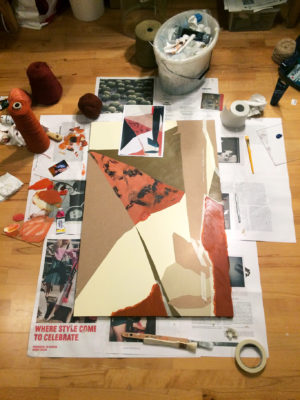
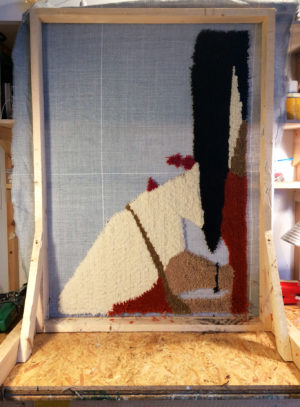

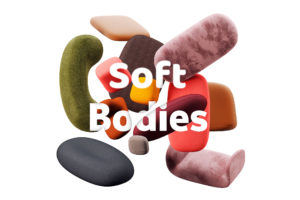
Soft Bodies
Kampagne Möbel wurden ursprünglich für britische Kolonisten in Indien entworfen. Die Idee war, im Ausland ein höheres Maß an Komfort zu bieten.
Wenn nomadische Lebensstile in den zunehmend überfüllten Lebensräumen der Zukunft zur Norm werden, wie werden wir den gewohnten Komfort beibehalten, an den wir uns jetzt gewöhnt haben?
Wie können wir Möbel schaffen, die für eine transiente Gesellschaft mehr Mobilität stehen? Können wir Platz sparen, indem wir unsere Einrichtungsgegenstände als Lagerraum verwenden? Könnten wir einen weniger toxischen Lebensraum kreieren, indem wir natürliche Polstermaterialien anstelle von künstlichen Schaumstoffen verwenden? Können Möbel als Begleiter in einer Gesellschaft fungieren, in der die physische Gemeinschaft ihre Rolle verliert?
Campaign furniture was originally designed for use by British colonists in India. The idea was to afford a higher level of comfort to the soldiers, officials and their families who were stationed far from home.
As nomadic lifestyles become the norm in the increasingly overcrowded living spaces of the future, how will we maintain the level of comfort we have now become so used to?
How can we create furniture which provides a greater level of mobility for a transient society? Can we save space by using our soft furnishings as storage? Could we create a less toxic habitat by using natural upholstery materials instead of man-made foams? Can furniture act as a companion in a society where physical community is losing its prevalence?
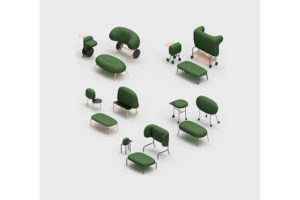
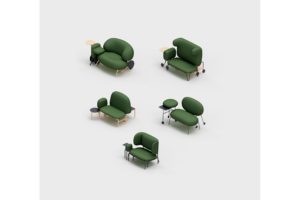
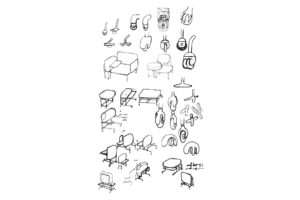
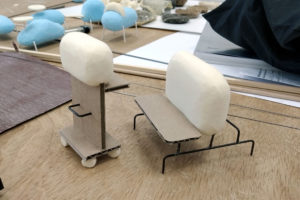
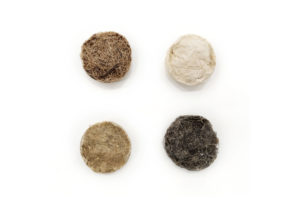
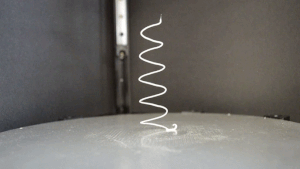
URODID – MID AIR EXTRUSION
Die Larve des Urodidae verpuppt sich anders als herkömmliche Schmetterlinge, in einem offenmaschigen gitterartigem Kokon. Inspiriert von der Konstruktion des Kokons, welcher frei in der Luft gesponnen wird, habe ich ein Verfahren entwickelt, mit dem sich derartige Strukturen und Geometrien mittels FDM-Druck realisieren lassen.
Die besondere Druckpfadgenerierung, in Kombination mit exakt aufeinander abgestimmten Druckparametern, ermöglichen die gezielte freie Extrusion im Bauraum, wodurch der FDM-Drucker auf eine neue und innovative Weise eingesetzt werden kann.
The larva of Urodidae pupates differently than conventional butterflies, in an open-meshed latticed cocoon. Inspired by the construction of the cocoon, which is freely spun in the air, I have developed a method that can be used to realize such structures and geometries using an additive manufacturing process: Fused Deposition Modeling (FDM).
The special print path generation, in combination with precisely defined print parameters, enables the free, but calculated extrusion, whereby the FDM printer can be used in a new and innovative way.

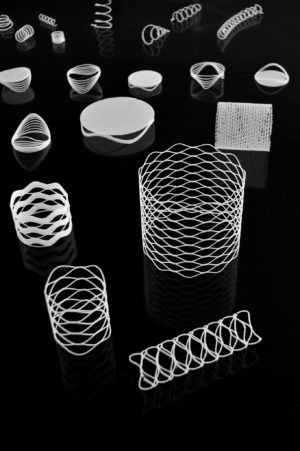
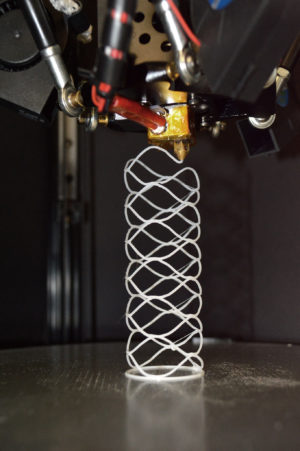
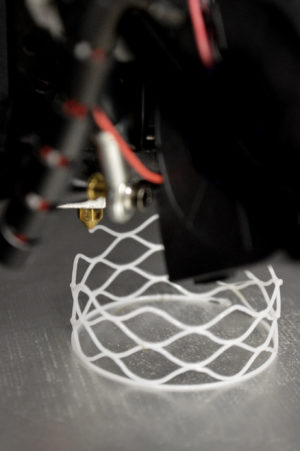
Narrative Objekte und Requisiten, herausgerissen aus der inszenierten Welt
Was passiert, wenn fantastische Objekte aus der inszenierten Welt herausgerissen werden und plötzlich einen realen Nutzen erhalten? Wie reagiert der Otto Normalverbraucher auf sie? In welcher Situation kommt er überhaupt mit ihnen in Berührung?
Ich möchte eine Welt mit eigenen Regeln und Gesetzen gestalten, die eine aktive Auseinandersetzung mit dem Fantastischem ermöglichen. Eingebettet in den Mantel von klassischen Märchen stelle ich einem Kollektiv die Herausforderung, sich rätselhafte Objekte anzunähern und sie vielleicht zu verstehen.
What happens when fantastic objects are taken out of the staged world and suddenly come with real benefits? How does the average consumer react to them? In which situation does he even come get in touch with them?
I want to create a world with its own rules and laws that enable an active engagement with the fantastic. Embedded in the mantle of classic fairy tales, I challenge a collective to approach and perhaps understand enigmatic objects.
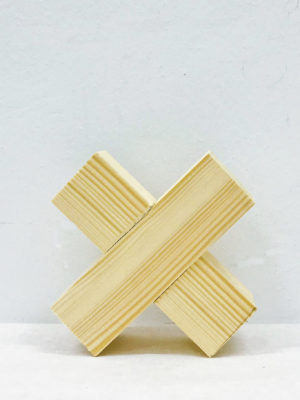
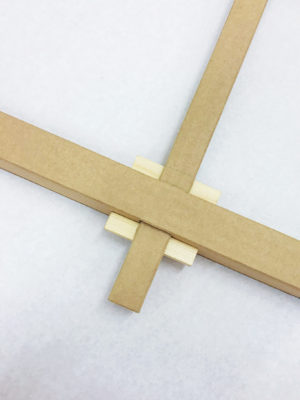
Pappeverbindung
Bei der Zapfenverbindung werden Holzverbindungen am häufigsten verwendet und wurden in der Vergangenheit häufig in Möbeln und im Bauwesen verwendet. Mit der Entwicklung der Industrie wurde sie jedoch allmählich vergessen. Wie können die Leute sie auf spielerische Weise wiederkennen? Meine Zielgruppe sind junge Menschen, die oft umziehen. Zerlegbare Möbel sind die beste Wahl für sie. Die Zielgruppe, die ich entworfen habe, ist die junge Leute, der oft zieht um.Und die Möbel, die zerlegt werden können, sind die beste Wahl für sie.Während meiner Untersuchung stellte ich fest, dass die Wellpappe eine wichtige Rolle beim Umzug und beim Möbel spielte. Auf der einen Seite verwenden die Menschen Wellpappe zum Verpacken von Gegenständen, und auf der anderen Seite werden die Wellpappe benötigt, um das Aussehen von Möbeln zu schützen.Obwohl Wellpappe ein umweltfreundliches Material ist, ist der Preis sehr günstig. Es kann jedoch nur einmal verwendet werden. Übermäßiger Abfall kann auch die Umwelt schädigen. Bei meiner Entwerfung wird Wellpappe als Rohstoff verwendet, um die Holzverbindung neu zu interpretieren. Verpackungen aus Wellpappe werden zu einem Teil von Möbeln.
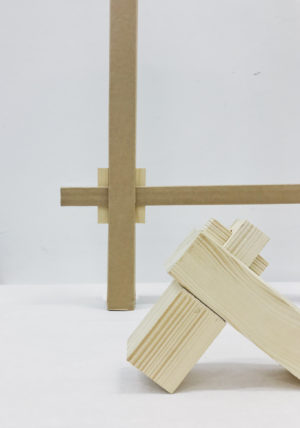
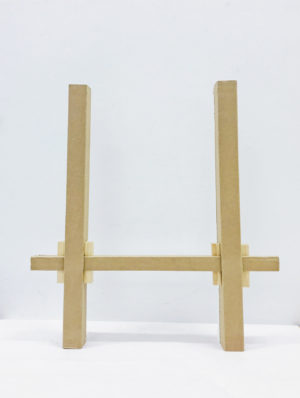
Timber joints are the most commonly used in mortise and tenon and have been widely used in furniture and construction in the past. However, with the development of the industry, they are gradually being forgotten. How could I make them more attractive to the public in a fun way? My target market is young people who often need to move and relocate. Therefore, furnitures that can be disassembled are the best choice for them. During my research, I found that the corrugated board plays an important role in the moving process. On the one hand, people use corrugated cardboard to pack items. And on the other hand, corrugated cardboard is needed to protect the furniture from being damaged. Although corrugated board is an environmentally friendly material, the price is very cheap. However, it can only be used once. Excessive waste can also damage the environment. In my design, corrugated board is used as raw material to reinterpret the wood connection.

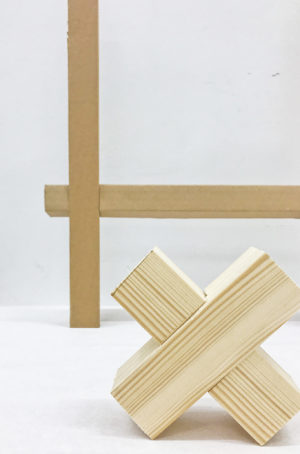

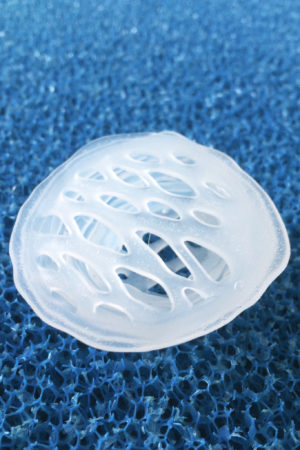
Circular Matter
Die Arbeit „Circular Matter“ richtet ihr Interesse auf den Einsatz von Bakterien, Myzelien sowie Enzymen zur besseren Nutzung von nachwachsenden Rohstoffen, vor allem im Hinblick auf Lignin, einem Holzbestandteil und dessen Produkte. Ziel ist die praktische Nutzung eines dieser Materialien oder die Entwicklung eines Designkonzepts, auf welches es anwendbar wäre. Der Fokus liegt auf der Ausformulierung einer materialgerechten und starken Formsprache, aus welcher ein industriell produzierbarer Entwurf entstehen soll.
The project „Circular Matter“ focuses on the use of bacteria, mycelia and enzymes and how they could be better employed as renewable raw materials. With a special interest in lignin, a component of wood, and lignin products, the project’s aim is the practical application of one of these materials and the development of a design concept in which lignin could be utilized. The project concentrates on the development of a strong language of form appropriate to the chosen material, from which an industrially produced design should emerge.
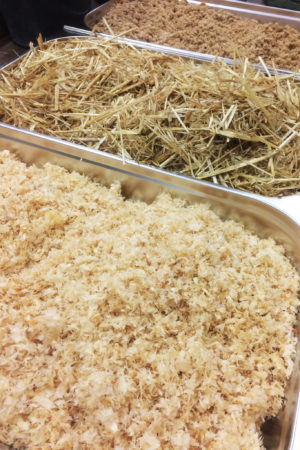

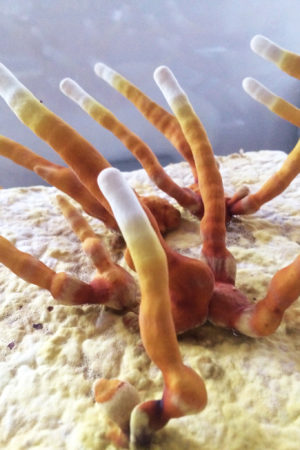


extension
Schon der frühe Mensch nutze einfache Werkzeuge als Erweiterung des Körpers.
Heute sind wir umgeben von analogen und digitalen Artefakten, die uns als hochentwickelte Helfer dienlich sind. Der exponentiell wachsende technologische Fortschritt wirft viele neue Fragen auf. Wie werden wir mit unseren Mitmenschen als Individuum oder als Gesellschaft, unserer Umwelt aber auch mit ihren Ressourcen zusammen interagieren und leben. Digitalisierung vernetzt uns Menschen miteinander und löst Barrieren auf. Schafft neue Interaktionen und Anwendungsskripte für alltägliche Routinen. Hat das Individuum noch Relevanz? Hat Tradition und Kulturgut und damit eine bewusste Ausdifferenzierung einer Gruppierung noch eine Existenzberechtigung? Wie sieht eine Zukunft aus, wenn Mensch und Maschine auf mentaler Ebene verschmelzen? Bildet sich ein neues Wesen, eine neue Kultur oder gar eine neue Religion? Rückt in Zukunft der menschliche Körper näher in den technologischen Fokus? Werden wir unseren Körper erweitern oder bewusst ersetzen? Aktuell steht der Mensch im Mittelpunkt der gestalterischen Fragen, doch steht vielleicht zukünftig der Cyborg im Fokus? Und wie lässt man etwas Unsichtbares visualisieren?
Even the early human used simple tools as an extension of the body.
Today we are surrounded by analogue and digital artefacts that serve us as sophisticated helpers. The exponential growth of technological progress raises many new questions. How will we interact and live together with our fellow human beings as individuals or as society, our environment but also with our resources? Digitalization networks us humans with each other and dissolves barriers. Creates new interactions and application scripts for everyday routines. Does the individual still have relevance? Does tradition and cultural heritage and a a conscious differentiation of a group still have a right to exist? What does a future look like when humans and machines merge on a mental level? Is a new creature, a new culture or even a new religion emerging? Will the human body move closer to technological focus in the future? Will we expand or consciously replace our bodies? Currently, the human being is at the centre of the artistic questions, but will the cyborg perhaps be the focus in the future? And how can something invisible be visualized?
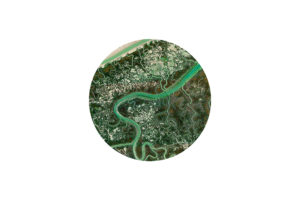
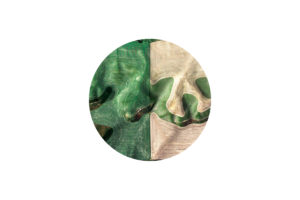
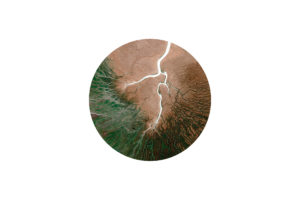
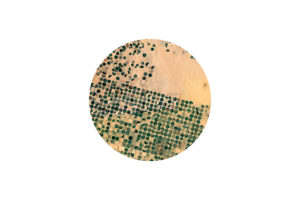
Vom Zuhause zum Design | Masterarbeit 2018
Was ist ein Zuhause? Wie kann man dieses Wort und das Gefühl, dass es mit sich bringt, auf ein Objekt übersetzen und dieses Objekt nutzen, um sich zu Hause zu fühlen?
Das Ziel dieser Masterarbeit war es, verschiedene Objekte zu gestalten, die vom Nutzer auf einfache Art selbst gebaut, umgewandelt und mit verschiedenen ästhetischen Elementen individualisiert werden können. Eine Serie von Do-It-Yourself Möbelstücken, die einfach und schnell zu bauen sind. Für hands-on Personen, die einen Wunsch nach einem gemütlichen Zuhause mit günstigen, personalisierten Möbeln haben. Die Möbelstücke wurden entwickelt, um viele Wohnbedürfnisse zu stillen, wie Arbeiten, Schlafen, Ausruhen und Gäste empfangen. Für alle die Personen, die begrenzten Wohnraum haben.
Die Ergebnisse des Studiums wurden in einem DIY-Buch zugänglich gemacht. Sie enthält eine Zusammenstellung aller Möbel, Bewertungen dieser und stark visuell gestützte Bauanleitungen.
What is home? Can this feeling be translated into an object? If so, how can this object be used to make you feel at home?
The intention of this Master Project was to design objects that could be built and customized by the users. A series of Do-It-Yourself furniture pieces that are easy and fast to build, for people that are hands-on, low budget, but have a true desire for a cozy home with personalized furniture.
All the pieces were designed based on daily needs for those who live in one room only, but still want to use it for various purposes: work, sleep, rest, receive guests and relax.
The results of this study were translated into a DIY Book, which enables the user to build the furnitures themselves. The instructions are strongly visualized and furthermore the book gives the reader useful hints on building, material and modifying.
Prozess
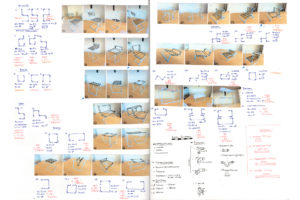
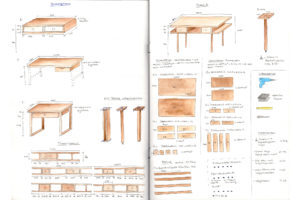
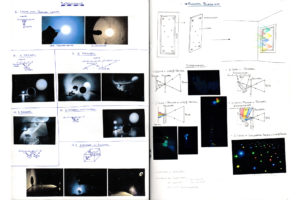

Betreuer
Prof. Burkhard Schmitz, Prof. Holger Neumann
Kontakt
Soapbottle | Masterarbeit 2018
Warum ist ein Produkt, das ca. einen Monat benutzt wird, aus einem Material, das im Schnitt 500 Jahre braucht, bis es zerfallen ist? Soapbottle ist eine Verpackung für flüssige Waschsubstanzen aus dem Material Seife. Dabei wird das Konzept von verpackungsfreier Kosmetik aufgenommen, indem das Produkt selbst zur Verpackung wird. Seife besteht aus natürlichen Rohstoffen und ist biologisch abbaubar: Müll kann also komplett vermieden werden. Während der Inhalt der Soapbottle aufgebraucht wird, löst sich die Seifenverpackung langsam auf. Überreste der Soapbottle können als Hand-Seife weiterverwendet oder zu Wasch- oder Putzmittel verarbeitet werden.
Natürlich hat eine „Seifenverpackung“ nicht die selben Eigenschaften, die man von Kunststoffverpackungen gewohnt ist. Sie ist nicht unzerbrechlich, sie ist wasserlöslich, beim Gebrauch wird die Oberfläche rutschig. Diese vermeintlichen Nachteile werden als Gestaltungselemente genutzt: Das Konzept spielt mit dem Vorgang des Auflösens, mit der Transformation des Gegenstands und der aus diesen Aspekten entstehenden Individualität.
Es zeigt sich die Ästhetik der Vergänglichkeit.
Prozess
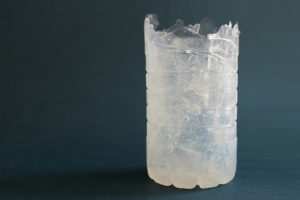
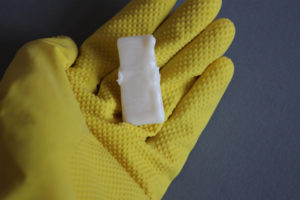
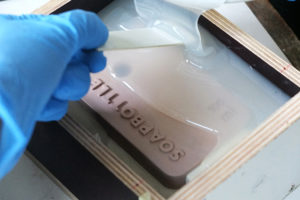
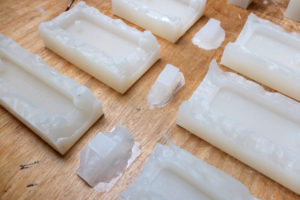
Betreuer
Prof. Burkhard Schmitz, KM Hannah Wiesener
Kontakt
COLLIDER DESK | Bachelorarbeit 2018
„ColliderDesk“ ist ein Tisch, der auf dem ersten Blick die gewohnten Nutzungen im Alltag ermöglicht. Doch was nicht sofort offensichtlich ist: Dieser Tisch wurde mit einer digitalen Intervention „gehackt“ und verbirgt ein Spiel im Inneren. Er integriert das zuvor beschriebe- ne Spielkonzept aus Sensoren, Vernetzung und Klangerzeugung. Sobald der Benutzer mit seinen Kopfhörern eine Verbindung zum „ColliderDesk“ aufnimmt, eröffnet sich eine parallele Klangwelt, in der mit anderen Spielern musiziert wird. Es wird eine unsichtbare Verbindung untereinander aufgebaut und somit eine zusätzliche Form der Kommunikation ermöglicht.
Auch das Interface zum Erzeugen der Klänge verbirgt sich in einem alltäglichen Gegenstand. Zylindrische Objekte, die auch als Schale oder Untersetzer fungieren könnten, wurden um Sender und Sensoren ergänzt.
Die Bewegung der Objekte erzeugt Töne die abhängig von der Lage auf der Tischplatte sind. Darüber sind innerhalb des Tisches und der zylindrischen Objekte verschiedene Soundtypen verborgen, die nach und nach erforscht werden können. Die Benutzer können durch Bewegung der Objekten verschiedene Klänge erzeugen. Dies ermöglicht es uns, für den Moment mit anderen Menschen in Kontakt zu treten und leicht zu spielen, ohne erst Lernen zu müssen.
Aus dem Moment heraus gründen wir eine Band und bekommen die Chance, uns auch mit Menschen auszutauschen, die wir zuvor gar nicht kannten. Der ColliderDesk bietet uns eine einzigartige Gelegenheit spielerische Abwechslung in unseren Alltag zu bringen. Anstatt das Spiel erst planen und organisieren zu müssen, setzen wir uns der Improvisation aus.
Betreuer
Prof. Axel Kufus, Prof. Holger Neumann, KM Johanna Schmeer
The collection deals with the relation between the three-dimensional body and the two-dimensional canvas, as well as free body movement and the fixed pose.
The design process was initiated by a motion study showing the female body in various postures. Each of the outfit’s shape is based on one of those postures.
Fashion & Concept: Lene Jürgensen, Kamera & Schnitt: Maximilian Carus, Tänzerin: Daria Nowak, H&M: Hannah Ridder

FRAGILE HANDLE WITH CARE tells a story of rich, hysterical women from the 19th century. The collection combines clothing for people with and without disabilities, Victorian fashion and a snappy petting zoo.
Betreut von: Prof. Wowo (Waldemar) Kraus
Fotos: Viktoria Nowicki, Model: Louise Fankhänel, Make-Up: Callum Norris, Hair: Kübra Topcu
TOWARDS A NEW MATTER | Bachelorarbeit 2018
Towards a New Matter is a material-based research project, in which denim fibers have been transformed through a recycling technique into a lightweight and sound absorbing panel material. The textile industry’s production chains have been evolving into key waste and pollution generators over the last forty years. By 2018, from the 80 billion garments produced globally every year, 75% are discarded after being worn for a short time. The current gab between textile waste and design innovation poses an interesting challenge:
Could it be possible to turn textile waste into a new and sustainable material that can be integrated into our daily life? Through rudimentary material manipulation techniques and the development of manufacturing processes, the textile fibre could be transformed into a new panel material.
This biodegradable mono-material has been created without the need of adding a binding chemical, as it is entirely composed of natural resources and locally generated waste and scraps. This manufacturing process has allowed recycled textile fibers to be converted into modular expandable elements that can be arranged within architectural spaces, into space-separating structures, thus generating spatial subdivisions or rooms within rooms, according to the user’s need.
The resulted elements have a high strengths and a stone-like aesthetics without loosing the warm and soft tactility of textiles. What began as a research of discarded textiles, became a production technique that can be contribute to apply the principles of reduction, reusing and recycling of textile.
Prozess
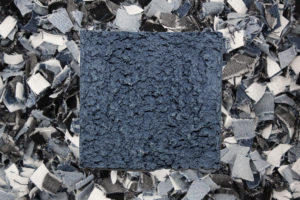
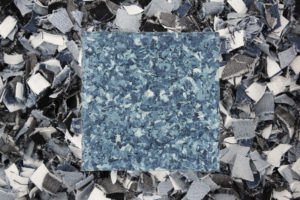
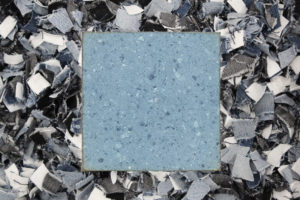
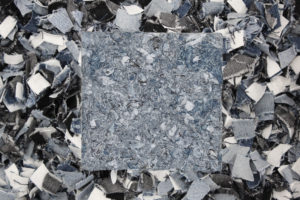
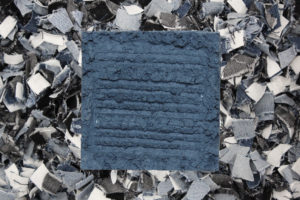
Kontakt
www.milanfriedrich.com
Betreuer
Prof. Ineke Hans, Prof. Jozef Legrand, Zane Berzina
Credits
Foto: Arthur Pohlit Video: Max Firchau
I AM BECAUSE YOU WERE | Masterarbeit 2018
Motho ke motho ka batho. Ein Mensch ist ein Mensch durch andere Menschen.
Gebührt unsere individuelle Identität der Identitäten jener, zu der wir in Beziehung stehen? Sind unsere Leben lediglich eine Fortsetzung der Geschichten derer, die uns vorangegangen sind? Ist es unser Shicksal ihre Lasten zu tragen und für ihre Fehler aufzukommen? Oder können wir die Geschichte von Verletzungen endlich überwinden und uns von der Vergangenheit befreien, ohne dabei unsere Ahn*innen per se zu zurückzuweisen?
„I am because you were“ („Ich bin weil ihr wart“) erforscht die komplexe kulturelle Hybridität eines Menschen am Beispiel der deutsch-südafrikanischen Tänzerin Duduzile Voigts. Das Projekt ist ein Beispiel von Geschichts-Schreibung: Zeitweise konnten wir aus einer Fülle an materiellem Archiv und persönlichen Interviews speisen. In anderen Momenten fiel die historische Information, auf die wir unsere Charaktere bauten, sehr gering aus. In beiden Fällen bauten wir uns ein fragmentiertes Bild der Vergangenheit durch subjektive Interpretation und Spekulation. Die Geschichte, auf der wir unsere persönliche Identitäten so stark beruhen, ist somit wohl eher ein Fall von formbarer Fiktion als zuverlässiger Fakt.
Motho ke motho ka batho.
A human is a human through other humans.
Do we hone our individual identities to those akin to us? Are our lives a mere continuation of the stories of those who preceded us? Are we destined to bear their burdens and atone for their wrongs? Or can we finally overcome a history of hurting and break free from the past without having to discard our ancestors and ancestresses as a whole?
“I am because you were” explores the complex cultural hybridity of human beings by focussing on the case of the German-South African dancer Duduzile Voigts and her family lineage. It is an exemplification of history-making: At times, we were able to source from an abundance of material archives and personal interviews; at others, the historical information on the characters we crafted was extremely scarce. In either case, our image of the past is pieced together through subjective interpretation and speculation. The history we so draw our personal identities from is rather a matter of malleable fiction than that of reliable fact.
Betreuer
Prof. Carolin Lerch, KM Lars Paschke
Credits
Fashion Design, Direction, Editing: Pierre-Yves Dalka
Dancer: Duduzile Voigts
Director of Photography: Stephan Wagner
Music: Evelyn Sailor
MORPHABLES | Bachelorarbeit 2018
„Morphables“ ist ein Forschungsprojekt im Bereich von programmierbaren Textilien. Mit Hilfe von 3D Druck wird Kunststoff auf gespannte Textilien aufgebracht. Durch die Vorspannung wird Energie in das Textil eingebettet. Dabei steuert das 3D-Druckmuster die Umformung.
Wenn das Textil freigegeben wird, findet die 3D-Transformation statt. In diesem Projekt ging es darum, die Möglichkeiten und Grenzen des Druckens auf Textilien zu erforschen und Einsatzmöglichkeiten zu erkunden.
“Morphables” is a research project in the field of programmable textiles. By means of 3D printing, polymer is applied to stretched fabric. The act of pre-stressing the textile embeds energy into it. The 3D printed pattern acts as a constraint. When the textile is released the 3D transformation takes place.
The aim of this project was to explore the possibilities and limitations of printing onto textiles and to explore possible uses.
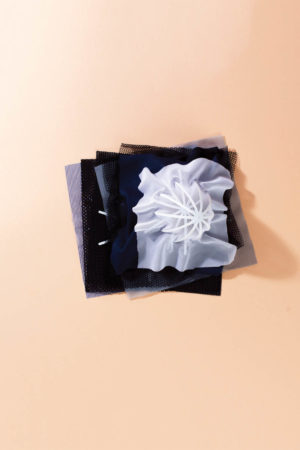
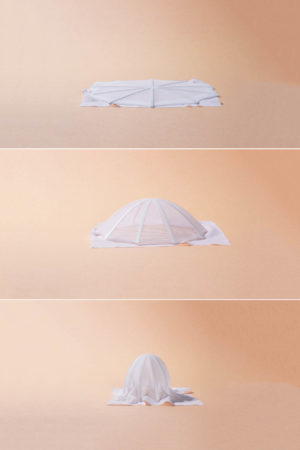
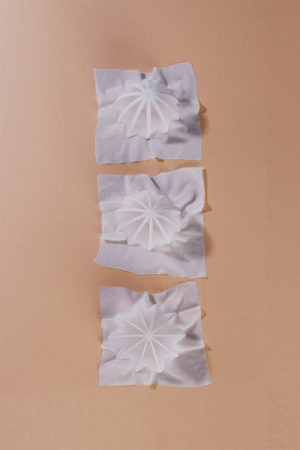
Betreuer
Prof. Burkhard Schmitz, Prof. Holger Neumann, KM Antonia Kühne
Kontakt
Das Flüsterfon | Masterarbeit 2018
Was wäre, wenn wir auf weite Distanz flüstern könnten? Stille Post auf 100 Meter Entfernung?
Ich habe einen funktionierendes Gerät entwickelt, mit dem genau das möglich wird: das Flüsterfon. Stellen Sie sich vor, Sie sind zum Beispiel ein Fußballtrainer einer Fußballmannschaft. Sie wollen einem Spieler einen taktischen Spielzug zurufen, wollen aber nicht, dass die gegnerische Mannschaft etwas hört. Außerdem befindet der Spieler über 60m entfernt. Da ist verständliches Rufen in einer so lauten Umgebung wie einem Fußballstadion sowieso schwierig. Dies wäre ein ideales Einsatzmoment für das Flüsterfon. Hilfreich wäre es auch für Bademeister am Strand oder am Pool. Laute Durchsagen durch Megafone bringen Badegäste ständig aus der Ruhe. Mit dem Flüsterfon könnte man nur die Kinder, die vom Beckenrand springen, ansprechen. Letztendlich wäre das Flüsterfon so gut wie überall hilfreich, wo eine laute Umgebung herrscht, die den Informationsaustausch auf Distanz erschwert. Das Flüsterfon beruht auf der Technologie eines Parametrischen Lautsprechers. Wenn man Licht mit Klang vergleichen würde, wäre ein herkömmlicher Lautsprecher eine Glühbirne und der Parametrische Lautsprecher ein Laserstrahl. Er produziert einen gerichteten Klangstrahl, der je nach Stärke des Lautsprechers über mindestens 100m weit strahlt. Sobald der Klangstrahl auf nichts auftritt, hört man auch nichts. Nur wenn er auf ein Ohr oder eine Fläche trifft, entsteht hörbarer Klang. Er sendet gleichzeitig zwei Ultraschallfrequenzen, deren Differenz die für uns hörbare Frequenz ergibt. Mann kann versuchen, den Effekt zu beschreiben jedoch muss man es einmal selbst erlebt haben. Es klingt so, als würde einem jemand direkt ins Ohr flüstern, als würde der Klang direkt im eigenen Kopf entstehen. Steht man direkt vor dem Parametrischer Lautsprecher oder im Klangstrahl 100m weit entfernt, hört man das Flüstern in genau der selben Lautstärke– leise aber mit sehr hoher Verständlichkeit. Das Flüsterfon, so wie es jetzt gestaltet ist, ist ein Prototyp, der an die für mich erhältlichen technischen Bestandteile angepasst ist. Sobald diese sich ändern, kleiner und leichter werden, würde ich die Gestaltung dementsprechend anpassen.
What if it were possible to whisper from afar? Like Chinese whispers from 100 meters away?
I have developed a device which allows just that: the Flüsterfon. Imagine, for example, that you’re the coach of a football team. You want to give tactical instructions to a player, but without the opposition overhearing. In addition, the player is more than 60m away. To call out to someone in a packed and noisy football stadium is hard enough anyway. This would be an ideal situation for the Flüsterfon. It could also be helpful for lifeguards on the beach or at the pool. Loud announcements through a megaphone constantly disturb the bathers. But with the Flüsterfon it’s possible to address only the children jumping from the edge of the pool. Ultimately, the Flüsterfon would be helpful in any environment that is noisy enough to hinder the conveyance of information at a distance. The Flüsterfon uses parametric loudspeaker technology.
If one were to compare light to sound, a conventional loudspeaker would be similar to a light bulb while a parametric loudspeaker would be more like a laser beam. It produces a directional sound beam which, depending on the strength of the loudspeaker, can carry for at least 100 meters. As long as the sound beam is not interrupted, you hear nothing. Only when it hits a surface (for example someone’s ear) does audible sound emerge. It simultaneously sends two ultrasonic frequencies whose difference gives us the audible frequency. One could try to describe the effect but you have to experience it yourself. It sounds as though someone is whispering in your ear, as though the sound were being made right inside your head. If you stand directly in front of the parametric loudspeaker or in the path of the sound beam 100m away, you hear the whisper at exactly the same volume – quietly yet extremely clearly. The Flüsterfon, as it is now designed, is a prototype adapted to the technical components available to me. As soon as these change, become smaller and lighter, I would adapt the design accordingly.
Prozess
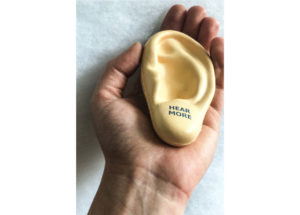

Betreuer
Prof. Burkhard Schmitz, KM Antonia Kühne
WURM WERKSTATT | Bachelorarbeit 2018
WURM WERKSTATT ist ein Konstruktionsspielzeug für Kinder, dass viele Möglichkeiten bietet und spielerisch Proportionen und Geometrien entdecken und nutzen lässt. Entscheidend ist hierbei, dass Kinder ihre Kreativität ausleben und sich im Spiel ausdrücken können. Der Montageprozess erfordert nicht nur feinmotorische Fähigkeiten, sondern ihren Körpereinsatz, um das zu schaffen, was in ihrer Vorstellung ist.
Auch die Entwicklung sozialer Fähigkeiten wird gefördert – Kinder erleben, wie zusammen Spielen Spaß macht und werden zu Kooperation und Spielfreude angeregt. Sie können aus weichen, leichten Grundbauplatten und flexiblen Verbindern ihre Objekte bauen, indem sie die einzelnen Komponenten verbinden, stapeln und stecken. Dank des lebensgroßen Formats der Wurm Werkstatt Elemente können Kinder die Beziehung zwischen Objekt und Raum erfahren.
WURM WERKSTATT is a construction toy for children that offers many possibilities. Proportions and geometries can be discovered and used in a playful way. It is crucial that children put their creativity into practice and express themselves whilst playing. The assembly process requires not only fine motor skills, but also for them to use their whole body to create what is in their imagination.
The development of social skills is also promoted – children experience how fun it is playing together and are encouraged to cooperate and enjoy themselves. Using the soft, lightweight base plates and flexible connectors they can build objects by connecting, stacking and pinning the individual components. Thanks to the life-size format of the Wurm Werkstatt elements, children can experience the relationship between object and space.
Kontakt
Instagram: katha.bellinger
Website: http://www.katharinabellinger.com
Betreuer
Prof. Burkhard Schmitz, Prof. Holger Neumann, Prof. Alexander Müller-Rakow, Prof. Ineke Hans
Fotograf
Ole Sauer
INTUERI is about being aware of the senses that already exist upon us. From a very fundamental and deep level, making us reconnect with our primitive instincts. Our most ancient desires and senses remembered by the use of technology making us aware of our new environments.
It is a proposal to discuss the unseen that quietly in uences us in ways we don’t even know but we only feel. An invitation to think about technology changes that are happening now. Relating it to the body, senses on the skin. Transforming an abstract yet concrete way of feeling the invisible world of the electronics around us, and re ect on the ever present computing.
The copper embroidery is embedded with a technology that captures the invisible. Allowing us to transform magnetic elds into sound/vibrations so that we can be aware of the energy that surrounds us.
By feeling the electromagnetic elds and to discover that “the pseudo existent silence” is not real, can be quite shocking. This is possibly the biggest function of INTUERI, to reveal the unraveled. Waking us up to new dimensions of the new world.
Betreut von: Prof. Carolin Lerch // Prof. Jozef Legrand // Prof. Dr. Ingeborg Harms
Foto: Eeva Suutari
Model: Zara Alexa Schweimler
Make-up: Mami Oonishi
Der Tourismus ist ein bedeutender Faktor in der Weltwirtschaft. Er ist wichtig für die Stärkung des Welthandels sowie für Investitionen in den Tourismusländern. Die positive wirtschaftliche Seite ist nur eine der Resultaten des Tourismus. Im selben Atemzug wie die unbestreitbaren positiven wirtschaftlichen Auswirkungen des Tourismus werden seine Vielzahl von negativen Auswirkungen auf die Umwelt genannt. Sowie die negativen Folgen auf die Umwelt seien die negativen Auswirkungen auf
die Gesellschaft des Besucherlandes aufgeführt. Der Tourist hat das alleinige Sagen, er bestimmt durch sein Geld was geschieht. Meist aus Gesellschaften mit anderen Werten und Lebensstilen, unbewusst bewusst beein ussen Touristen das Lebensverhalten des Einheimischen und hinterlassen psychische sowie physische Spuren hinter Ihnen zurück. Mit der Absicht der Darstellung unserer heutigen Schnell-Wandel-Gesellschaft, die Veränderung einer minderheitlichen asiatischen Volksgruppe mit dem fremden westlichen Ein uss, in Form eines neuen Hybrid. „Der Kampf der Kulturen“ – ein Kampf um Überleben der eigenen Traditionen.
Betreut von: Prof. Carolin Lerch // KM Evelyn Sitter // Prof. Dr. Kathrin Busch
Foto: Lara Wilde
Model: Carlotta E. Davis / Viva Models Berlin
Make-up: Anett Alexandra Bulano
Memorabilia is based on the interaction of cultural preservation, the elimination of traditions and the distortion of memories. Based on my own multicultural background and my one-year experience in Portugal, my nal collection deals with the outgrowing of a parental home, the self-concept of identity and the conservation of traditional roots. I combined historic Portuguese costumes with classical menswear elements to underline the interaction of old and new silhouettes. The patterns as well as the materials are based on living room esthetics from the 80s and associate to the melancholic characteristics of the collection. Memorablia is a collection for young cultural nomads, who thrive for a new independent existence without ignoring their personal background, inviting to dream about the past and the future ahead.
Wie wirkt sich diese vermeintliche Optimierung auf Bekleidung aus?
Meine Arbeit soll ein Vorschlag sein, die Form von Bekleidung als noch nicht ausgeschöpftes Medium zu betrachten und offen zu sein für multiple Funktionen innerhalb eines vertrauten Systems.
Betreut von: Prof. Wowo (Waldemar) Kraus , Prof. Dr. Ingeborg Harms , Gast Prof. Franziska Schreiber
Foto:Kathrin Leisch
Model: Ivan Tomasevic / Pearl Management
Hair & Make-up: Vi Nghiem Tuong
Wanda Wollinsky | 2017 | Bachelorarbeit Modedesign
Now Showing : Love
For this collection I researched dress behavior in Germany and ended up at otto.de, the biggest retail in clothing here.
In the comment section of the online shop I came across mainly women who bought clothes for their boyfriends, saying how he was very happy when she got him the new shirt. I loved to find romance in the mundane world of otto.de.
Combing technical tools of online shopping with details that show love to the wearer normal clothes like shorts and plaid shirts are twisted in a fun and romantic way.
Betreut von: Prof. Wowo (Waldemar) Kraus // Prof. Dr. Ingeborg Harms // KM Lars Paschke
Foto: N. Wollinsky
Hair&Make-up: Nghiem Tuong Vi
Model: Nicolaj // Cedric // Daniel
Editha, Wolfgang und Hubert | Masterarbeit 2018
EDITHA ist ein olfaktorisches Medaillon. Das Speichermedium des Duftes ist ein poröses Keramikplättchen. Dem Duft wird eine geruchliche Erinnerung zu- geschrieben, womit bei seinem Einatmen für einen flüchtigen Moment eine Immersion in die eigene Innenwelt stattfindet.
WOLFGANG ist eine gestrickte Decke aus Mohair und Viskose, die die digitale Welt der Kartografie analog übersetzt. Das Muster erschließt sich aus Koordinaten und Maßstab. Die Decke sammelt die Düfte ihrer Umwelt und ist ein flexibler Begleiter.
HUBERT ist ein Diffusor, der durch Wärme und Luft Duftmoleküle im Raum zerstäubt. Dabei dient ein 3D gedruckter Keramikeinsatz als Duftmedium. Jede der drei Oberflächenstrukturen der Keramik steht für eine Duftnote: Kopf, Herz, Basis. Hubert verwandelt einen fremden Raum in ein Zuhause und ein Zuhause in eine Reise in die Ferne.
DeScent möchte eine kontemporäre sowie progressive Vision von Wohlempfinden und Zugehörigkeit vorschlagen und zeigen wie innere und äußere Hei- mat unweigerlich miteinander verbunden sind. DeScent ist die Geschichte einer sinnlichen Suche nach Heimat in der Heimatlosigkeit.
Prozess
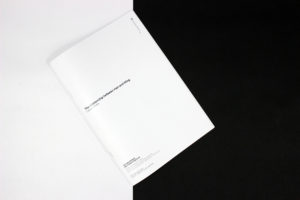


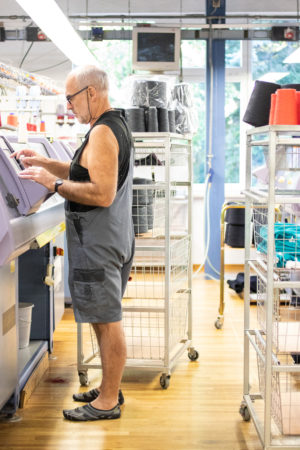
Betreuer
Prof. Burkhard Schmitz, Prof. Dr. Ingeborg Harms
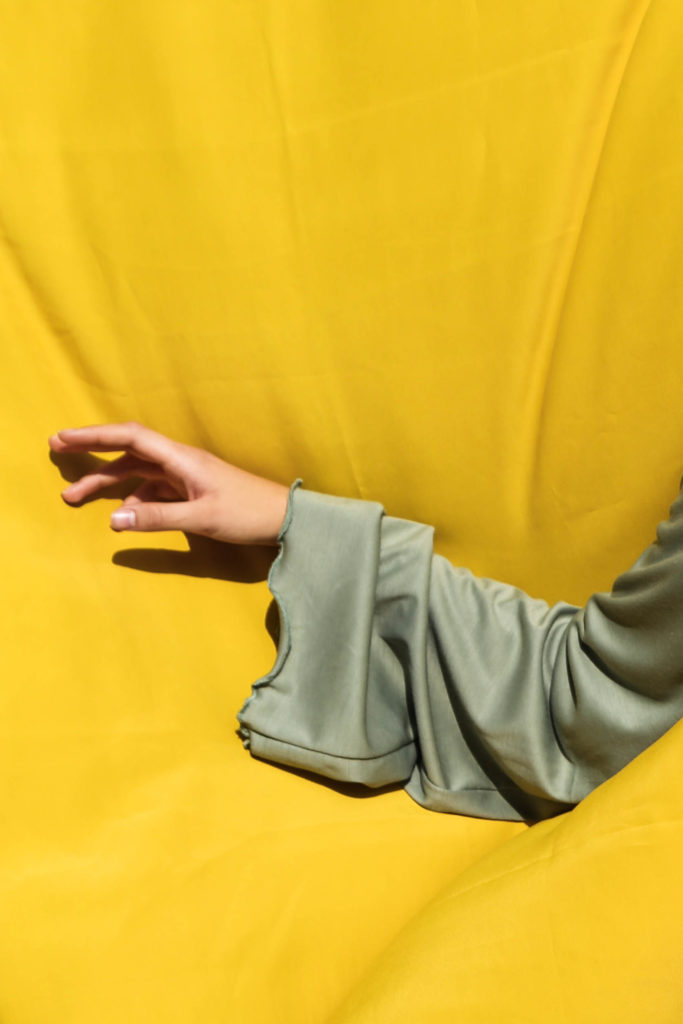
The dilemma of fitting in and standing out is not only a side issue in historical and contemporary design. To me, it is the leading question of the ever changing and cyclically renewing developments in art and fashion, which are characterized by the two basic needs of human creations: the love for decoration and the desire for abstraction.
For the creation of a collection on the fine line between decorative and minimalist, this means understanding the role of both elements throughout different cultures and times as well as finding a personal stance in this discussion.
In this context, the ornament has become the epitome of the conflict between these needs for me.
I was searching for new ways of working with the idea of decoration in order to reconcile it with minimalism. I did this by developing different techniques of fabric manipulation. Inspired by 18th century rococo, I used industrial-strength ropes, clear plastic tubes and full-body-length fringes coated in foaming pastes as analogies to traditional surface embellishments and body-forming elements of the time. The cut of the clothes, however, is strongly influenced by minimalist fashions of the 20th century.
Many garments are finished with graphic prints, which I have digitally derived from the same effect that moiré fabrics use, which have been widely used in historic fashions, such as in rococo, but they have always been the most minimalistic décor, compared to other ornamented surfaces.
The overall appearance of my garments is strongly influenced by the contrast of rough surfaces and raw-edges and geometrical and clear forms. This is another layer of the dialogue between ornament and minimalism in this collection.
My goal was to design a collection that knows and respects the wish to fit in, but attempts to look beyond it. As it sometimes seemed to me that decoration has become even vulgar in urban contexts to some, I strived to find a new form for the ornament. One that serves the needs of both reduction and decoration. Therefore the ornamented surfaces in my collection are mostly done in one sustaining color per garment. They are not merely add-ons to the fabrics, but worked in or out of the fabric, always as a part of the fabric itself.
However, this does not mean in any way that my work is about moving oneself into the center of attention or feeling above everyone else by means of fashionable gestures. Rather this collection is about conveying a sense of new bravery and self-confidence to withdraw from the fear of standing out and to re-discover the possibility of performing identity through fashion in the urban millieu.
After all, my work is about gaining more joy from creating something, than from rejecting it. It is about rediscovering design as a means of perception of our surrounding. But most of all it is about admitting that we are not without needs, but rather that our desires should also be shown outwardly.
Lehrende: Prof. Waldemar (Wowo) Kraus // Prof. Dr. Ingeborg Harms // KM Evelyn Sitter
Fashion & Concept: Pia Marietta Hintz, Fotos: Anna Niemann, H&M: Manuel NIederbrugger, Models: Laura (@ Mirrs Models) // Maria (@ VIVA Models)
Pia Marietta Hintz // Martin Luther Straße 113 // 10825 Berlin // 017643605933

The project has a starting point in exploring knitted structures and their combinations. The material comes first, letting it decide the form and connections of the garment. A combination of material and form, with the attempt to develop the silhouettes through the method of assemblage.
Putting the process itself in focus, questioning my usual approach of working to get an open field to explore new ways in combining material and form by focusing more consciously on the interaction of material, form and body.
Betreut von: Prof. Jozef LeGrand // Gast-Prof. Carolin Lerch // KM Magdalena Kohler
Fashion & Concept: Ronja Kösters, Fotos: Nikita Fishman, Model: Amra, H&M: Nicholas Senenio
Mit Essen Essen | Masterarbeit 2018
ISSO ist eine Reihe an essbaren Schalen, Teller, Gläser und Utensilien aus getrocknetem Obst- und Gemüsemus, die Teil der Mahlzeiten werden. Mit Essen essen, also quasi mit den Händen essen, ohne mit den Händen zu essen. Das bedeutet, man macht die Schalen zu einem Teil der Zeremonie und isst sie mit der Speise mit – nach der Mahlzeit bleibt also nichts zurück. ISSO gibt es in verschiedenen Ausführungen und Größen, je nachdem wie groß eine Speise sein soll. Dabei ist die geschmackliche Komponente der Schalen ebenso wichtig wie ihre Form. ISSO ist sowohl physischer Träger der Speisen, als auch geschmacklicher Teil einer Komposition. So könnte die Currywurst in einer Schale aus getrocknetem Curryketchup serviert werden an der Imbissbude um die Ecke und nicht wie sonst auf Wegwerfgeschirr aus Pappe oder Plastik.
Die Papiermuffinförmchen, die man sowohl in privaten Haushalten als auch in Bäckereien benutzt, könnten mit Obstmuffinförmchen ersetzt werden. Sie würden genauso wie ihre Papier-Vorgänger befüllt und mitgebacken. Statt sie vor dem Verzehr zu entfernen, isst man sie dann einfach mit. Man kann damit mit den Händen essen, ohne dass man sich davor ekelt und dabei entsteht noch nicht einmal Abfall. Man könnte es als eine Art interkulturelles Besteck bezeichnen, das verschiedene Kulturen miteinander verbindet. Es ist eine Verbindung aus Besteck und nicht Besteck, daraus mit einem Löffel und mit den Händen zu essen. Es ist beides in einem, ohne Angst davor haben zu müssen die Speisen anzufassen – obwohl man es eben doch tut.
ISSO is a series of eatable bowls, plates, cups and cutlery, made of dried fruits and vegetables, that become part of a meal. Eating with food, means to eat with your hands, but at the same time eat without using them. You make the utensils and plates part of the ceremony, eat them with your meal and in the end nothing is left. You can get ISSO in many different types and sizes, depending on how big your meal should be. But the taste is as important as the shape.
ISSO is a physical carrier of the food as well as a tasteful component of a meal. Imagine the Currywurst being served in a bowl made of dried curry ketchup instead of plates which would be thrown away right after. The paper baking dish for muffins could be replaced by eatable fruit baking dishes, that would be eaten together with the muffin after baking. You can eat with your hands without being irritated by it. And the best part, there is no trash afterwards. You could see it as kind of a cutlery which brings together different cultures.
ISSO is a fusion of cutlery and no cutlery, of eating with a spoon and eating with your hands. It is both at the same time, without having the fear of touching food – although your doing it.
Prozess
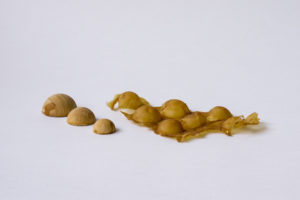
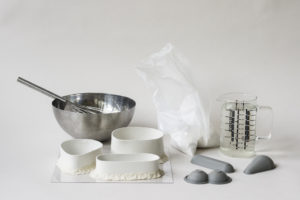
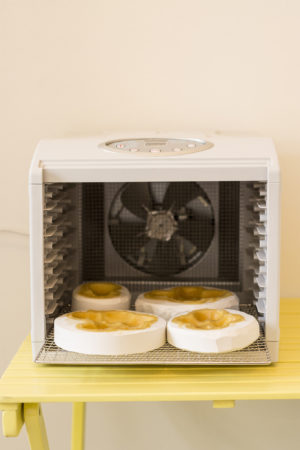

Betreuer
Prof. Burkhard Schmitz, KM Antonia Kühne
Wanderer | Masterarbeit 2018
Im Unterschied zu industriell hergestelltem Joghurt, einer natürlich bereits fertig fermentierten Charge der Sauermilch, kann diese auch zu Neuem angesetzt werden. Diese Charge nennt man „Starter Kultur”. Bei meiner Suche nach unterschiedlichen Arten von Sauermilch in der ganzen Welt, faszinierte mich vor allem die Form des „Speichers“ oder „Behälters” der Kulturen: Baumwolle, Taschentücher oder sogar Textilien. Die Transformierung einer Aufbewahrungsform der Kulturen erlaubt ein Aufheben sowohl von Zeit als auch von Raum; eine Erweiterung ihrer Lebenskraft und ihres Lebensumfeldes.
Inspiriert davon trage ich die Sauermilch, die als Starter-Kultur für einen neuen Produktionszyklus wieder benutzt werden kann, in bestimmten Formen auf Stoffe auf. Die Formen werden als Grafik oder Ornamente präsentiert, welche die beinhalteten Bakterien visualisieren. Der in Quadrate eingeteilte Stoff wird als Einheit für den Kultur-Speicher gemessen, den man leicht abschneiden und daraufhin wieder als Starter-Plattform für neue Sauermilch benutzen kann.
In contrast to industrially produced yoghurt, a naturally fermented batch of sour milk could also be prepared for producing new sour milk. This batch is called „starter culture“. During my search for different types of sour milk from all over the world, I was particularly fascinated by the form of the „storage“ or „container“ of the cultures: cotton, handkerchiefs or even textiles. The transformation of a preservation form of the cultures broke the limitation both of time and space, while the varieties of preservation’s form could be considered as extension of the culture’s vitality and their living range.
Inspired by it I carry the sour milk, which is as a starter culture for a new production cycle reusable, in certain forms on textiles. The shapes are presented as graphics or ornaments that visualize the bacteria involved in the fermenting process. The squares are measured as a unit for the culture storage, which can easily be cut off and used again as a starter platform for new sour milk.
Prozess
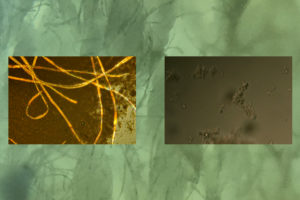
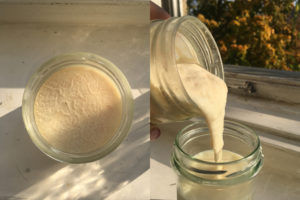
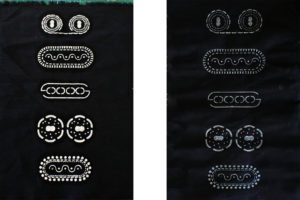
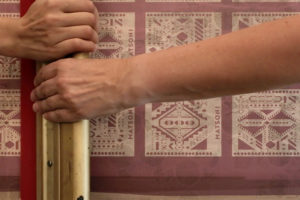
Kontakt
Betreuer
Prof. Axel Kufus, KM Johanna Schmeer
Erlebnis der unbegreiflichen Dinge | Masterarbeit 2018
ALPHABETUM TACTUS
Touch is our first language, the first sense that we acquire. Touch is our silent interface with the material world. Touch is the third dimension of surface that speaks to our emotions.
People who are deaf-blind communicate through touch-based processes, from finger spelling to exploring objects with their hands or feet. Some people who are deaf-blind use a grammar of touch that includes pressure, location, speed, hand shape and motion.
Alphabetum Taktus is the suggestion of a new kind of sensory 3D alphabet. This new haptic font allows blind and sighted people to communicate with each other in a playful way.
LITTERAE ODORUM
All the senses have their own descriptive vocabularies, for example for sight, there is red, green, and yellow, and for taste there is sweet and sour, etc. But the sense of smell can have no descriptive vocabulary of its own. Rather, we borrow our adjectives from the other senses, so that it smells sour, or has a smell like roses, cloves or musk. They are all, however, terms drawn from other senses. Consequently, we cannot describe our sense of smell. Until now:
Litterae odorum are the first characters from the olfactory alphabet, which consists of 350 letters (olfactory receptors in the nose). Quick learning of the new language is possible by the synesthetic experience.
Prozess
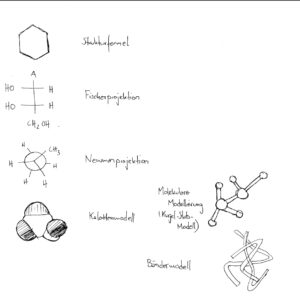


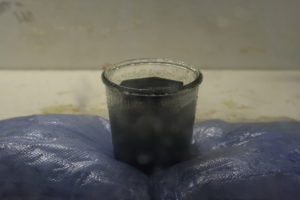
Kontakt
Betreuer
Prof. Dr. Ingeborg Harms, KM Johanna Schmeer
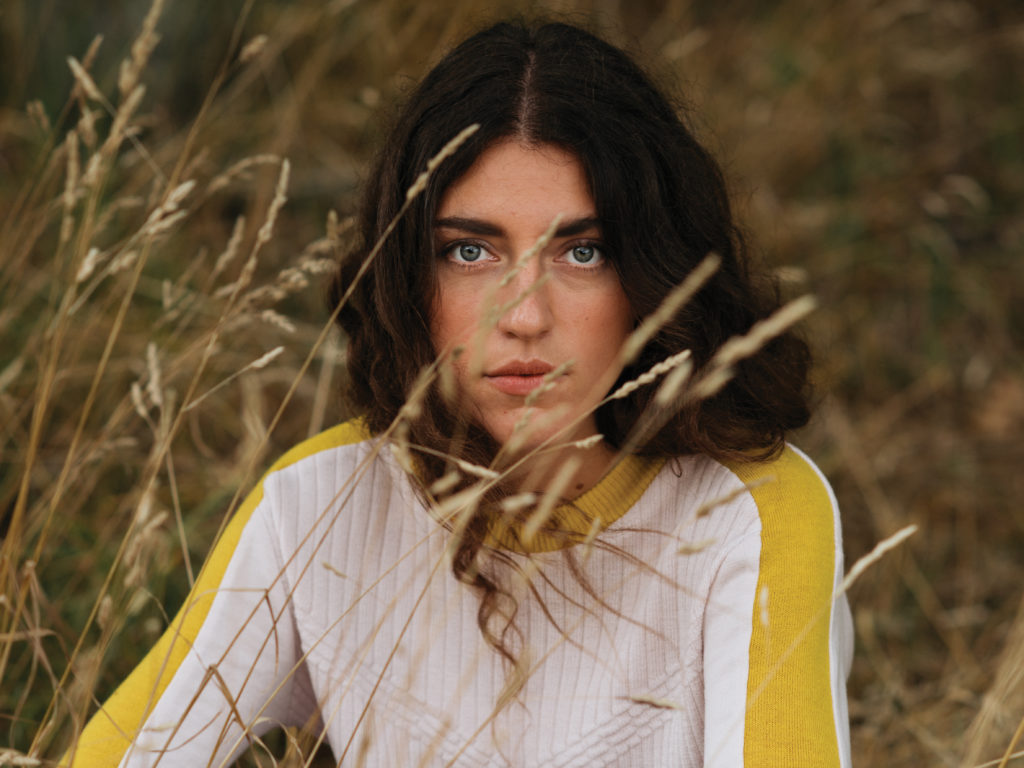
I want to own less clothes and wear them more often. I want to wear my hiking clothes to get coffee. I want to wear my casual best in the mountains. I want to wear my favourite sweatshirt everywhere. I want my clothes to be soft, comfortable, stylish, functional and good for the environment.
A collection of hiking garments which don’t look out of place in the city. Owning less clothes and wearing them more often, aiming to reduce consumerism. Researching wool as a versatile, sustainable material. Creating elegant sportswear.
Betreut von: Prof. Valeska Schmidt-Thomsen // KM Evelyn Sitter
Fashion & Concept: Megan Grace Ashton, Fotos: Antony Sojka, Model: Sarah Sekles, H&M: Gianna Gooss
MASTERING THE MOLD | Bachelorarbeit 2018
“Mastering the Mold” is combining digital and analog mold making. The Master Molds are designed in a way that speed up the creation of plaster molds. By digitizing the mold making process it can speed up the production of ceramics, create opportunities to easily outsource ceramic production and to make ceramics open source. Within the project “Mastering the Mold” two products were created, Pot & Box. The Master Molds of Box were CNC milled and create a stackable pattern on the outside.
When Box stands tall it takes the form of a stool, used for sitting although when turned horizontal it takes the form of a planter box and can be stacked, used as a vertical gardening system. The Master Molds of Pot are made with a 3D printer. This modular mold system creates different combinations of objects casted out of the same molds. Pots aesthetic reflect its unique processes.
Prozess

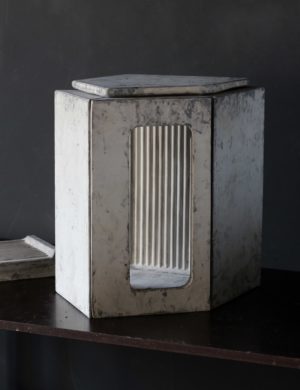

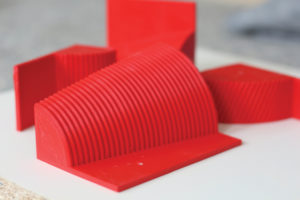
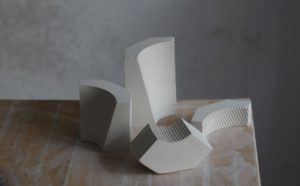
Kontakt
www.laureannekootstra.com
Betreuer
Prof. Ineke Hans, Prof. Jozef Legrand, Uta Koloczek
CRYPTOCISE | Bachelorarbeit 2018
CRYPTOCISE ist eine Reihe von Objekten, die dem Benutzer helfen, seine physische Identität zu verschleiern, während er von Daten sammelnden Geräten umgeben ist. Die Objekte sollen zum Kampf gegen den Datensammelapparatus beitragen, indem sie es ermöglichen am Alltag teilzunehmen ohne vor einer technologisierten Welt kapitulieren zu müssen.
CRYPTOCISE ist eine Serie von Widerstandswerkzeugen. Die Serie besteht aus drei Objekten: NO.SIGNAL, PIXELMASKE und NICHT. VERSTANDEN.
NO SIGNAL ist eine Aluminium-beschichtete PVC Tasche für ein Mobiltelefon, die das Signal blockiert und so die Ortung des Geräts verhindert. So wird es dem Benutzer ermöglicht, sein Telefon mit sich zu tragen und nicht geortet zu werden, solange das Telefon nicht benutzt wird.
PIXELMASKE ist eine 3D-gedruckte Maske zur Beschränkung der Gesichtserkennung, die einen Pixel-Digitalfilter simuliert.
NICHT. VERSTANDEN ist ein Rahmen aus Silber, der in den Mund gelegt wird, um die Spracherkennung durch Geräte zu stören, die mit Sprachbefehl bedient werden können und permanent zuhören. Für jedes Objekt gibt es eine DIY-Version, die von jedem selbst hergestellt werden kann.
CRYPTOCISE is a series of objects that helps the user to encrypt their physical identity while surrounded by data collecting devices. These objects are made to contribute to the battle against the data collecting apparatus by trying to enable taking part in the everyday life without complete capitulation.
CRYPTOCISE is a series of resistances tools. The series is made out of three objects: NO.SIGNAL, PIXEL.MASK and DONT.GET.IT.
NO.SIGNAL is a Aluminum plated PVC case for a mobile phone that blocks its signal and disables its location tracking. It enables its user to carry their phone with them and not be tracked when they are not using their phone.
PIXEL.MASK is a 3D printed mask for the limitation of facial recognition that simulates a pixeled digital filter.
DONT.GET.IT is a silver frame to place in the mouth to disturb speech recognition by devices that are used with voice command and are permanently listening. There is a DIY Version for each object, that can be made be anyone.
Betreuer
Prof. Axel Kufus, Prof. Dr. Kathrin Busch, KM Johanna Schmeer
Inspired by my grandfather’s way of clothing, the tailoring of the Savile Row, the lifestyle of a Sapeur, the appeal of neon colors and daily impressions of living in the metropole Berlin with its city lights, roadworks, creativity, artists and graphical elements surrounding, the uniting of diverse influences into one collection became my main instrument. Unusual material combinations like the punctual use of neon colors on tweed provoking the effect of an electric glow, creating uniqueness and giving back value to the garment itself. The collection became a very personal reflection of myself, my interests, my preferences and experiences – a Karambolage.
Betreut von: Prof. Valeska Schmidt-Thomsen // Prof. Wowo (Waldemar) Kraus // Prof. Dr. Ingeborg Harms
Antonia Schreiter’s Abschlusskollektion wurde im Juli 2018 im Rahmen der MITTELMODA FASHION AWARDS mit dem Preis ‚Most Creative Collection‘ ausgezeichnet. Sie konnte sich unter anderem für das Halbfinale der H&M Design Awards 2019 qualifizieren.
Credits:
Lookbook Shooting: Fotos: Nicole Doberstein, Model: Patrick Kurth
Fleamarket Shooting: Fotos: Thijsiena Marx, Model: Jordan Vandertoorn
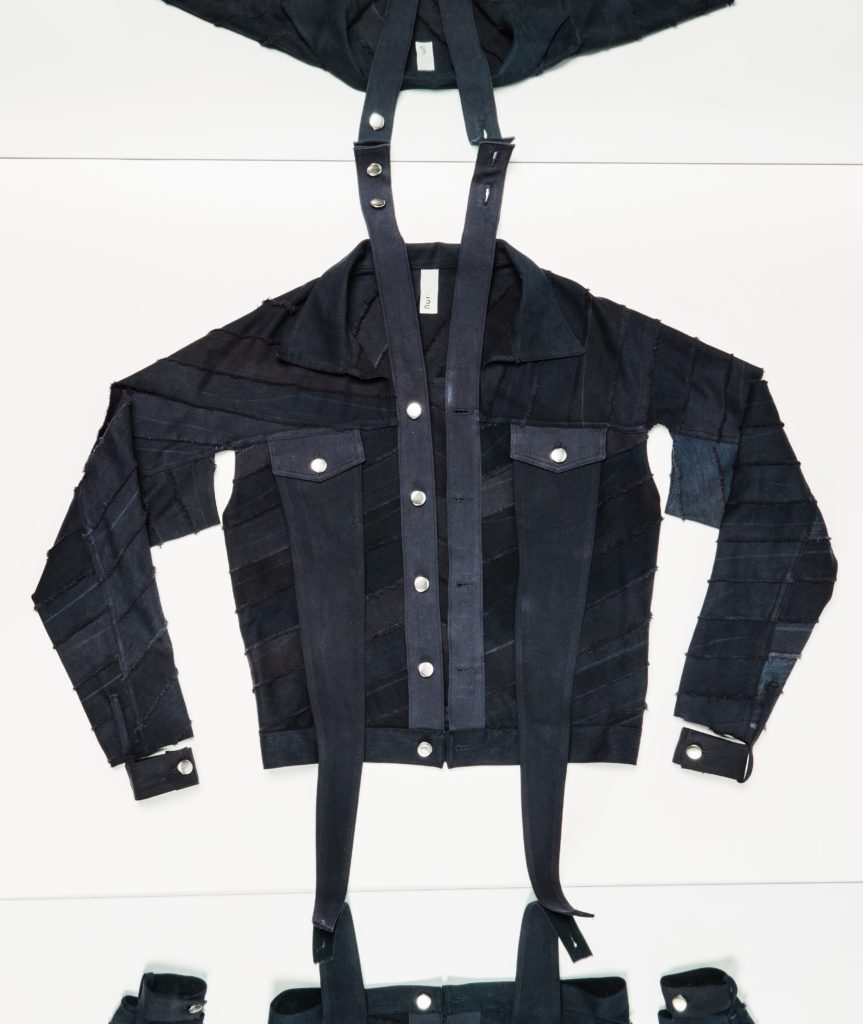
The bachelor thesis >customizable< deals with the question of sustainability in the fashion industry. The work was based on the personal thesis that garments in their known form are subject to a rigidity that conflicts with the human desire for individualization. To design clothes that will be worn for a long time, this rigidity has to be made more flexible. Clothes should be alterable and adaptable to the continuously changing wearer. Based on this thesis ten forms of clothing were developed in women and menswear, which allow different wearing options through flexible connections. In line with the concept of sustainability, the garments have been created in a complex upcycling process that enables the reproduction of the collection and completely overhauls the aesthetics of old clothes.
Betreut von: Prof. Wowo (Waldemar) Kraus // Gast-Prof. Carolin Lerch
Fashion, Concept & Camera: Anna-Luise Sinning, Special thanks to: Phuong Ahn Le // Nikolaus Brade
Me and Margarethe | MASTER 2018
My MA collection is an ode to the danish Queen, Her Majesty Margrethe II of Denmark. Taking her as a muse and translating her world into a men’s collection, I create a world that thrives only on personal admiration. A daydream, where the two of us have a lot in common.
As a child I wanted to become Queen one day. Now I’m grown up. The fascination for the world of Margrethe II still lingers in me, I can’t help it. I admire the beautiful order, the ceremonial clothing, the matching outfits, which all underline one thing: festivity – in my opinion we’ve mostly lost that in our everyday lives. Putting an effort into what you wear really becomes visible if everything matches. The total look to me screams of festivity, everything is thought trough, planned ahead, set in place.
I wanted to create a symbiosis of the Queen’s universe and my own one. A festive collection for young men. But opposed to aspects like gender-bending or drag, I wanted to define the limits of my own femininity, not loosing the masculine side of things. Personally, I would feel uncomfortable in a dress, it would feel like a masquerade to me. I did not try to blur the lines of sexes – rather pointing them out – I like masculinity and I admire femininity, I wouldn’t want to give any of them up. One of the most important aspects of my collection and the main reason why I admire Margrethe II. of Denmark, is the renewal of old craftsmanship and tradition. I think monarchy is still relevant today, because it holds up culture, art and craft. The danish Queen combines old traditions with her own modern taste and thereby helps keeping rare crafts alive, and making them visible to the public.
Kontakt:
Instagram: momme_ostendorf
Stand by | 2013 | Diplomarbeit Produktdesign
Das Klappmesser klappt, das Schlauchboot ist ein Schlauch und das Wurfzelt wird geworfen. Unsere Benennung dieser Produk- te legt einen klaren Fokus auf ihre Identität und reduziert sie auf ihre Matarialität bzw. ihre Funktionsweise. Aber was verbindet sie? Solche Produkte, die auf eine temporäre Nutzung angelegt sind und zwischen ihrem Funktions- und ihrem Ruhezustand die Form verändern, haben eine zentrale Gemeinsamkeit, die wir sprachlich bisher nicht fassen: sie sind in Bereitschaft, auf stand-by.
STANDBY ist ein Klappstuhl, der im Geiste von Knirps, Springmesser und Chapeau-Claque mit einer Hand entfaltet werden kann. Im zusammengeklappten Zustand kann er sich frei stehend in die Wohnlandschaft integrieren und seine Potentialität anbieten.
Flexibilität, Mobilität und Verfügbarkeit als prägende Schlagworte unseres heutigen Zeitgeists werden in einem klassischen Produkt zum Ausdruck gebracht.
BETREUER
PROF Axel Kufus | Prof. Holger Neumann | Prof. Dr. Walter Scheiffele
Photos: Hannes Geipel